

Johns Hopkins University (JHU) continues to pad its space community résumé with their interactive map, “The map of the observable Universe”, that takes viewers on a 13.7-billion-year-old tour of the cosmos from the present to the moments after the Big Bang. While JHU is responsible for creating the site, additional contributions were made by NASA, the European Space Agency, the National Science Foundation, and the Sloan Foundation.
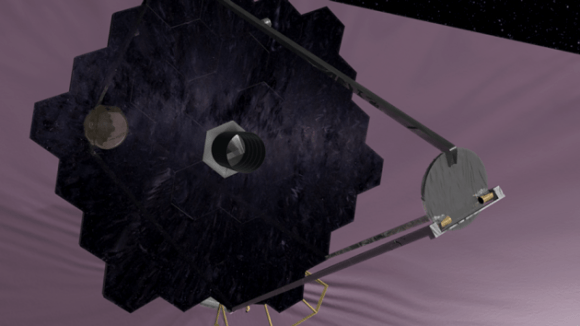
An Artist’s conception of the proposed High-Definition Space Telescope,
which would have a giant segmented mirror and unprecedented resolution at optical and UV wavelengths.
CREDIT: (NASA/GSFC)
Published on Nov 13, 2015 LISA Pathfinder will pave the way for future missions by testing in flight the very concept of gravitational wave detection:
it will put two test masses in a near-perfect gravitational free-fall and control and measure their motion with unprecedented accuracy.
LISA Pathfinder will use the latest technology to minimise the extra forces on the test masses, and to take measurements.
The inertial sensors, the laser metrology system, the drag-free control system and an ultra-precise micro-propulsion system
make this a highly unusual mission.
LISA Pathfinder is an ESA mission, which will also carry a NASA payload. Category Science & Technology License Standard YouTube License
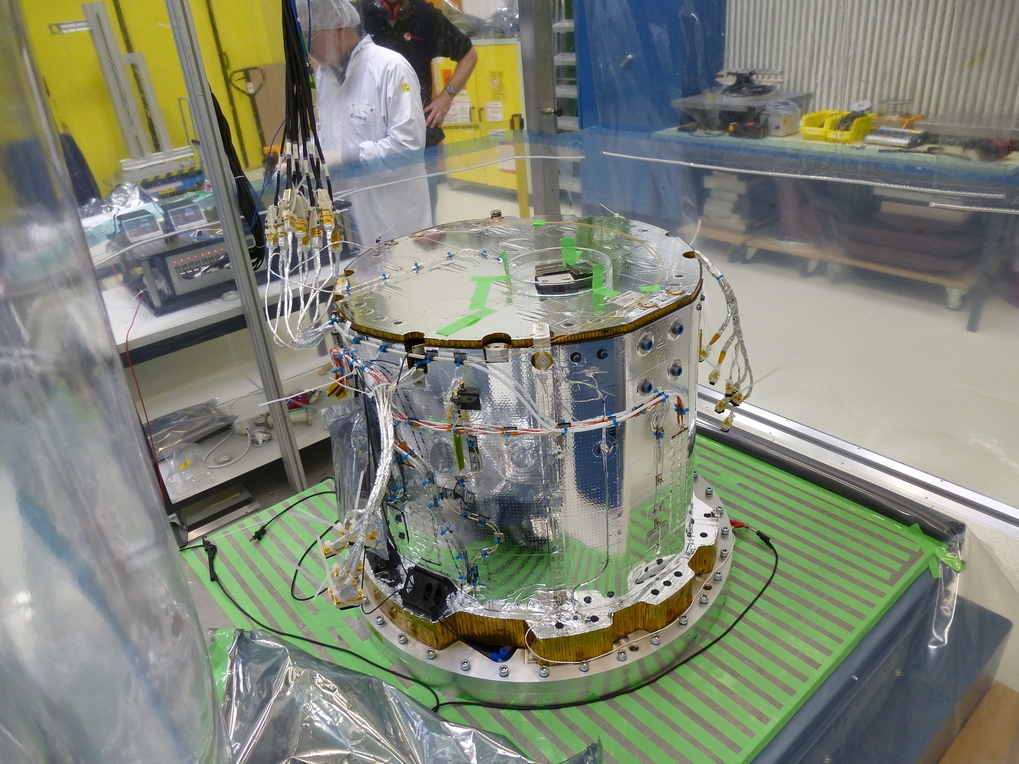
Listening to the 'sound' of the #Universe – highly sensitive core of LISA Pathfinder completed
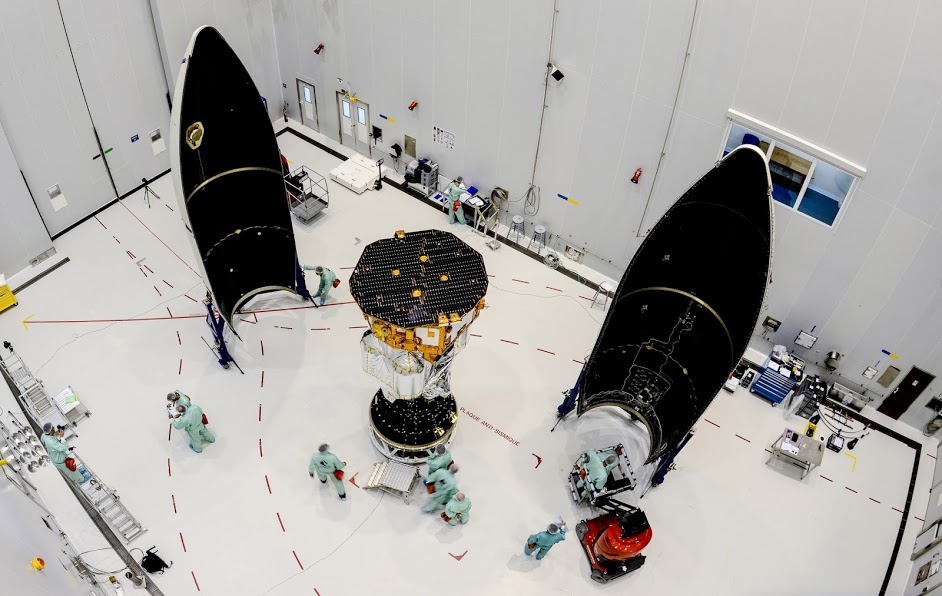
LISA Pathfinder is being encapsulated within the half-shells of the Vega rocket fairing on November 16, 2015, at the Centre Spatial Guyanais in Kourou, French Guiana. LISA Pathfinder will test the fundamental technologies and instrumentation needed for such an observatory, demonstrating them for the first time in space. LISA Pathfinder is currently scheduled for launch with Arianespace flight VV06—the sixth launch of Europe's small Vega ...
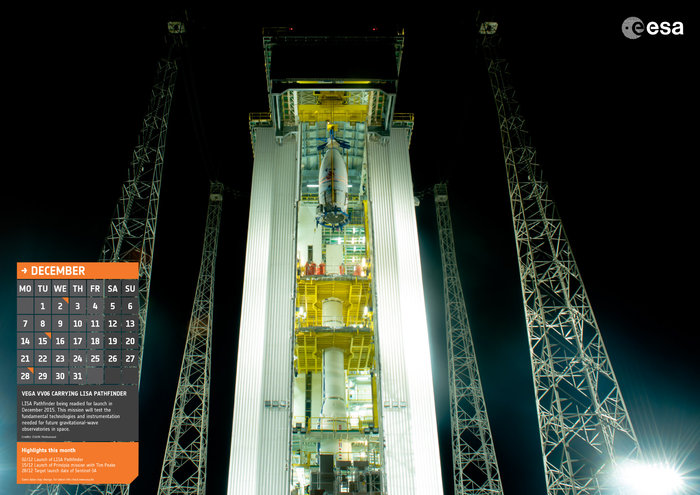
LISA Pathfinder being readied for launch in December 2015. This mission will test the fundamental technologies
and instrumentation needed for future gravitational-wave observatories in space.
by NANCY ATKINSON on DECEMBER 3, 2015
Published on Dec 2, 2015 Liftoff of Vega VV06 carrying LISA Pathfinder from Europe's Spaceport, French Guiana, at 04:04 GMT/05:04 CET on 3 December 2015.
Published on Nov 13, 2015 LISA Pathfinder will pave the way for future missions by testing in flight the very concept of gravitational wave detection:
it will put two test masses in a near-perfect gravitational free-fall and control and measure their motion with unprecedented accuracy.
LISA Pathfinder will use the latest technology to minimise the extra forces on the test masses, and to take measurements.
The inertial sensors, the laser metrology system, the drag-free control system and an ultra-precise micro-propulsion system make
this a highly unusual mission. LISA Pathfinder is an ESA mission, which will also carry a NASA payload. Category Science & Technology License Standard YouTube License
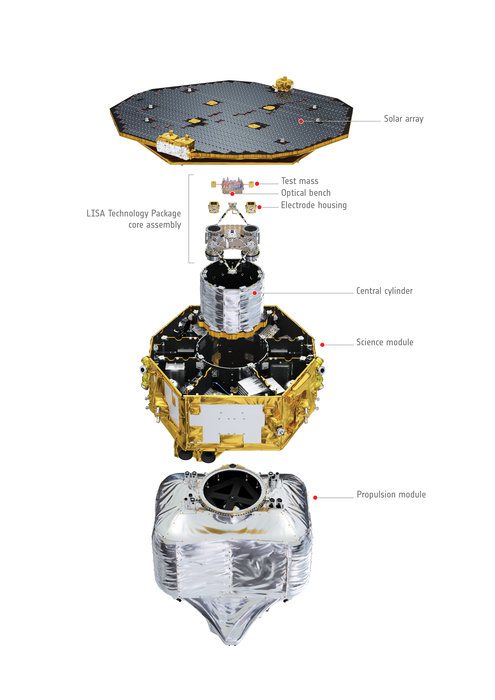
This exploded view shows the LISA Pathfinder spacecraft in its entirety. The white- and gold-hued science module carries
the payload with the test masses and their electrode housings, the optical bench interferometer, and vacuum enclosure.
Credit: ESA/ATG medialab.


First LISA Pathfinder test mass released inside its housing. 2nd planned for tomorrow.(Feb.,16, 2016)
Published on Nov 25, 2015 LISA Pathfinder’s name, Laser Interferometer Space Antenna, clearly indicates the role of precursor
that this mission plays. Its goal is to validate the technology required to detect gravitational waves from space.
Gravitational waves will open a new door in our understanding of the Universe, and at the same time help to verify
Einstein’s General Theory of Relativity. LISA Pathfinder will be launched early December 2015 on a Vega rocket from Kourou in French Guiana. Category Science & Technology License Standard YouTube License

Artist's impression of two merging black holes, which has been theorized to be a source of gravitational waves. Credit: Bohn, Throwe, Hébert, Henriksson, Bunandar, Taylor, Scheel/SXS
Lisa Pathfinder's trip to orbit
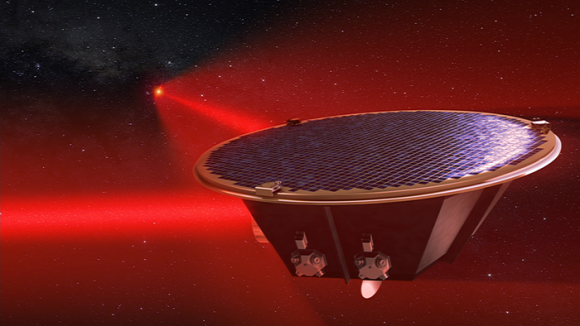
Artist’s concept of the LISA mission. Credit: AEI/Milde Marketing/Exozet
Published on Feb 11, 2016 A computer simulation shows the collision of two black holes, a tremendously powerful event detected for the first time ever by the Laser Interferometer Gravitational-Wave Observatory, or LIGO. LIGO detected gravitational waves, or ripples in space and time generated as the black holes spiraled in toward each other, collided, and merged. This simulation shows how the merger would appear to our eyes if we could somehow travel in a spaceship for a closer look. It was created by solving equations from Albert Einstein's general theory of relativity using the LIGO data. The two merging black holes are each roughly 30 times the mass of the sun, with one slightly larger than the other. Time has been slowed down by a factor of about 100. The event took place 1.3 billion years ago. The stars appear warped due to the incredibly strong gravity of the black holes. The black holes warp space and time, and this causes light from the stars to curve around the black holes in a process called gravitational lensing. The ring around the black holes, known as an Einstein ring, arises from the light of all the stars in a small region behind the holes, where gravitational lensing has smeared their images into a ring. The gravitational waves themselves would not be seen by a human near the black holes and so do not show in this video, with one important exception. The gravitational waves that are traveling outward toward the small region behind the black holes disturb that region’s stellar images in the Einstein ring, causing them to slosh around, even long after the collision. The gravitational waves traveling in other directions cause weaker, and shorter-lived sloshing, everywhere outside the ring. This simulation was created by the multi-university SXS (Simulating eXtreme Spacetimes) project. For more information, visit
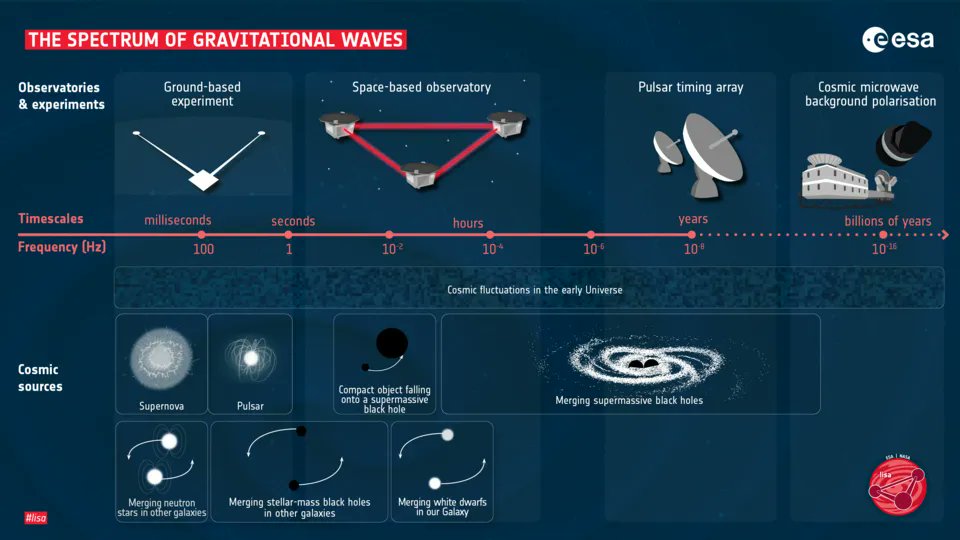
Timeline of gravitational imaging Credit – ESA
Jun 18, 2017 We’ve now had multiple detections of gravitational waves, opening up a whole new field: gravitational astronomy. We talk about the detections made so far, and how we can see the Universe in a whole new way. Follow us on Twitter: @universetoday Like us on Facebook: Instagram - Support us at:Support us at: Instagram - Team: Fraser Cain - @fcain / frasercain@gmail.com /Karla Thompson - @karlaii Chad Weber - Chloe Cain - Instagram: @chloegwen2001

The mission timeline for LISA – including the milestones it has to hit on its way to launch. Credit – ESA

Model of LISA’s optics system laid out on a benchtop. Credit – ESA / University of Glasgow
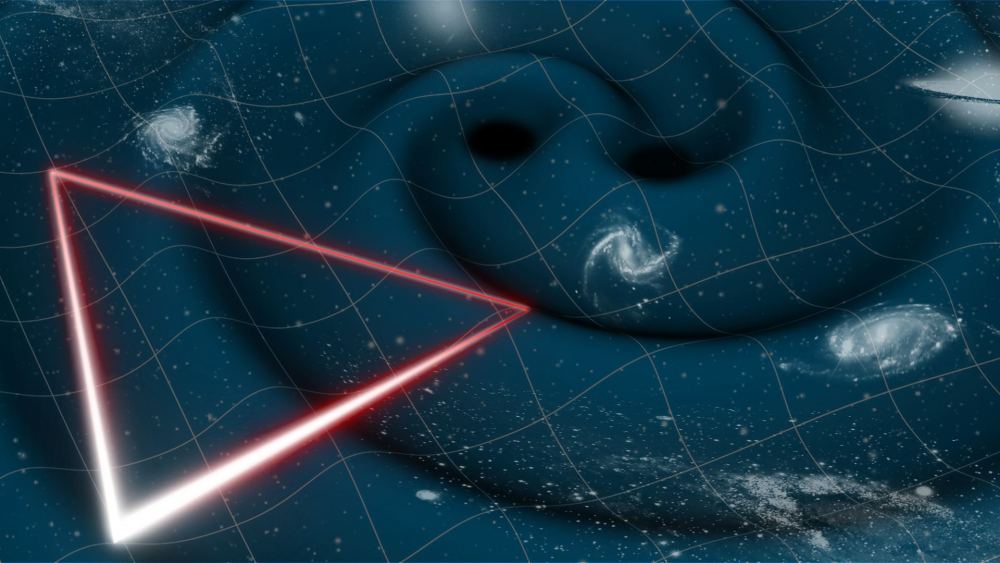
An artist's concept of how LISA will work to detect gravitational waves from orbit in space. Courtesy ESA
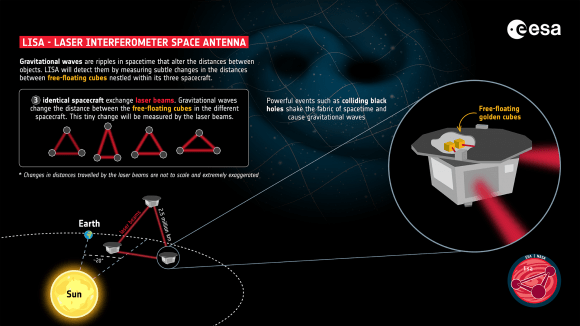
This graphic shows how LISA will work. Courtesy ESA
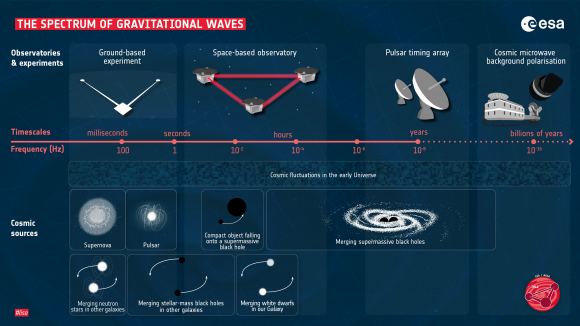
Sources of gravitational waves in the Universe that LISA will detect. Courtesy ESA
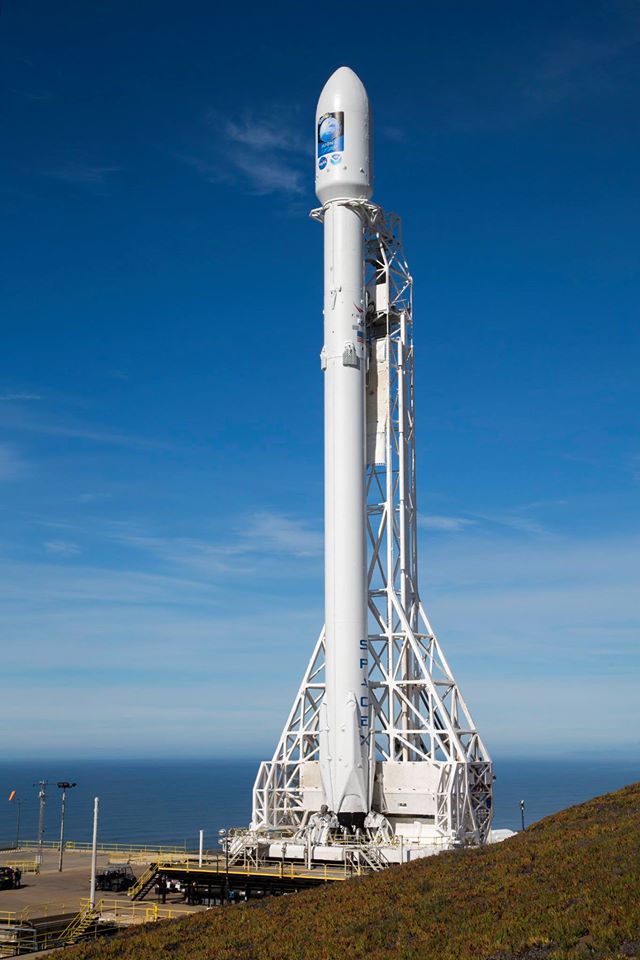
SpaceX Falcon 9 erected at Vandenberg AFB launch pad in California in advance of Jason-3 launch for NASA on Jan. 17, 2016.
Credit: SpaceX

The SpaceX Falcon 9 rocket is seen as it launches from Vandenberg Air Force Base Space Launch Complex 4 East
with the Jason-3 spacecraft onboard, Sunday, Jan. 17, 2016, Vandenberg Air Force Base, California. Jason-3,
an international mission led by the National Oceanic and Atmospheric Administration (NOAA), will help continue U.S.-European
satellite measurements of global ocean height changes.
Photo Credit: (NASA/Bill Ingalls)
Published on Jan 17, 2016 A SpaceX Falcon 9 rocket lifts off from Space Launch Complex 4 at Vandenberg Air Force Base carrying the Jason-3 spacecraft.
Liftoff was at 10:42 a.m. PST (1:42 p.m. EST). NASA launched Jason-3 into orbit for NOAA, the National Oceanic and Atmospheric Administration,
the French space agency and EUMETSAT, the European Organization for the Exploitation of Meteorological Satellites. Category Science & Technology License Standard YouTube License

SpaceX Falcon 9 First stage approaches center of landing droneship in Pacific Ocean. Credit: SpaceX

SpaceX Falcon 9 first stage tips over and explodes on Pacific ocean droneship after landing
leg fails to lock in place on Jan 17, 2016. Credit: SpaceX See landing video below

Remnants of Falcon 9 first stage after crash landing on barge at sea.
Landing leg failed to lock in place causing rocket to tip over and explode. Credit: SpaceX
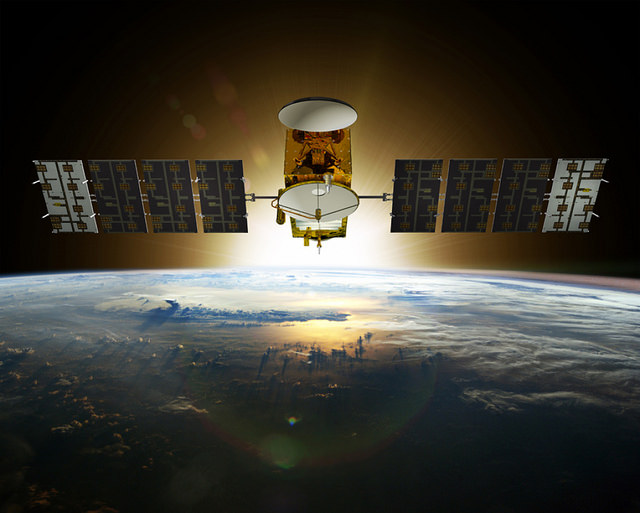
Artists concept of Jason-3 in orbit. Credit: NASA/NOAA
Published on Jan 15, 2016 To provide scientists with essential information about global and regional changes in the seas,
NASA will launch the Jason-3 satellite from Vandenberg Air Force Base in California. Category Science & Technology License Standard YouTube License
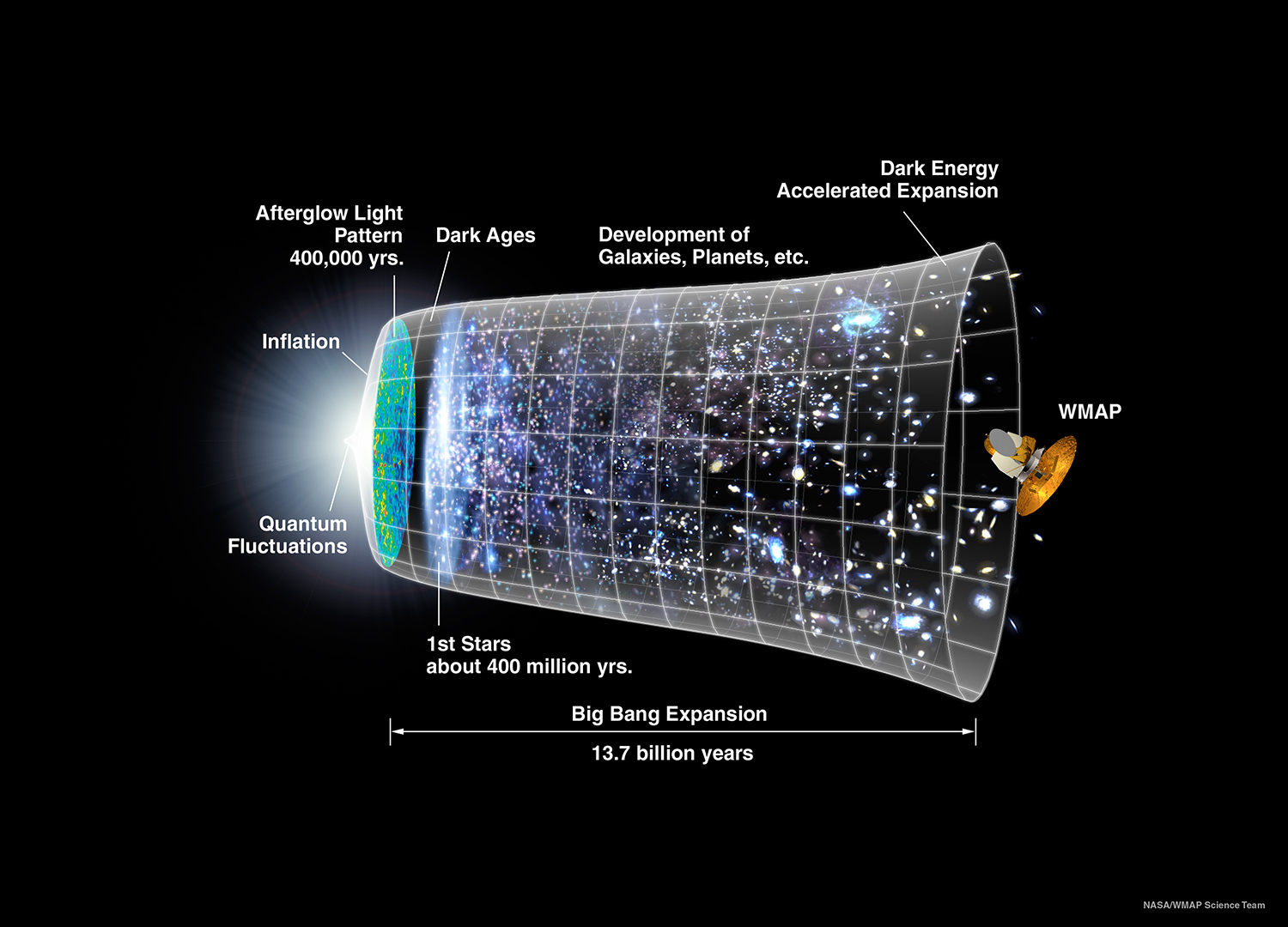
Subaru Telescope Spots Galaxies From The Early Universe by Matt Williams on November 21, 2014
Here is a web site for up to date virtual observations Visit the Virtual Planet
Visit the main site for the virtual planet Additional virtual planet stuff
Another Virtual Observatory It's Heavens Above.com
Here is nasa's Scientific Visualization Studio
This is NASA's Multi spectral Observatory The Virtual Observatory
This site specializes in introductory material Introduction to Planetary Nubulae
From this site you can explore the clementine Photos the establishment lets you view! The Clementine site
You can monitor Nasa's Lunar Prospector mission form here Lunar Prospector Exploration Site
From this site, you can explore the Solar System The Internet orrey
This site gives you views that Satellites have of the earth MilitarySatellite Earth observatory simulation
Space Telescope Institute The Hubble Space Telescope Institute
here is the Website for ESA's Hubble website
And this is ESA's Portal to the Universe!
Photos of Nebulae arranged by category A Hubble observation page
Hubble's latest photos The Hubble latest Photos
Observatories!
Introduction to Observatories!
Submit your own Observing request!!!! Bradford Robotic Telescope Observatory,
Another place to rent time on a telescope Arnie Rosner of Arizonia
This site for The X-ray observatory Chandra
Another online observatory is: It's Slooh.com!
Rent time for online observing, Light Buckets.com
Here is the link to Villanova University's Astronomy Department
The Astronomy Department at Villanova, Villanova, PA Villanova's Astronomy Department
The Cincinnati observatory
the Birthplace of american astronomy
See through the oldest public telescope in the country.
Web site The website of the world's largest telscope under construction
Click here for Northern Virgina's Sun gazer net
Click here for NSF-OPP Amundsen-Scott South Pole Station
Click here for DASI(Degree angular Scale Interferometer) Home Page
Click here for European Sothern Observatory"
Here is the web page for the Sub millimeter array main page
Here is: The soho OBSERVATORY main page

Here is the main page for Solar Dynamics Observatory
HERE IS the latest sdo/aia image:
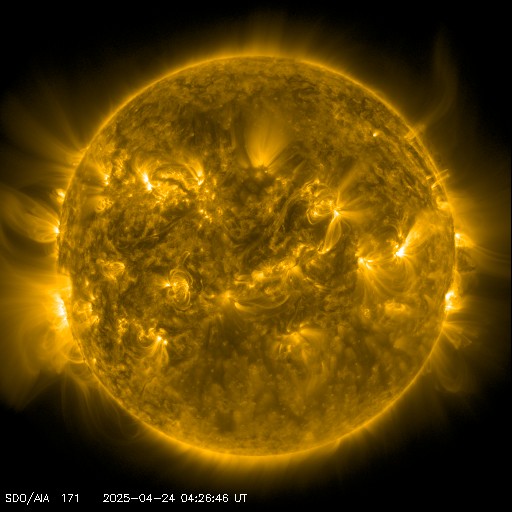
from Jordi Busque
A night in VLT and ALMA observatories (sound also recorded on location) from Jordi Busque on Vimeo.
The Very Large Telescope (VLT) consists of four individual telescopes, each with a primary mirror 8.2 m across and four movable Auxiliary Telescopes (ATs) of 1.8 m aperture. It is located on cerro Paranal (2635m), in northern Chile.
The Atacama Large Millimeter Array (ALMA) is the largest ground-based astronomical project consisting of 66 12-metre (39 ft), and 7-metre (23 ft) diameter radio telescopes. It is also the world's highest array of radio telescopes at 5,000 metres altitude in the Chajnantor plateau, northern Chile.
Images and sounds recorded on location by Jordi Busqué.
For more information, please visit www.jordibusque.com
The Very Large Telescope (VLT) consists of four individual telescopes, each with a primary mirror 8.2 m across
and four movable Auxiliary Telescopes (ATs) of 1.8 m aperture. It is located on cerro Paranal (2635m), in northern Chile.
The Atacama Large Millimeter Array (ALMA) is the largest ground-based astronomical project consisting of 66 12-metre (39 ft),
and 7-metre (23 ft) diameter radio telescopes. It is also the world's highest array of radio telescopes at 5,000 metres altitude
in the Chajnantor plateau, northern Chile.
Images and sounds recorded on location by Jordi Busqu�.
For more information, please visit jordibusque.com
by Elizabeth Howell on September 16, 2014
StarryNights - some of the largest observatories in time-lapse from Jan Hattenbach on Vimeo.
StarryNights is a collection of astronomical time-lapse videos recorded of the last three years.
From 2011 to 2014 we have been visiting astronomical observatories in Chile and La Palma - with our telescope and some cameras. This video features a compilation of our time-lapse videos we recorded.
The following observatories/telescopes appear in this video:
La Silla Observatory, ESO, Chile (3,6m ESO telescope, NTT telescope, MPG/ESO 2,2m telescope, Danish 1,54m telescope, among others)
Observatorio Roque de los Muchachos (ORM), La Palma, Spain (10,4m Gran Telescopo Canarias, NOT telescope, William Herschel 4,2m telescope, Liverpool telescope, Swedish 1m solar telescope, 17m MAGIC telescopes, among others)
Las Campanas Observatory, Chile (Magellan 6,5m twin telescopes, among others)
Paranal Observatory, ESO, Chile (Very Large Telescope, VST)
The time-lapses were a byproduct of our visual observing - because obviously, these sites are also the best in the world for visual observing and astrophotography. If you ever have the chance to spend a night at one of these observatories, consider yourself very lucky!
Thanks are due to following institutions for making this video possible:
European Southern Observatory (ESO)
Carnegie Institution for Science, Washington, USA
Instituto de Astrofísica de Canarias, Spain
We often speak of the discoveries and data flowing from astronomical observatories, which makes it easy to forget the cool factor.
Think of it � huge telescopes are probing the universe under crystal-clear skies, because astronomers need the dark skies to get their work done.
That�s what makes this astronomical video by Jan Hattenbach such a treat. He�s spent the past three years catching stunning video shots at observatories
all over the world, showing timelapses of the Milky Way galaxy and other celestial objects passing overhead.
The original site.... CLICK HERE!
And the New site.... CLICK HERE
This site for Skyview Virtual Observatory
Click here for Sungazer Comets
And here for The NSF Digital Sky
Here is the Hubble Space Institute's STSCI Digitized Sky Survey"
Here is the Hubble Institue's Hubble Heritage Institute
This is the site for the Keck Observatory On top of Mauna Kea!!
Thisis the plan to develop Mauna Kea in the Future CLICK HERE!
And here is Keck Observatory's Main page
Click here for Keck's Titan's page
Web cams at the Keck Observatory! CLICK HERE!
Here is The thiry meter telescope
Another observatory is The Griffith Observatory
Here is a famous observatory
Mt Wilson Observatory
And the view from their tower cam!
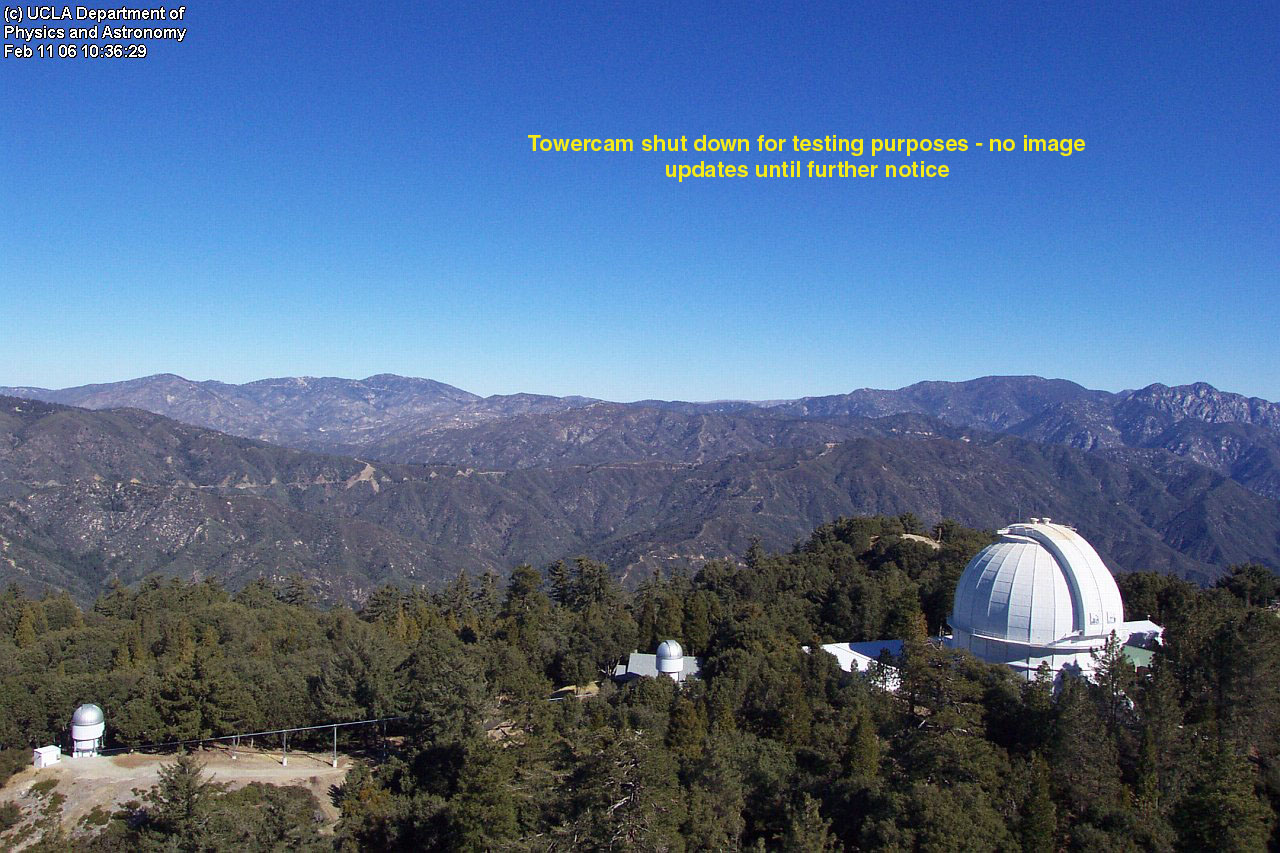
And here for The Jet propulsion Labortary
And here is an Astronomical Society Astronomical Society of the Desert
Here is LA astronomical society
And here is LA Sidewalk Astronomers
and here is Mt Wilson Obseravotry
Here is Virtual Tour Of Mt. Wilson Observatory
Another society is Orange County Astronomy
Submit your own observing request!!!!! U of Iowa Automated Telescope Obseratory
The Observatories from Alex Cherney on Vimeo.
The Observatories
from Alex Cherney Plus 1 week ago Not Yet Rated
in June 2011 I was very lucky to attend the inaugural STARMUS festival on Tenerife
and observe with the largest single-mirror optical telescope on the planet - 10-metre GranTeCan.
After spending five days at STARMUS listening to and chatting with the great astrophysicists and space legends
I decided to dedicate more time to astronomy science and film the observatories around the world.
This video, which was selected as the winner of the 2014 STARMUS astrophotography competition
(press announcement: tiny.cc/838tkx), is the result of over three years of work and includes the images of the following observatories:
* Roque De Los Muchachos Observatory, La Palma; * Australian Square Kilometre Array Pathfinder, Murchison, Australia; * Australia Telescope Compact Array, Narrarbri, Australia; * Parkes Radio Observatory, Australia; * Siding Spring Observatory, Australia; * Mount John Observatory, New Zealand Many thanks to Dermot Tutty for composing the original score for this video! Alex Cherney w: terrastro.com e: alex@terrastro.com
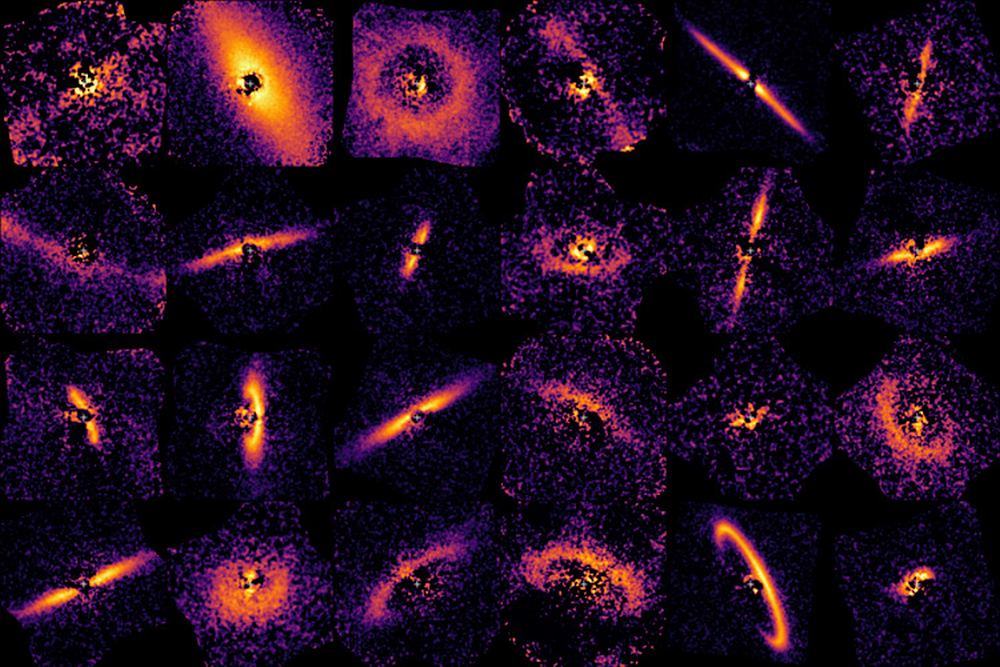
Over the next decade, several very powerful telescopes will come online. Observing time on these ‘scopes will be in high demand, and their range of targets will span a whole host of topics in astronomy, astrophysics, and cosomology. One of the topics near the top of the list is exoplanets.

Six of the 26 circumstellar disks from the Gemini Planet Imager survey, highlighting the diversity of shapes and sizes these disks can take and showing the outer reaches of star systems in their formative years. (Image by the International Gemini Observatory, NOIRLab, NSF, AURA and Tom Esposito, UC Berkeley. Image processing by Travis Recto, University of Alaska Anchorage, Mahdi Zamani and Davide de Martin.)
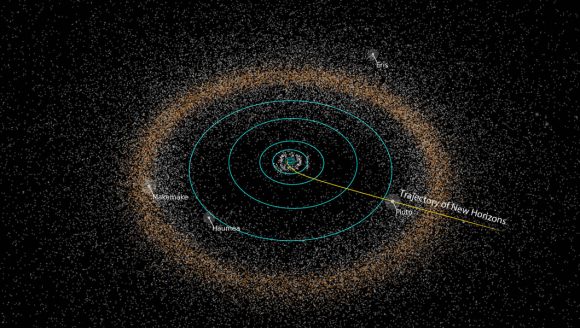
The Kuiper Belt was named in honor of Dutch-American astronomer Gerard Kuiper, who postulated a reservoir of icy bodies beyond Neptune. The first Kuiper Belt object was discovered in 1992. We now know of more than a thousand objects there, and it’s estimated it’s home to more than 100,000 asteroids and comets there over 62 miles (100 km) across. Credit: JHUAPL
Animation of the solar system and moving outward to indicate stars observed with the Gemini Planet Imager (GPI) mounted on the Gemini South telescope in Chile. Highlighted are the images of the dusty rings encircling some of these young stars. More than 100 researchers have contributed to GPI and the GPI Exoplanet Survey, whose work is highlighted in this video. The work was supported by the National Science Foundation (NSF) and NASA. NSF’s NOIRLab operates the international Gemini Observatory, which is a facility of the US, Canada, Chile, Brazil, Argentina and South Korea. Credit: International Gemini Observatory/ NOIRLab/NSF/AURA/J. Patience & R. Alling (Arizona State University)/T. Esposito (UC Berkeley).
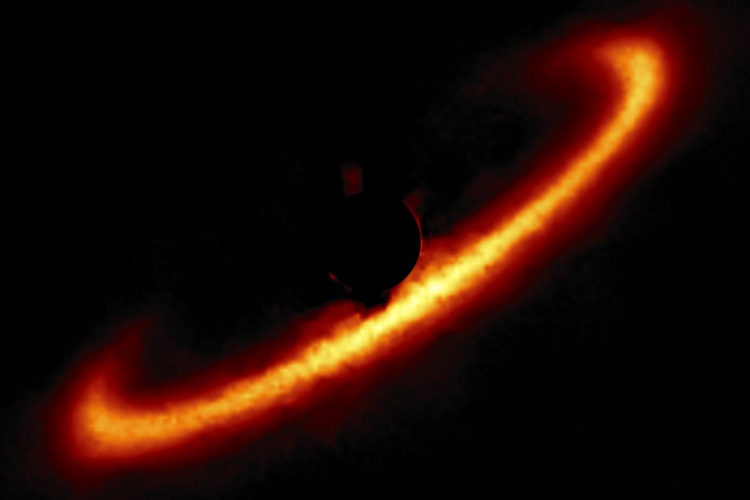
A ring of dust around the star HR 4796 A. Its neatly sculpted edges suggest the presence of a large planet that is sweeping up gas and dust inside the disk of icy, rocky debris, much the way Neptune sculpts the inner edge of our Kuiper Belt. (Image by the International Gemini Observatory, NOIRLab, NSF, AURA and Tom Esposito, UC Berkeley. Image processing by Travis Recto, University of Alaska Anchorage, Mahdi Zamani and Davide de Martin.)
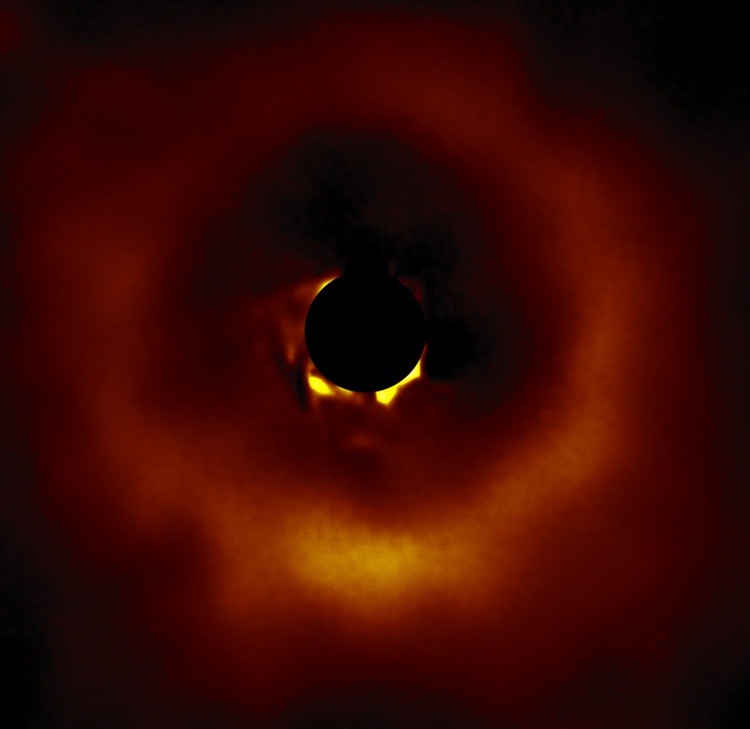
Circumstellar disk around star TWA 7, one of 26 disks observed by the Gemini Planet Imager. (Image by the International Gemini Observatory, NOIRLab, NSF, AURA and Tom Esposito, UC Berkeley. Image processing by Travis Recto, University of Alaska Anchorage, Mahdi Zamani and Davide de Martin.)
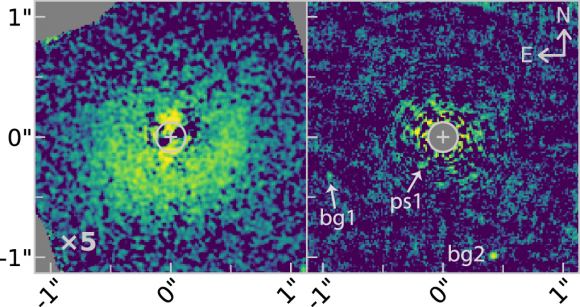
This is an image of the very young star HD 156623 and its disk. The researchers found no evidence of a hole in the disk, which would signal the presence of a planet if it were there. PS1 and bg1 and bg2 are point sources and background objects that aren’t a part of the disk. Image Credit: Esposito et al, 2020.
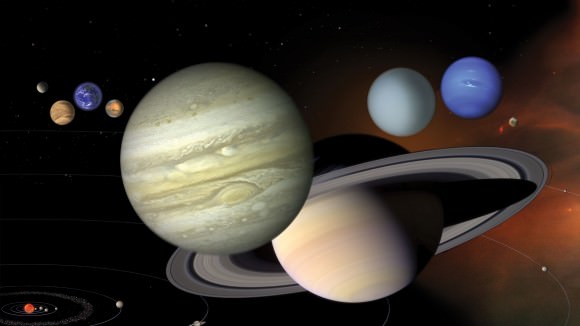
Our Solar System is a relatively, calm, sedate place compared to young solar systems. What might ours have looked like in its infancy? An illustration showing the 8 planets of the Solar System to scale Credit: NASA
RISE OF THE SUPER TELESCOPES:
THE GIANT MAGELLAN TELESCOPE (GMT)
The Giant Magellan Telescope Organization Breaks Ground in Chile
Published on Nov 11, 2015 Concept video of the Giant Magellan Telescope MORE INFORMATION: Category News & Politics License Standard YouTube License
The Giant Magellan Telescope (GMT) will be one of the next generation of giant ground-based telescopes that promises to revolutionize our view and understanding of the universe, even out-performing the Hubble and James Webb space telescopes at certain wavelengths. It is currently under construction at the Las Campañas Observatory in Chile. Commissioning of the telescope is scheduled to begin in 2029. Dr. James Fanson is the project manager for GMT, responsible for leading the team of engineers, managers and scientists in turning this ambitious goal into reality. He grew up with a lifelong interest in astronomy and space exploration. After earning a Bachelor of Science degree at the University of Wisconsin and a doctorate at the California Institute of Technology in Pasadena, he joined NASA’s Jet Propulsion Laboratory, specializing in space telescopes, and continued to serve there for 28 years. During this time, Fanson was a member of the team that fixed the Hubble Space Telescope’s blurred vision in 1993. He later served as lead engineer for the design of the Spitzer Space Telescope and project manager for the Galaxy Evolution Explorer, two telescopes launched into space in 2003. After an extensive career with NASA, Jim now serves as Project Manager for the Giant Magellan Telescope since 2015. 🔔 Subscribe for more: 🖖 Share this video with a fellow space traveler: : 🔴 Watch my most recent upload 🚀 Help me improve the channel by joining the community on Patreon 🚀 Check out Launch Pad merchandise! Disclaimer: Some of these links go to one of my websites and some are affiliate links where I'll earn a small commission if you make a purchase at no additional cost to you. 🧭 References:Giant Magellan Telescope: ✅ Let's connect: For business inquiries - chris AT christianready DOT com Twitter - @launchpadastro Instagram - @launchpadastro Facebook - Discord - 📭 c/o Christian Ready P.O. Box 66 Westminster, MD 21158 United States Earth
The scientific aims of the GMT
Star, planet, and disk formation Extrasolar planetary systems Stellar populations and chemical evolution Galaxy assembly and evolution Fundamental physics First light and reionization

The Giant Magellan Telescope is under construction in Chile and should see first light sometime in the early 2020s. Image: Giant Magellan Telescope – GMTO Corporation Website

The heart of the Giant Magellan Telescope is the segmented primary mirror. Image: Image: Giant Magellan Telescope – GMTO Corporation Website
GIANT MAGELLAN TELESCOPE - "A PERFECT MIRROR"
Published on Jul 31, 2013 Dr. Wendy Freedman, Chairman GMT, and Dr. Pat McCarthy, Director GMT, discuss the Giant Magellan Telescope's mirrors and the science that they will enable. Category Science & Technology License Standard YouTube License GMTO Corporation Website
COSMIC MYSTERIES"
Published on Jul 31, 2013 Dr. Robert Kirshner explains the conundrum of modern science--that much of what we "know" about the universe is probably wrong and explains how the Giant Magellan Telescope addresses these fundamental mysteries. Category Science & Technology License Standard YouTube License GMTO Corporation Website
This video is a simulation of the GMT enclosure and the air flow through it. These lines are not precisely the airflow however: technically they are the "magnitude of the spatial gradient of the refractive index of air on a plane parallel to the wind and aligned with the enclosure symmetry axis". What this means in practice is this simulation shows the regions of optical turbulence – or random variations in air speed and temperature – that can affect the image quality of the telescope. We run simulations like this with various orientations of the telescope relative to the wind and for different environmental conditions such as temperature and wind speed. We analyze all this information to understand which aspects of the design of the enclosure negatively affect image quality, and what can be done about it. As the design of the enclosure moves into its final stages these kinds of simulations are important to ensure our design guarantees the best possible image quality from the telescope. Read more on the GMTO Blog
RISE OF THE SUPER TELESCOPES:
THE 100 Meter OWL TELESCOPE
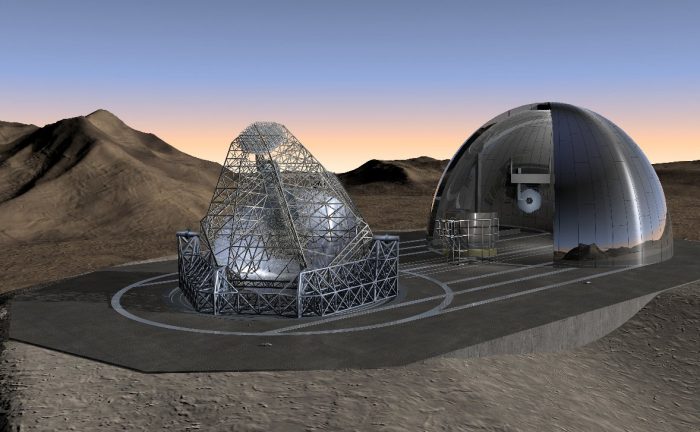
The 100 meter OWL telescope would have operated in the open air, and then been stored in its enclosure when not in use. Image: ESO Telescope Systems Division HOME PAGE
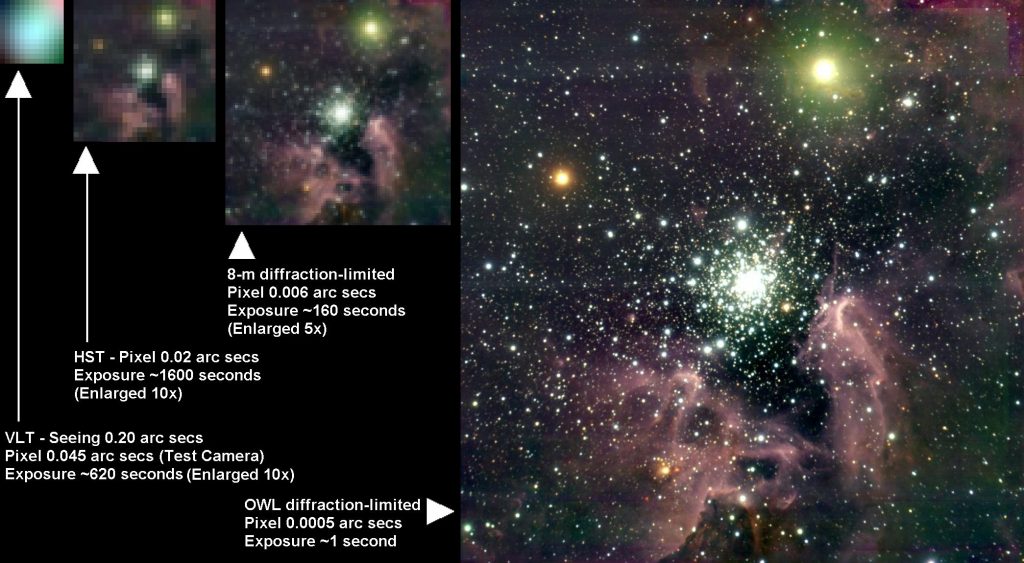
This image simulates the increased resolving power of the OWL compared to its contemporaries. Image: ESO Telescope Systems Division HOME PAGE
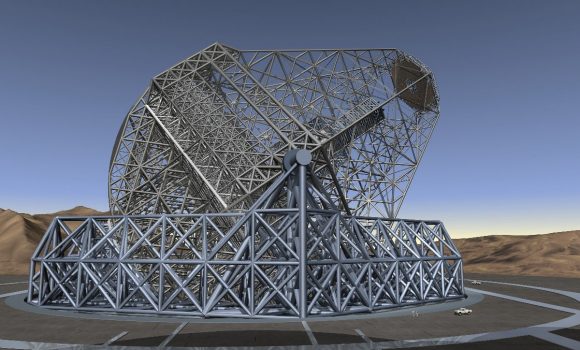
Everything about OWL’s design was modular, in an effort to keep costs down. Image: ESO Telescope Systems Division HOME PAGE
Published on Jun 14, 2016 How adaptive optics works. Dr. Acton from Ball Aerospace tells us about discoveries made at the Keck Observatory immediately after the adaptive optics system was installed. The system uses a fast tilt and pan mirror and deformable mirror which adjust to wavelengths of distortion calculated by a wave-front control system and computer. Dr. Acton found a volcano on Io and binary brown dwarfs after building the system. Part of the Universe of Instrumentation program. Category Science & Technology License Standard YouTube License HOME PAGE
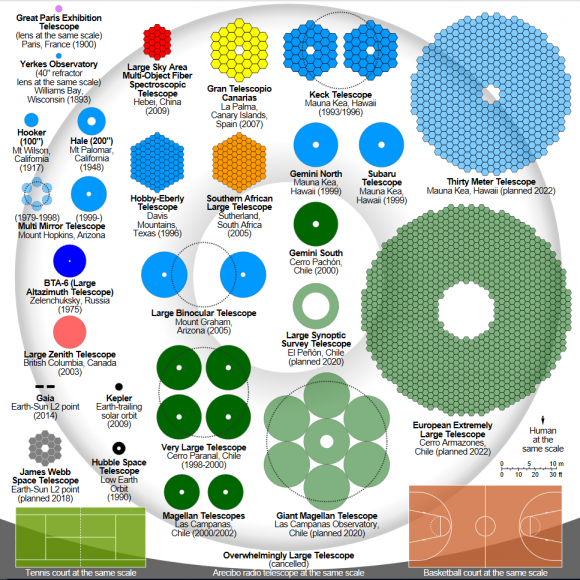
This graphic shows the sizes of the world’s telescopes superimposed over the OWL. By Cmglee – Own workiThe source code of this SVG is valid., CC BY-SA 3.0, WKIPEDA SOURCE
RISE OF THE SUPER TELESCOPES:
THE EUROPEAN EXTREMELY LARGE TELESCOPE

This artist’s rendering of the E-ELT is based on the detailed construction design for the telescope. Image: ESO/L. Calçada/ACe Consortium
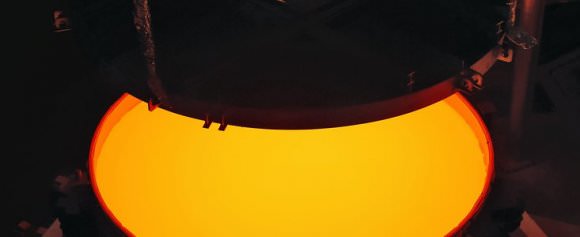
The secondary mirror for the E-ELT has already been cast. At 4.2 meters in diameter, it is the largest secondary mirror ever used on an an optical telescope. Image: ESO/Schott.
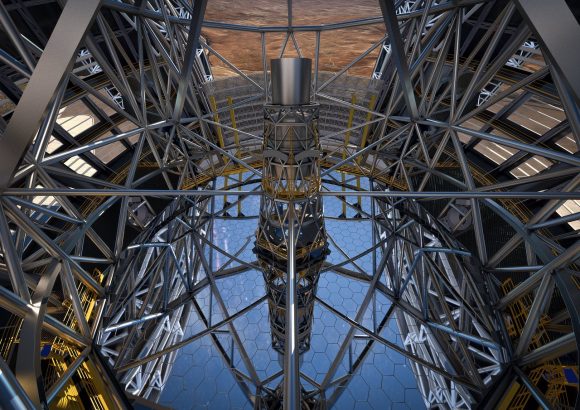
This artist’s rendering of the E-ELT is based on the detailed construction design for the telescope. Image: ESO/L. Calçada/ACe Consortium
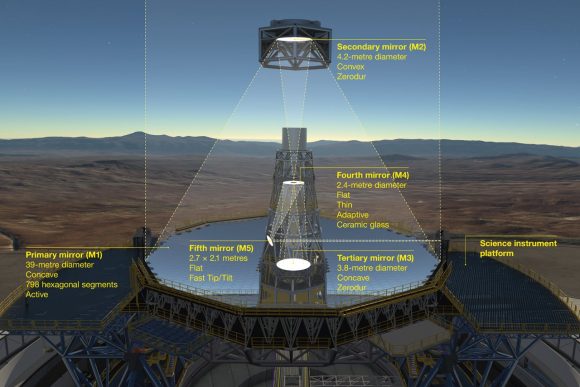
This diagram shows the novel 5-mirror optical system of ESO’s Extremely Large Telescope (ELT). Before reaching the science instruments the light is first reflected from the telescope’s giant concave 39-metre segmented primary mirror (M1), it then bounces off two further 4-metre-class mirrors, one convex (M2) and one concave (M3). The final two mirrors (M4 and M5) form a built-in adaptive optics system to allow extremely sharp images to be formed at the final focal plane. Image By ESO – CC BY 4.0,
ESOcast 84: The New E-ELT Design Unveiled
Published on Jun 3, 2016 ESO has awarded the biggest contract in ground-based astronomy — to build the E-ELT dome and telescope structure. So it’s a good time to take a look at what the E-ELT will be. This video is available for download in various formats at: Credit: ESO. Editing: Herbert Zodet. Web and technical support: Mathias André and Raquel Yumi Shida. Written by: Peter Grimley and Richard Hook. Narration: Sara Mendes da Costa. Music: Toomas Erm and Johan B. Monell (www.johanmonell.com). Footage and photos: ESO, L. Calçada, M. Kornmesser, ACe Consortium, M. Struik (CERN), ICAFAL/BROTEC Construcción, Microgate/ADS, G. Hüdepohl (atacamaphoto.com), AdOptica,NOVA/METIS/MAORY/MICADO consortium, HARMONI consortium, ESA/Hubble, Theofanis N. Matsopoulos and C. Malin (christophmalin.com). Directed by: Herbert Zodet. Executive producer: Lars Lindberg Christensen. Category Science & Technology License Creative Commons Attribution license (reuse allowed) Source videos View attributions
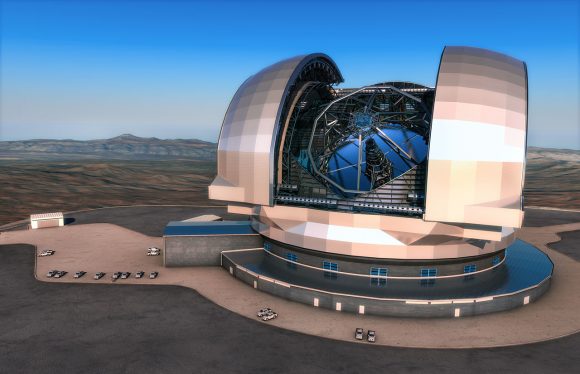
This artist’s impression shows the European Extremely Large Telescope (E-ELT) in its enclosure. The E-ELT will be a 39-metre aperture optical and infrared telescope sited on Cerro Armazones in the Chilean Atacama Desert, 20 kilometres from ESO’s Very Large Telescope on Cerro Paranal, which is visible in the distance towards the left. The design for the E-ELT shown here is preliminary. ESO/L. Calçada
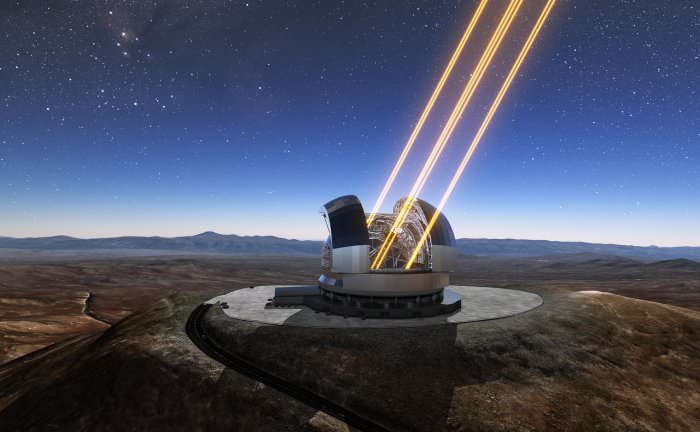
This artist’s rendering shows the Extremely Large Telescope in operation on Cerro Armazones in northern Chile. The telescope is shown using lasers to create artificial stars high in the atmosphere. Image: ESO/E-ELT
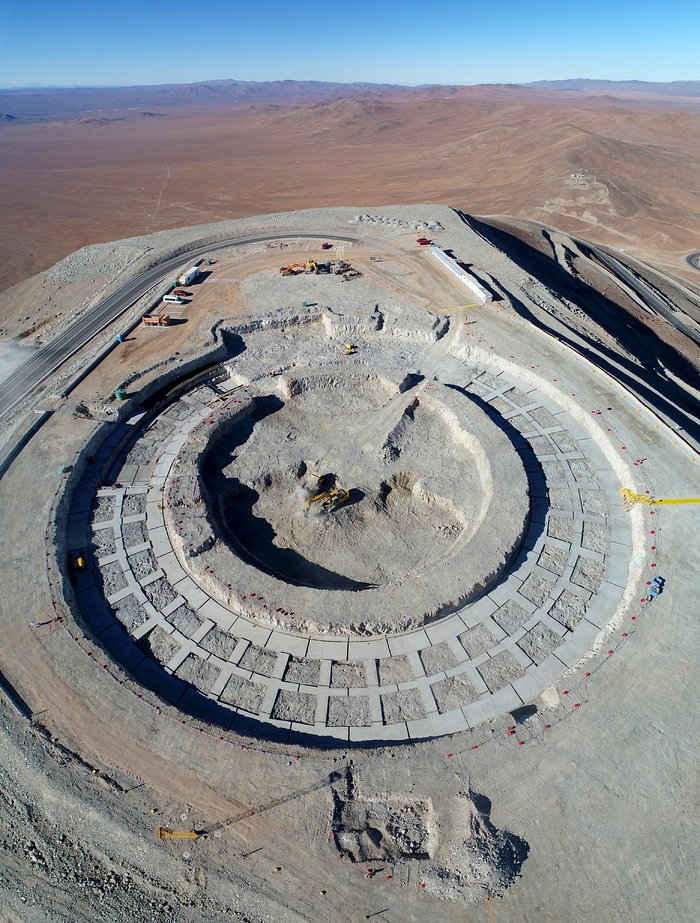
All over the world, some truly groundbreaking telescopes are being built that will usher in a new age of astronomy. Sites include the mountain of Mauna Kea in Hawaii, Australia, South Africa, southwestern China, and the Atacama Desert – a remote plateau in the Chilean Andes. In this extremely dry environment, multiple arrays are being built that will allow astronomers to see farther into the cosmos and with greater resolution.
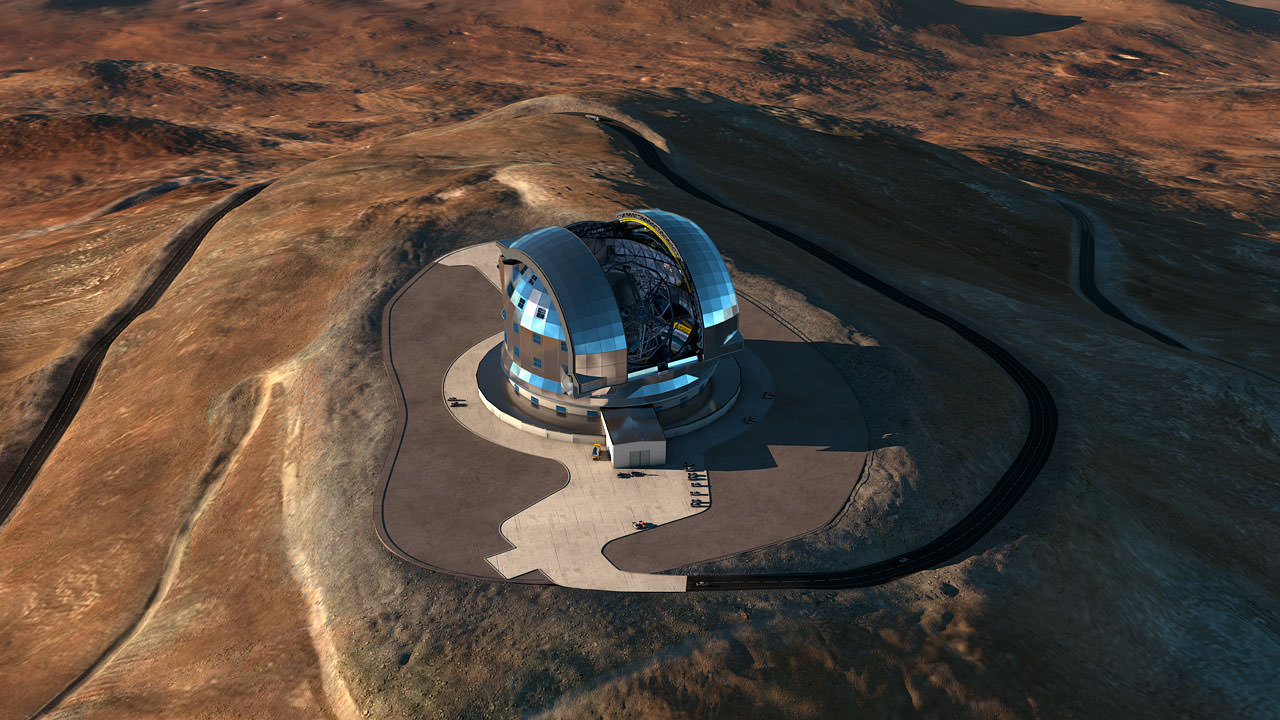
This artistic bird’s-eye view shows the dome of the ESO European Extremely Large Telescope (E-ELT) in all its glory, on top of the Chilean Cerro Armazones. The telescope is currently under construction and its first light is targeted for 2024. Credit: ESO
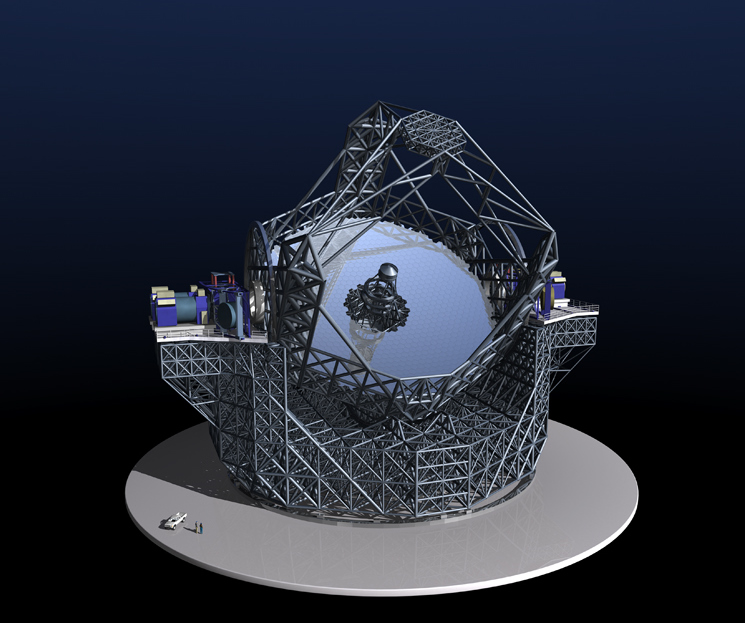
Artist impression of the Extremely Large Telescope’s 39-meter (128 ft) mirror. Credit: ESO
Construction is underway at Cerro Armazones -- the future home of the Extremely Large Telescope (ELT). When construction is done the ELT will be the largest optical telescope ever built -- a dome the size of a cathedral. The video is available in 4K UHD. The ESOcast Light is a series of short videos bringing you the wonders of the Universe in bite-sized pieces. The ESOcast Light episodes will not be replacing the standard, longer ESOcasts, but complement them with current astronomy news and images in ESO press releases. Credits and download options on: Caption author (French) Fantasmagoriam Foundation Caption author (Vietnamese) Sang Mai Thanh Caption author (Spanish (Latin America)) Astro Mike Caption author (Macedonian) Andrej Stojcevski Caption author (Bulgarian) Vasil Peev Caption author (Korean) Starlight Moonlight Yu Caption author (Russian) Aleksei Melnik Caption author (Romanian) Mihail-Gabriel Barbuta Caption author (Polish) Dragon Slayer Caption author (Italian) Cristina Bufi Poecksteiner Caption author (Portuguese (Brazil)) Luis Marinotti Category Science & Technology
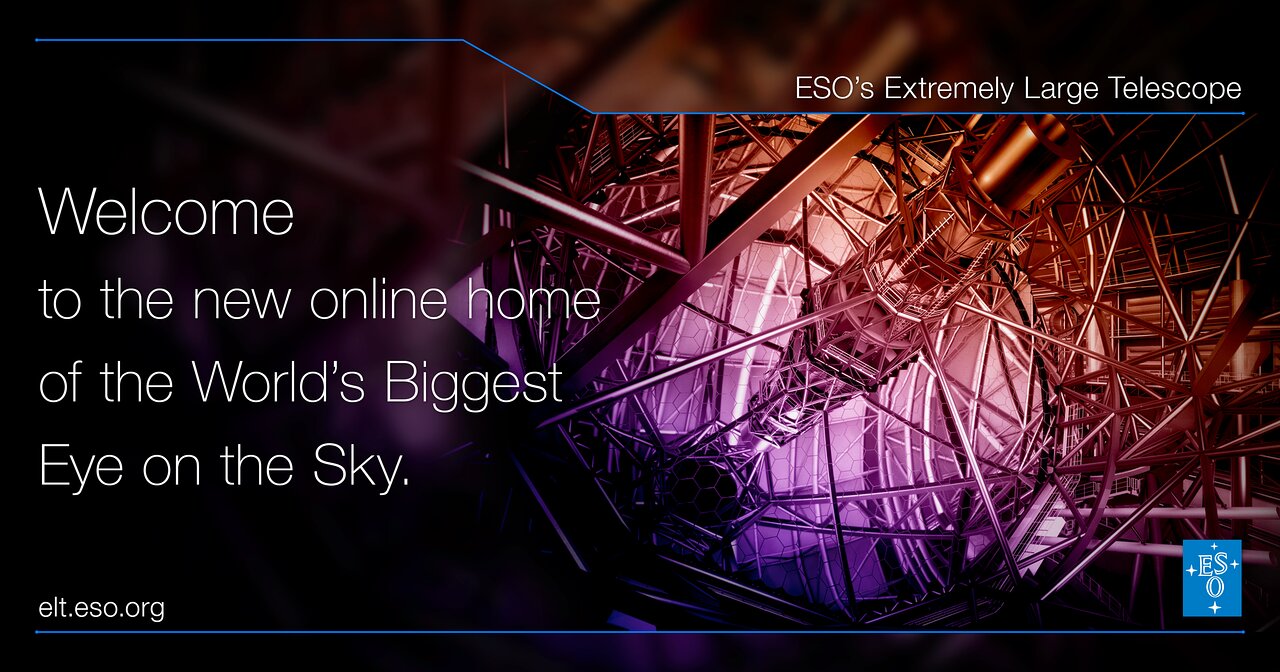
In the vein of “go big or go home,” the European Southern Observatory (ESO) has launched a stunning new website to showcase information about — and match the scale of — its Extremely Large Telescope (ELT), the highly anticipated observatory scheduled to have first light in 2025.
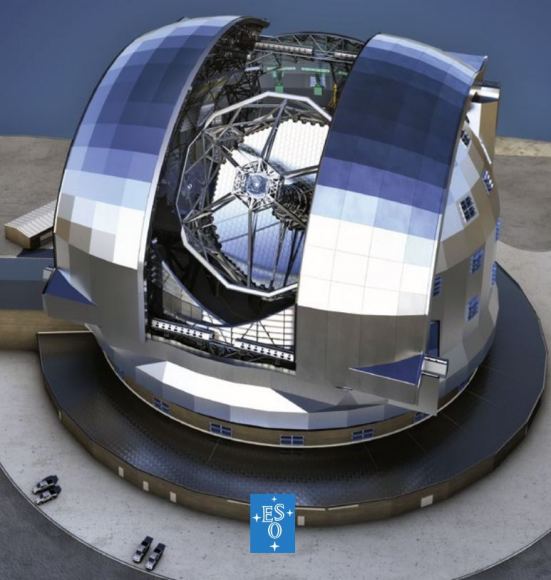
The ELT should see first light in 2024. This illustration shows the scale of the telescope, and also shows its segmented primary mirror, which is 39.3-metres in diameter (130-foot). Image Credit: ESO
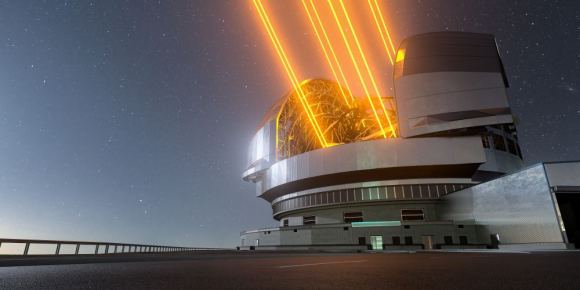
The Extremely Large Telescope (ELT) will be the biggest ‘eye on the sky’ when it achieves first light later this decade. The telescope uses lasers as ‘guide stars’ to measure how much the light is distorted by turbulence in the Earth’s atmosphere. The deformable M4 mirror adjusts its shape in real time to compensate for these changes in the atmosphere, helping the ELT produce images 16 times sharper than the Hubble Space Telescope. Image Credit: ESO
The Extremely Large Telescope (ELT), currently under construction in Chile, will be the world's biggest eye on the sky when it sees first light, planned for 2025. This revolutionary ground-based ESO telescope is set to be the largest of its kind in the world. 798 individual hexagonal segments will make up the telescope's main mirror, which spans 39 metres in diameter. The unique 5-mirror design of this telescope and advanced imaging technology will allow the ELT to produce images 15 times sharper than the Hubble Space Telescope. The ELT’s light-gathering power will allow astronomers worldwide to delve deeper and more clearly into our Universe, addressing the most prominent astrophysics questions of our time. The design for the ELT shown here is preliminary. Read more about the ELT project on this link More information and download options: Credit: ESO. Editing: Herbert Zodet. Web and technical support: Gurvan Bazin and Raquel Yumi Shida. Written by: Lauren Fuge, Hannah Dalgleish and Richard Hook. Music: Movetwo Footage and photos: ESO, Luis Calçada, ACe Consortium, spaceengine.org, ESA/Hubble, M. Kornmesser, Theofanis Matsopoulos and Samuel Santana Tschudi. Directed by: Herbert Zodet.
RISE OF THE SUPER TELESCOPES:

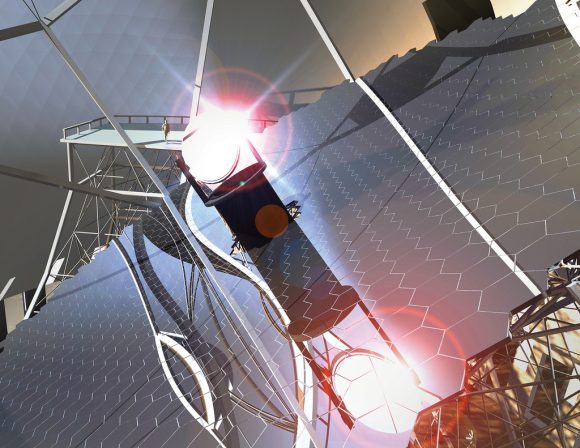
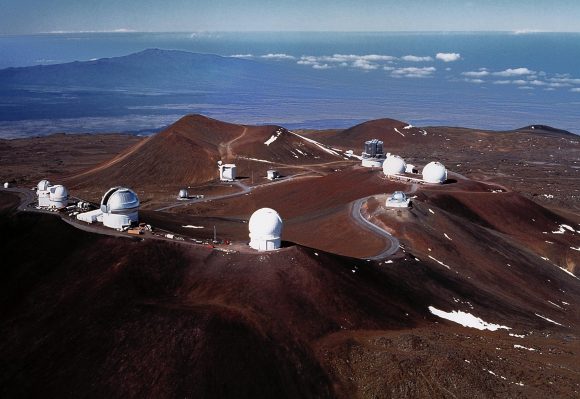
RISE OF THE SUPER TELESCOPES:
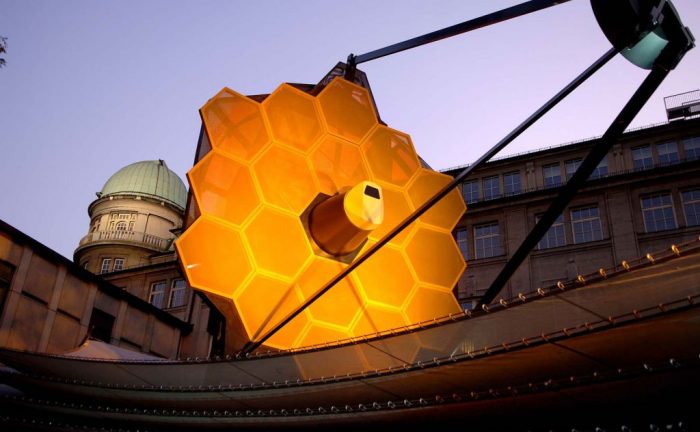
A full-scale model of the JWST went on a bit of a World Tour. Here it is in Munich, Germany. Image Credit: EADS Astrium
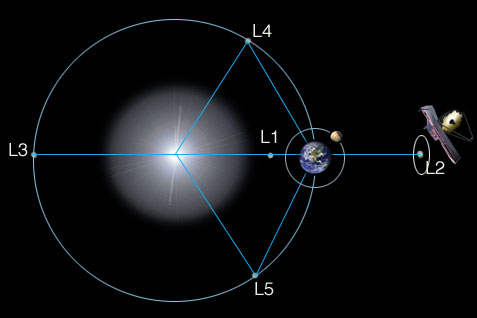
The JWST will do its observing while in what’s called a halo orbit at L2, a sort of gravitationally neutral point 1.5 million km from Earth. Image: NASA/JWST
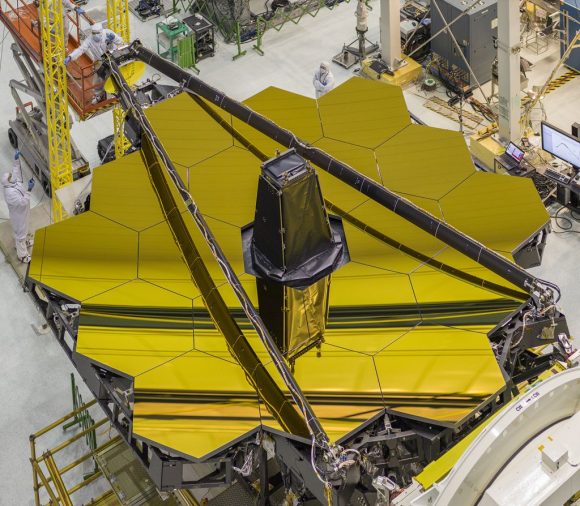
The business end of the James Webb Space Telescope is its 18-segment primary mirror. The gleaming, gold-coated beryllium mirror has a collecting area of 25 square meters. Image: NASA/Chris Gunn

This image shows the wavelengths of the infrared spectrum that Webb’s instruments can observe. Image: NASA/JWST
Uploaded on Oct 19, 2010 Watch how the James Webb Space Telescope's ability to look farther into space than ever before will bring newborn galaxies into view. These videos were developed to highlight the science that will be peformed by the James Webb Space Telescope. You can download this video: Credit: NASA/GSFC Category Science & Technology License Standard YouTube License Source videos View attributions
Uploaded on Oct 19, 2010 Watch how the James Webb Space Telescope's ability to look farther into space than ever before will bring newborn galaxies into view. These videos were developed to highlight the science that will be peformed by the James Webb Space Telescope. You can download this video: Credit: NASA/GSFC Category Science & Technology License Standard YouTube License Source videos View attributions
Uploaded on Oct 19, 2010 Stars and planets form in the dark, inside vast, cold clouds of gas and dust. The James Webb Space Telescope's large mirror and infrared sensitivity will let astronomers peer inside dusty knots where the youngest stars and planets are forming. These videos were developed to highlight the science that will be peformed by the James Webb Space Telescope. You can download this video: Credit: NASA/GSFC Category Science & Technology License Creative Commons Attribution license (reuse allowed) Source videos View attributions
Published on Apr 8, 2014 This video shows in-depth what will happen when James Webb Space Telescope deploys after launch. : For more information, see this description on our website Category Science & Technology License Standard YouTube License
The WFIRST Telescope
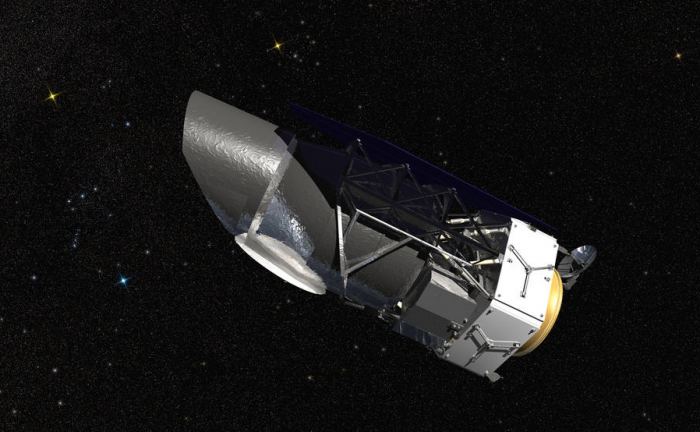
NASA's Wide Field Infrared Survey Telescope (WFIRST) will capture Hubble-quality images covering swaths of sky 100 times larger than Hubble does. These enormous images will allow astronomers to study the evolution of the cosmos. Its Coronagraph Instrument will directly image exoplanets and study their atmospheres. Credits: NASA/GSFC/Conceptual Image Lab
Published on Feb 18, 2016 NASA officially is beginning work on an astrophysics mission designed to help unlock the secrets of the universe -- the Wide Field Infrared Survey Telescope (WFIRST). With a view 100 times bigger than that of NASA’s Hubble Space Telescope, WFIRST will aid researchers in their efforts to unravel the secrets of dark energy and dark matter, and explore the evolution of the cosmos. It also will discover new worlds outside our solar system and advance the search for worlds that could be suitable for life.
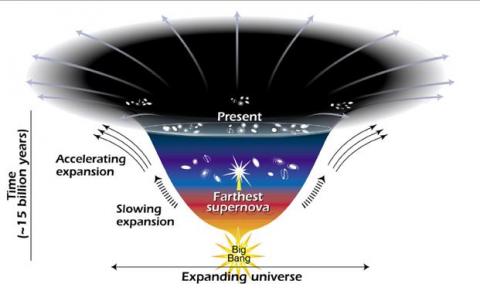
We used to think that the Universe expanded at a steady rate. Then in the 1990s we discovered that the expansion had accelerated. Dark Energy is the name given to the force driving that expansion. Image: NASA/STSci/Ann Feild
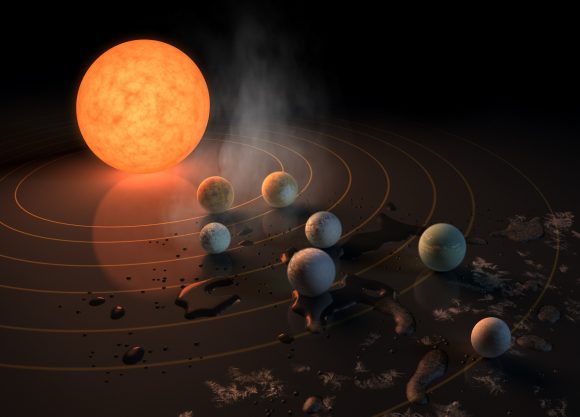
Artist’s concept of the TRAPPIST-1 star system, an ultra-cool dwarf that has seven Earth-size planets orbiting it. We’re going to keep finding more and more solar systems like this, but we need observatories like WFIRST to understand the planets better. Credits: NASA/JPL-Caltech
Published on Mar 16, 2015 Coronagraph is a telescopic attachment designed to block out the direct light from a star so that nearby objects – which otherwise would be hidden in the star’s bright glare – can be resolved. Category Science & Technology License Standard YouTube License
Published on Apr 17, 2014 Astronomers believe that every star in the galaxy has a planet, one fifth of which might harbor life. Only we haven't seen any of them -- yet. Jeremy Kasdin and his team are looking to change that with the design and engineering of an extraordinary piece of equipment: a flower petal-shaped "starshade" that allows a telescope to photograph planets from 50,000 kilometers away. It is, he says, the "coolest possible science." TEDTalks is a daily video podcast of the best talks and performances from the TED Conference, where the world's leading thinkers and doers give the talk of their lives in 18 minutes (or less). Look for talks on Technology, Entertainment and Design -- plus science, business, global issues, the arts and much more. t Find closed captions and translated subtitles in many languages a : Follow TED news on Twitter Like TED on Facebook: Subscribe to our channel: Category Science & Technology License Standard YouTube License
RISE OF THE SUPER TELESCOPES:
THE LARGE UV OPTICAL INFRARED SURVEYOR (LUVOIR) AKA HUBBLE 2.0
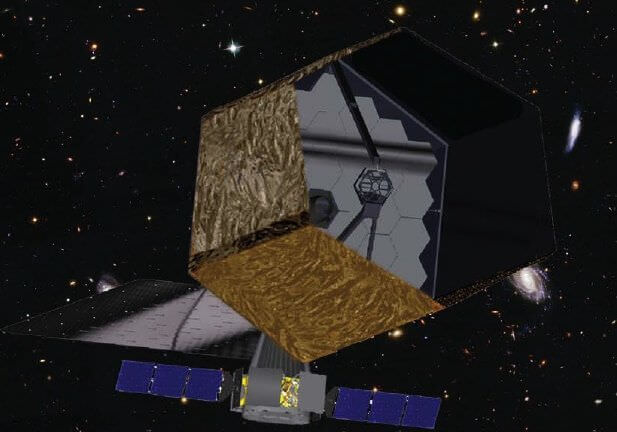
An artist's illustration of a 16 meter segmented mirror space telescope. There are no actual images of LUVOIR because the design hasn't been finalized yet. Image: Northrop Grumman Aerospace Systems
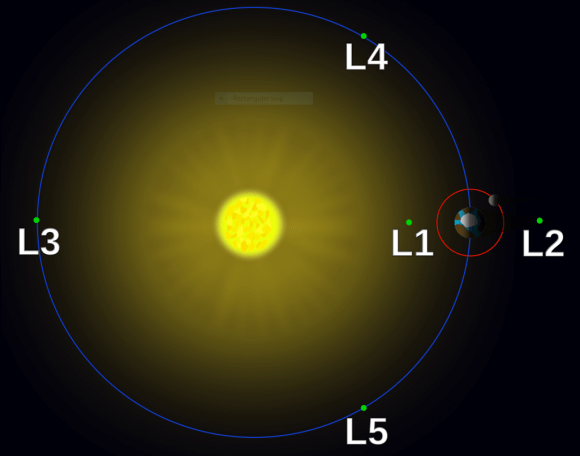
This not-to-scale image of the Solar System shows the LaGrangian points. LUVOIR will be located in a halo orbit at L2, along with the JWST. Image: By Xander89 – File:Lagrange_points2.svg, CC BY 3.0,
Weekly Space Hangout - Apr 14, 2017: Brad Peterson and LUVOIR, aka Hubble 2.0
Streamed live on Apr 14, 2017 We record the Weekly Space Hangout every Friday at 12:00 pm Pacific / 3:00 pm Eastern. You can watch us live on Universe Today or the Universe Today YouTube page. This week's special guest is Brad Peterson. Brad is a returning guest, and since his last appearance, he has been asked by NASA to serve as a community co-chair, with Debra Fischer of Yale, for the Science and Technology Definition Team for the Large Ultraviolet, Optical, and Infrared Surveyor (LUVOIR). Brad has carried out research on active galactic nuclei for his entire career. He has been developing the technique of reverberation mapping for over 25 years. He is currently on appointment at STScI as Distinguished Visiting Astronomer, after retiring from the faculty of The Ohio State University in 2015 with 35 years of service, the last nine as chair of the Department of Astronomy. He is also a member of the NASA Advisory Council, for which he chairs the Science Committee. He was recently named chair-elect for the Astronomy Section of the AAAS. The Luvoir webpage Category Science & Technology License Standard YouTube License
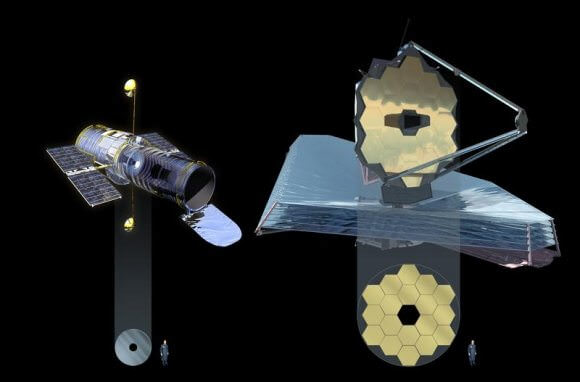
The Hubble Space Telescope on the left has a 2.4 meter mirror and the James Webb Space Telescope has a 6.5 meter mirror. LUVOIR, not shown, will dwarf them both with a massive 15 meter mirror. Image: NASA
The Search for Life
Using spectroscopy to search for signs of life on exoplanets is just one of LUVOIR’s science goals. LUVOIR is tasked with other challenges as well, including: Mapping the distribution of dark matter in the Universe. Isolating the source of gravitational waves. Imaging circumstellar disks to see how planets form. Identifying the first starlight in the Universe, studying early galaxies and finding the first black holes. Studying surface features of worlds in our Solar System.
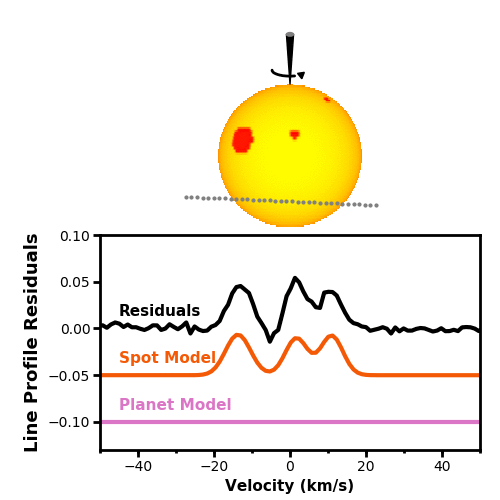
Image: Animation courtesy of George Zhou, CfA. Top right illustration of DS Tuc AB by M Weiss, CfA.
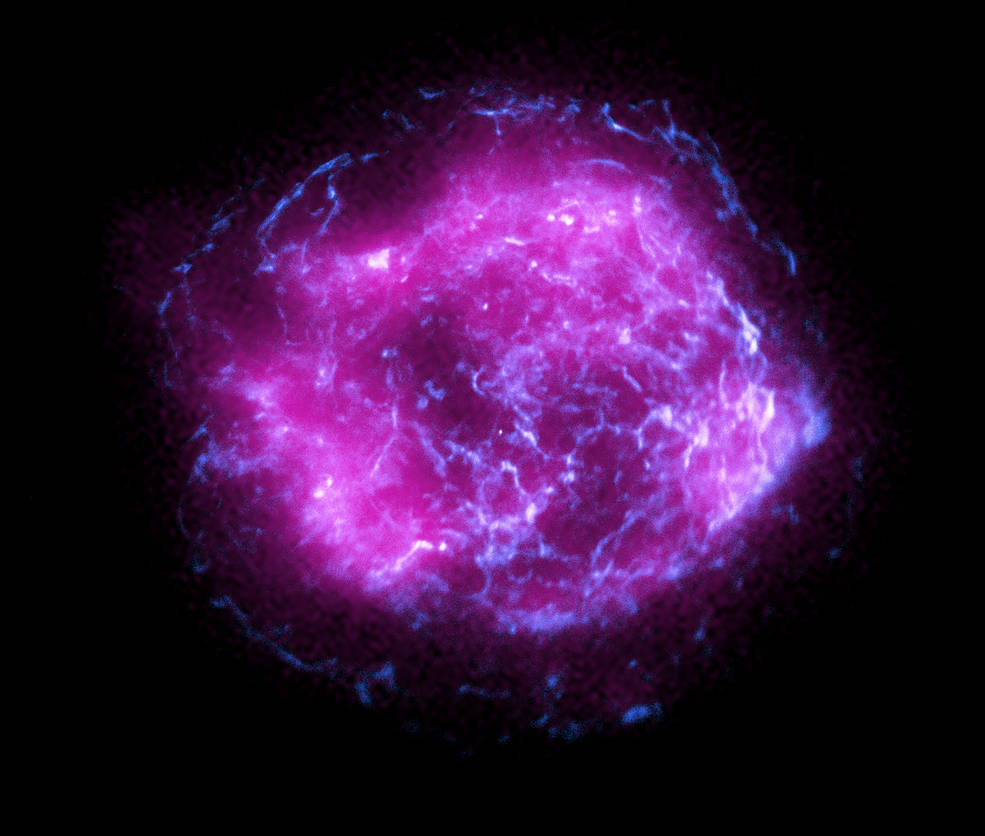
This image of the supernova remnant Cassiopeia A combines some of the first X-ray data collected by NASA’s Imaging X-ray Polarimetry Explorer, shown in magenta, with high-energy X-ray data from NASA’s Chandra X-Ray Observatory, in blue. Credits: NASA/CXC/SAO/IXPE
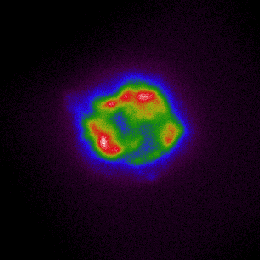
This image from NASA’s Imaging X-ray Polarimetry Explorer maps the intensity of X-rays coming from the observatory’s first target, the supernova remnant Cassiopeia A. Colors ranging from cool purple and blue to red and hot white correspond with the increasing brightness of the X-rays. The image was created using X-ray data collected by IXPE between Jan. 11-18. Credits: NASA
RADIO Observatories!
Published on Jul 4, 2016 ET, phone Beijing. The final triangular panel in the world’s largest radio telescope was lowered into place this weekend
as Chinese officials amped up the hunt for alien life. If intelligent beings lurk in the universe, the spectacular new Five-hundred-meter Aperture Spherical Telescope (FAST)
is uniquely equipped to find them, promised Peng Bo, director of the National Astronomical Observation (NAO).
License Standard YouTube License
The search for alien life will soon get a major boost as the Chinese government has finished construction of their enormous ET-hunting radio telescope.
At a cost of $180 million dollars, the massive telescope measures an astounding 1,640 feet in diameter, making it the largest such device in the world. With the construction stage finished, Chinese scientists will begin testing the telescope to ensure that it is running properly and hope to begin operation of the device in earnest this September. By virtue of its incredible size, the telescope will be able to detect extremely faint radio signals that otherwise would be missed by current technology here on Earth. While many Chinese citizens were celebrating the completion of the project, it is surely bittersweet for the 9,000 people who once resided in the area but were forced to relocate by the government. And although the powerful telescope boasts tremendous potential to possibly find evidence of aliens, one wonders if the Chinese government
would actually reveal any discoveries should they 'hear' from ET. Source: Daily Mail
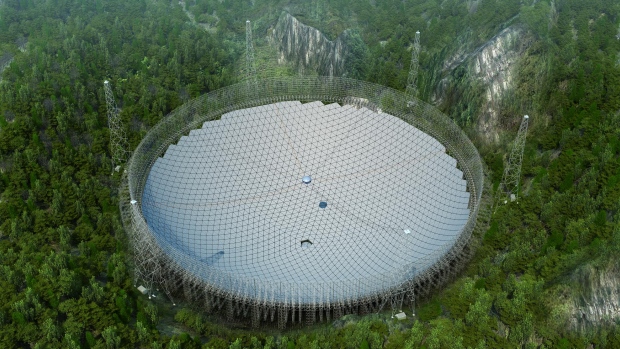
China's new radio telescope, the world's largest, should be completed by September 2016. Image: FAST

The world’s largest radio telescope is almost finished - and it’s going to try to make contact with extra-terrestrial life.
This fascinating video and stunning photos show how close the 500m wide Aperture Spherical Telescope, or “FAST”, is to completion.
Pictures credit : CEN

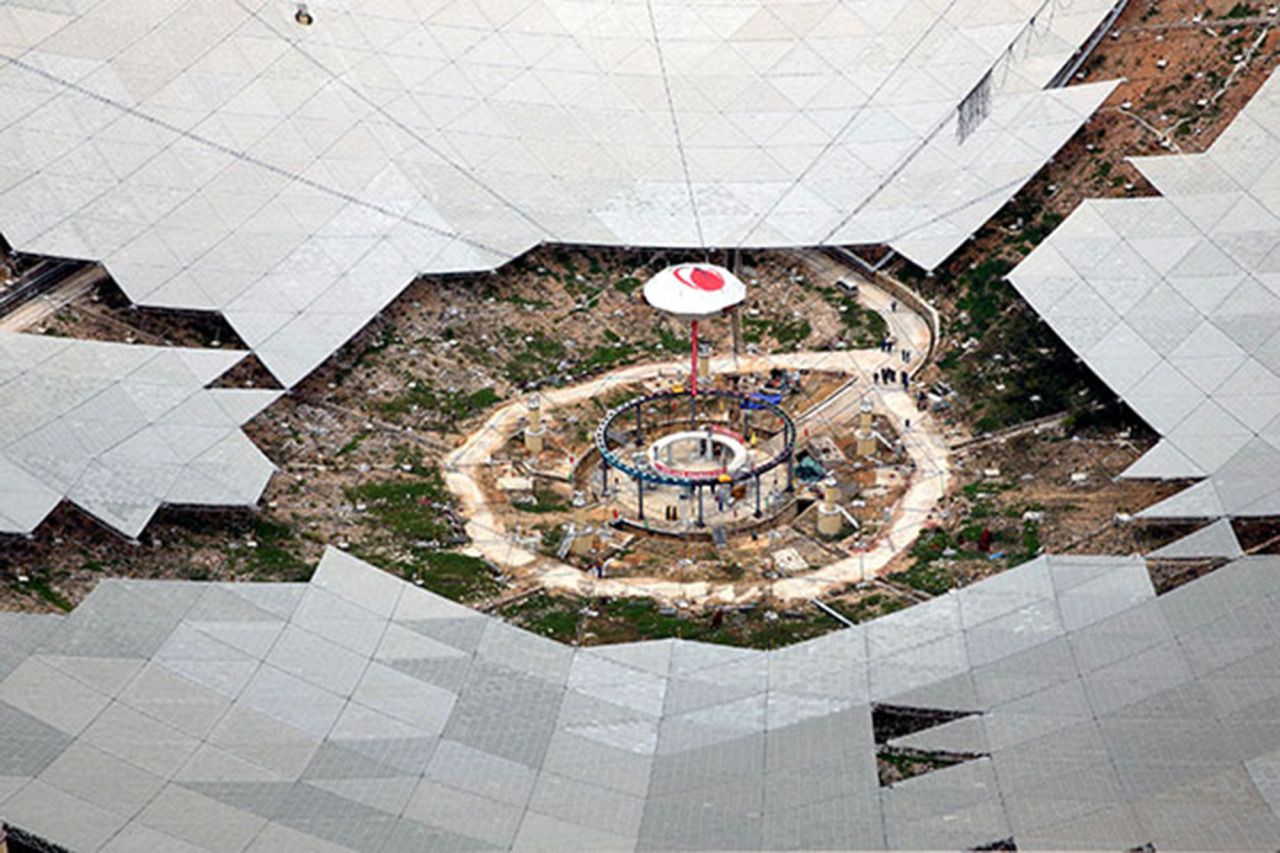

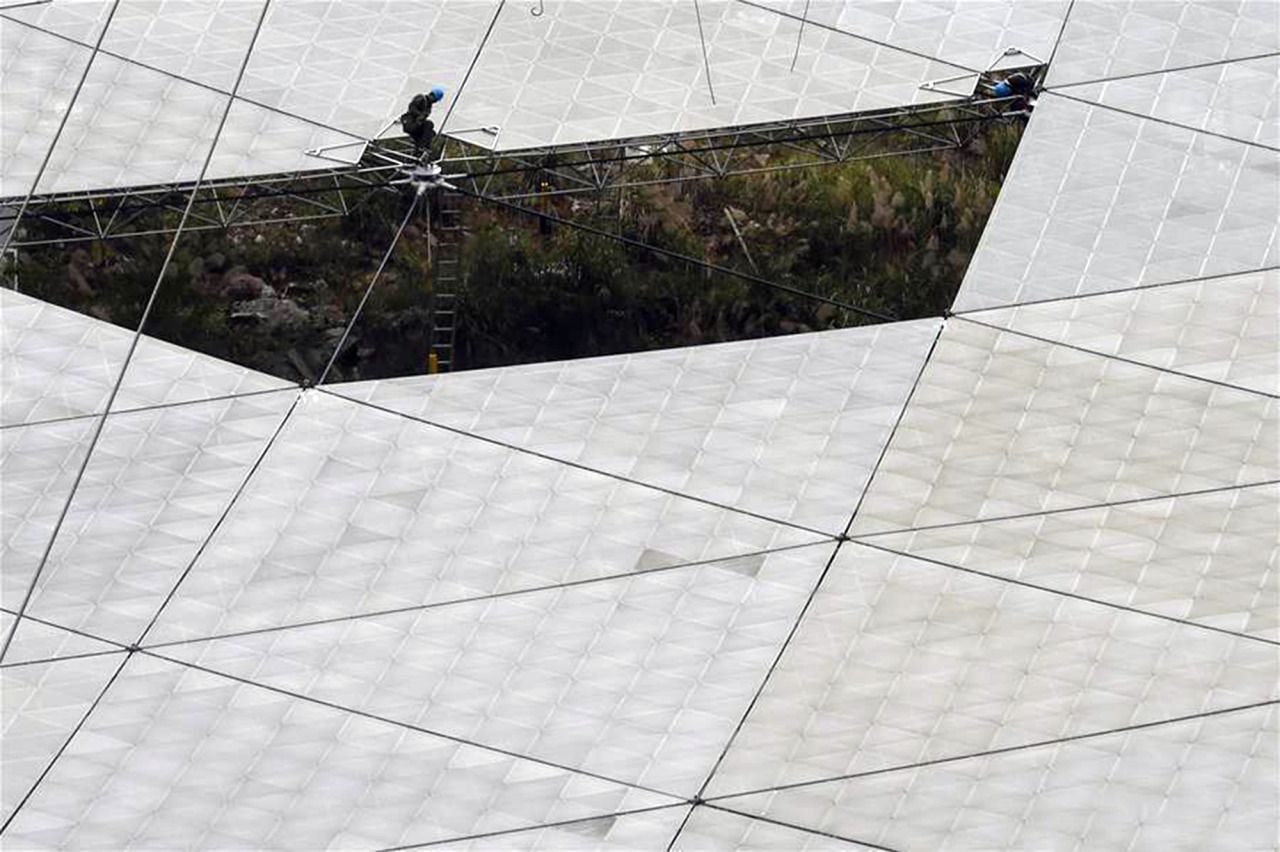
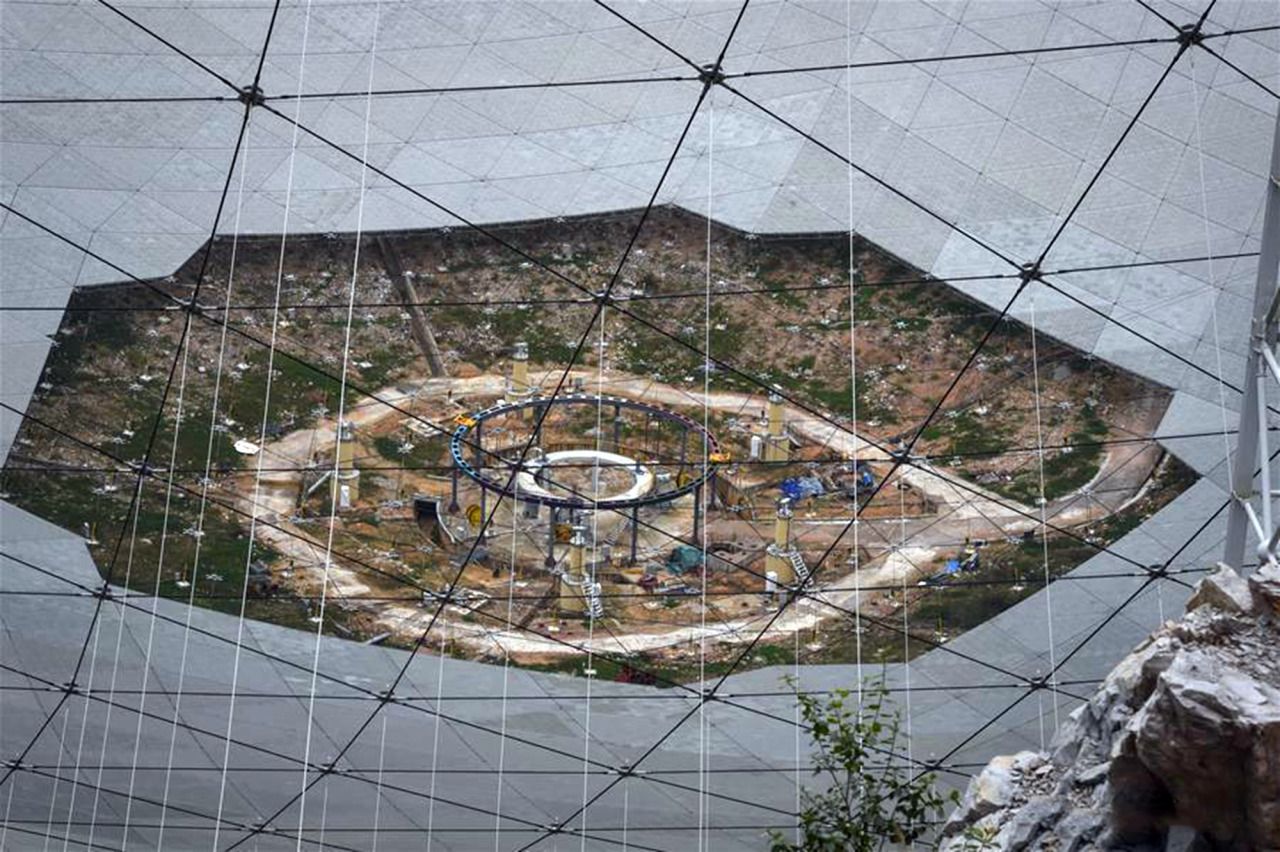
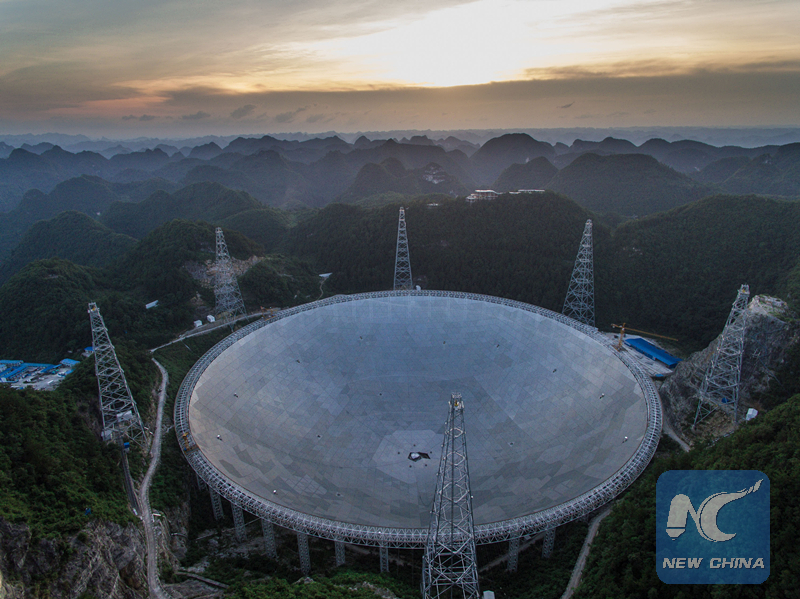
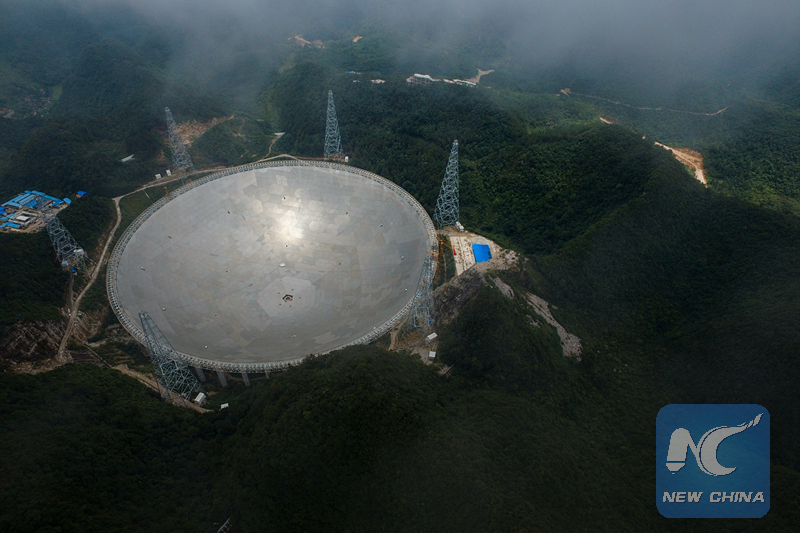
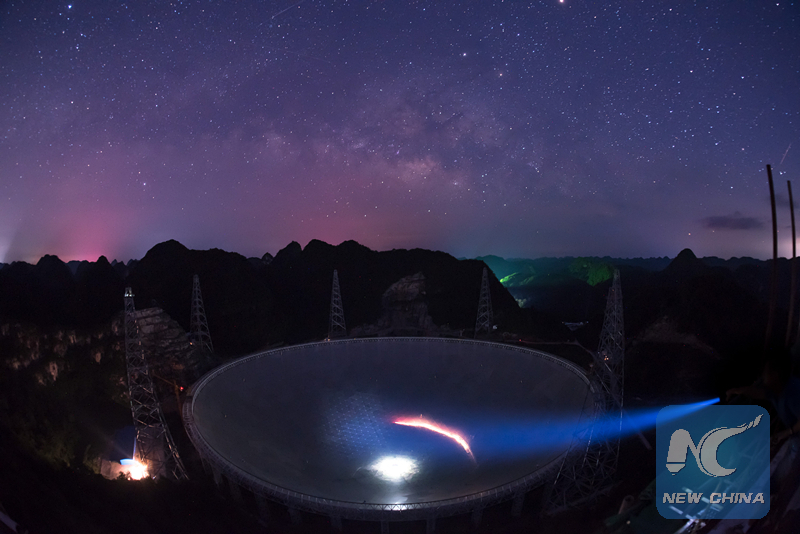
China begins operating world's largest radio telescope
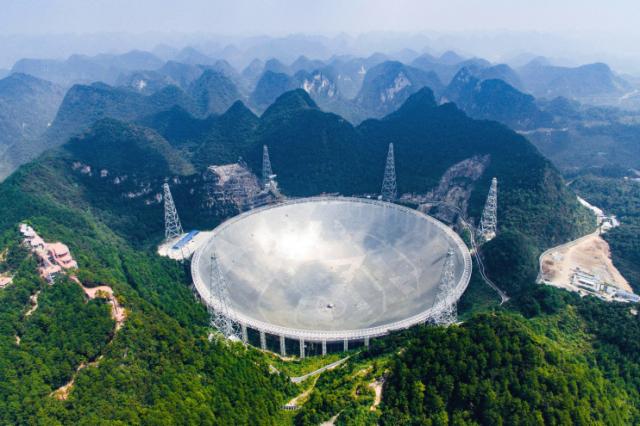
In this Saturday, Sept. 24, 2016 photo released by Xinhua News Agency, an aerial view shows the
Five-hundred-meter Aperture Spherical Telescope (FAST) in the remote Pingtang county in southwest China’s Guizhou province.
China has begun operating the world’s largest radio telescope to help search for extraterrestrial life.
(Liu Xu/Xinhua via AP) (Associated Press)
Capturing the Radio Sky
Uploaded on May 11, 2015 These side-by-side videos show the sky as seen looking straight up from the ground at radio (left) and optical (right) wavelengths.
The radio movie covers 24 hours of observation with the new Owens Valley Long Wavelength Array, a project led by Caltech.
Each frame is a 9-second integration with the telescope, but only every tenth image is included. The optical movie was made using an all-sky camera
at Palomar Observatory and therefore only covers nighttime. Note that the radio sky is completely distinct to that visible at optical wavelengths. Almost all of the sources visible in the optical movie
are stars. The density of stars is highest in the Milky Way, which is visible to the naked eye.
Radio emission from our galaxy is also clearly visible in the LWA movie, but is produced not by stars but by cosmic rays spiraling in the magnetic
fields of our galaxy. The brightest source in the radio is not the sun—both Cassiopeia A and Cygnus A are brighter. However, when the Sun flares (as it does in the LWA movie),
it can become thousands of times brighter than anything else in the sky. Credit: Stephen Bourke/Caltech and the LWA team Category Science & Technology License Standard YouTube License
FAST: The World's Largest Telescope | A China Icons Video
Published on Sep 25, 2016 What's really out there? On Sunday 25th September 2016, China will unveil the world’s largest telescope and begin test operations
China switches on world’s largest radio telescope "FAST" today to search for alien transmission Listen to me
Published on Sep 24, 2016 (Sunday, 25 September 2016) China is set to start operating the world's largest single-dish radio telescope, enabling astronomers to probe farther and darker regions of space for the faintest signs of life. Scheduled to be launched on Sunday, the science mega-project is named after its huge dimensions: the Five-hundred-meter Aperture Spherical Telescope, or FAST. Built within a valley surrounded by naturally-formed karst hills in China's remote and mountainous southwestern Guizhou province, the FAST radio telescope's huge dish is equal in size to 30 football pitches and was constructed from 4,000 individual metal panels at a cost of around $180m. It also required the relocation of 10,000 people living in the vicinity of the huge structure. The feasibility study for the telescope was carried out over 14 years and construction took more than five years to complete. Chinese state media have enthusiastically focused on FAST's huge size, noting that it dwarfs by 200 metres the Arecibo Observatory in Puerto Rico, which at 305 meters in diameter had been the world's largest single-aperture telescope since the 1960s until the Chinese telescope was completed in July. Category Science & Technology License Standard YouTube License
The Breakthrough Initiative
BREAKTHROUGH INITIATIVE DETECTS REPEATING FAST RADIO BURSTS COMING FROM DISTANT GALAXY
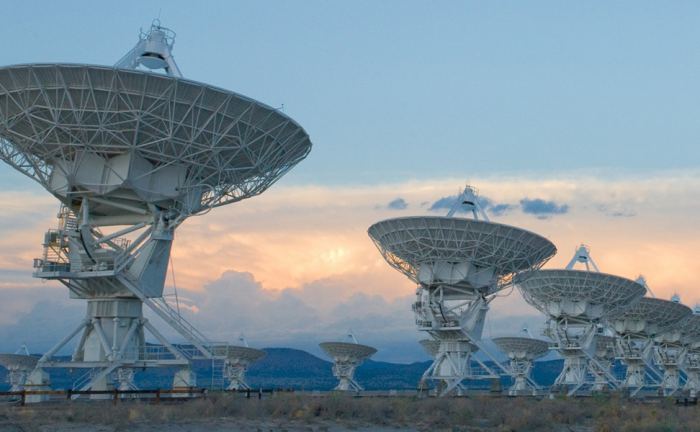
The Karl G. Jansky Very Large Array, located in central New Mexico. Credit: NRAO
In Green Bank, Breakthrough Listen has access to the largest fully steerable radio telescope on the planet.
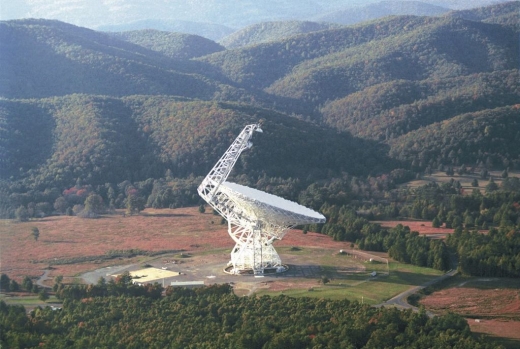
Image: The Green Bank Radio Telescope (GBT) focuses 2.3 acres of radio light. It is 148 meters tall,
nearly as tall as the nearby mountains and much taller than pine trees in the national forest.
The telescope is in a valley of the Allegheny mountains to shield the observations from radio interference.
Credit: NRAO
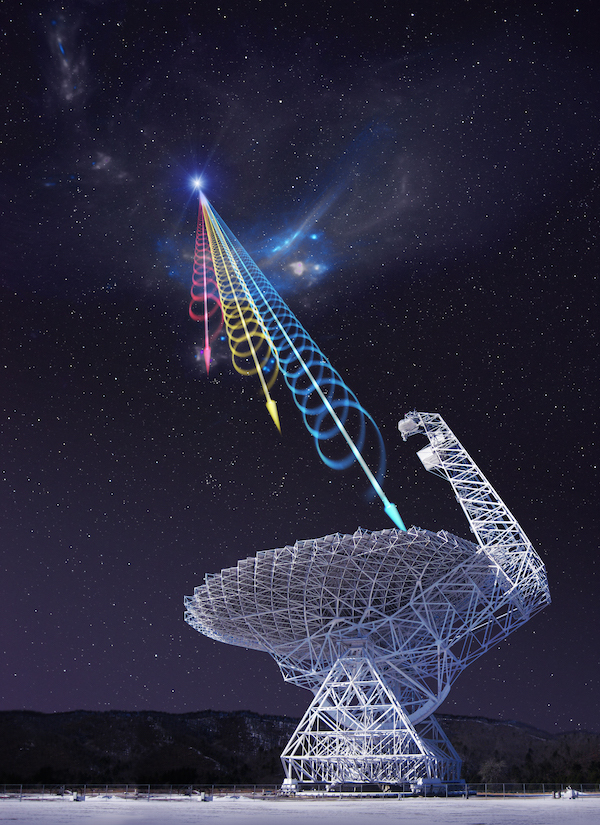
An artist’s rendering of a Fast Radio Burst arriving at the Green Bank Telescope. Fast Radio Bursts are brief and highly energetic pulses of radio waves from the distant universe. Recent research suggests the bursts originate in deep space near what may be a supernova remnant or a stellar nursery. credit: Image: Jingchuan Yu, Beijing Planetarium
Berkeley SETI Live Chat from Green Bank about Tabby's Star observations has access to the largest fully steerable radio telescope on the planet.
TABETHA BOYJIAN
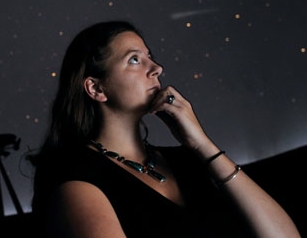
Streamed live on Oct 26, 2016 BSRC Director Dr. Andrew Siemion is joined by Louisiana State Professor Tabetha Boyajian and Penn State Professor Jason Wright
for a live chat from the Green Bank observatory about their observations of Tabby's Star. Category Science & Technology License Standard YouTube License
The ALMA Milli-Meter Radio Observatory
ALMA CAPTURES NEVER-BEFORE-SEEN DETAILS OF PROTOPLANETARY DISK
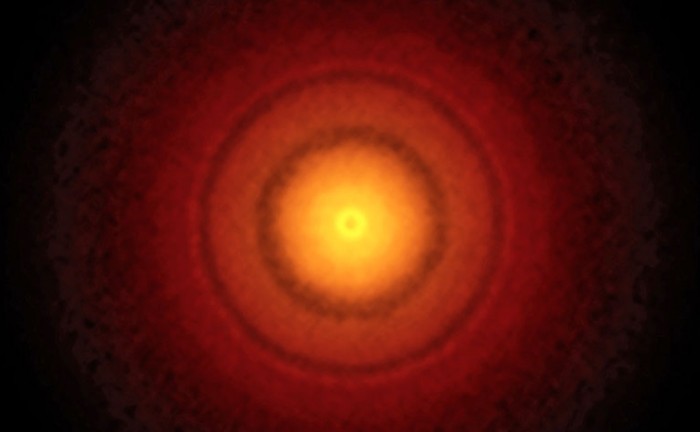
ALMA’s best image of a protoplanetary disk to date. This picture of the nearby young star TW Hydrae
reveals the classic rings and gaps that signify planets are in formation in this system.
Credit: S. Andrews (Harvard-Smithsonian CfA); B. Saxton (NRAO/AUI/NSF); ALMA (ESO/NAOJ/NRAO)
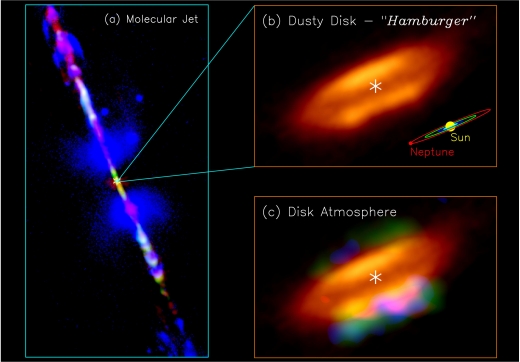
Image: Jet, disk, and disk atmosphere in the HH 212 protostellar system. (a) A composite image for the HH 212 jet in different molecules, combining the images from the Very Large Telescope (McCaughrean et al. 2002) and ALMA (Lee et al. 2015). Orange image shows the dusty envelope+disk mapped with ALMA. (b) A zoom-in to the central dusty disk. The asterisk marks the position of the protostar. A size scale of our solar system is shown in the lower right corner for comparison. (c) Atmosphere of the accretion disk detected with ALMA. In the disk atmosphere, green is for deuterated methanol, blue for methanethiol, and red for formamide. Credit: ALMA (ESO/NAOJ/NRAO)/Lee et al.
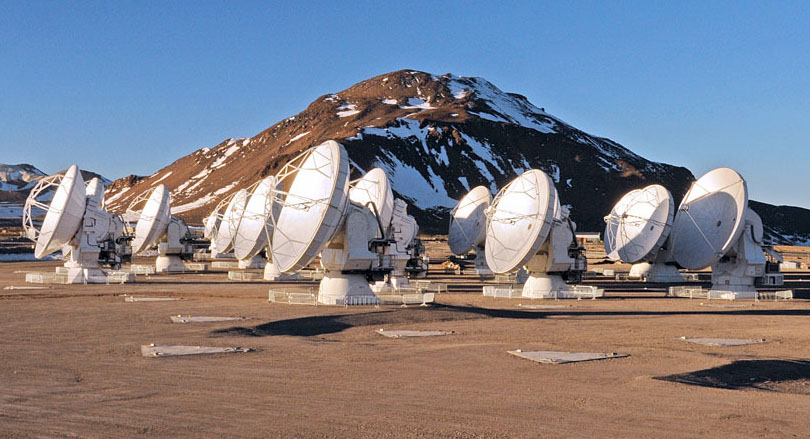
This photo of the ALMA antennas on the Chajnantor Plateau in Chile, more than 16,000 feet (5000 meters) above sea level,
was taken a few days before the start of ALMA Early Science and shows only one cluster of the 66 dishes.
ALMA views the sky in submillimeter light, a slice of the spectrum invisible to the human eye that lies between
infrared and radio waves. Credit: ALMA (ESO/NAOJ/NRAO)/W. Garnier (ALMA)
Soar Over ALMA with NRAO's New Drone Footage from NRAO Outreach on Vimeo.
The NRAO Digital Learning Team recently visited our Atacama Large Millimeter/submillimeter Array in northern Chile to update our suite of virtual tours called The ALMA Explorer Here is a small sample of drone footage recently captured at the array -- yes, we successfully flew a drone at 16,500 ft above sea level in high wind and freezing cold!
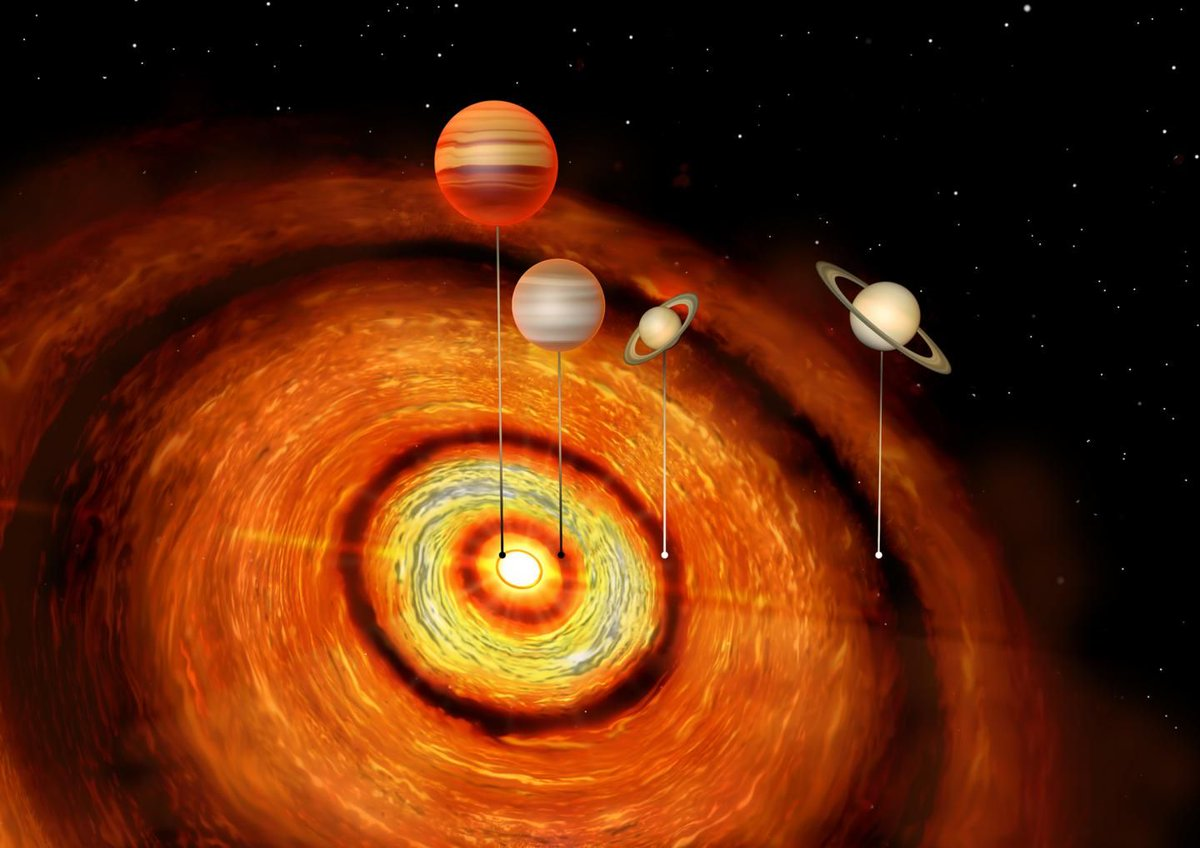
What exactly is a “normal” solar system? If we thought we had some idea in the past, we definitely don’t now. And a new study led by astronomers at Cambridge University has reinforced this fact. The new study found four gas giant planets, similar to our own Jupiter and Saturn, orbiting a very young star called CI Tau. And one of the planets has an extreme orbit that takes it more than a thousand times more distant from the star than the innermost planet.
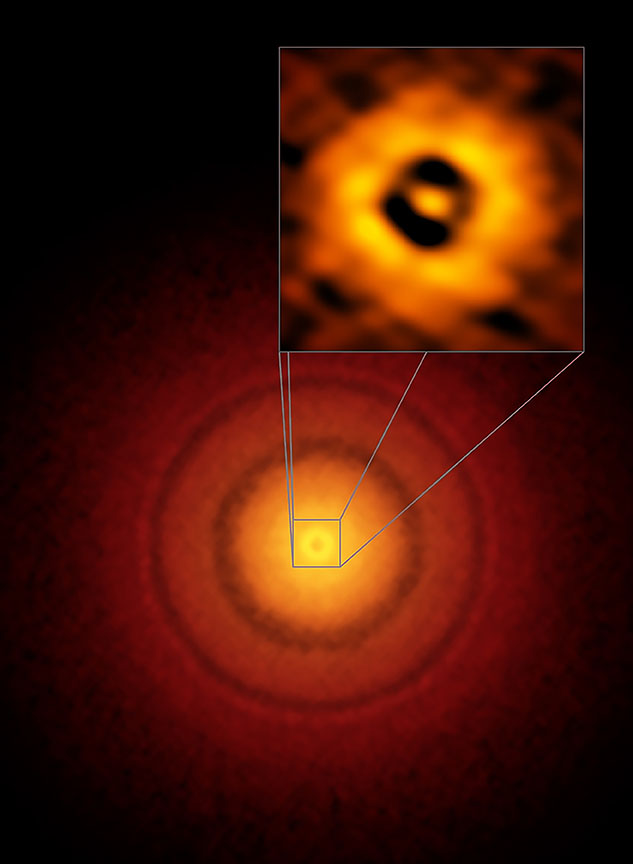
ALMA image of the planet-forming disk around the young, sun-like star TW Hydrae.
The inset image (upper right) zooms in on the gap nearest to the star,
which is at the same distance as the Earth is from the sun, and may show an infant version
of our home planet emerging from the dust and gas. The additional concentric light and dark features
represent other planet-forming regions farther out in the disk.
Credit: S. Andrews (Harvard-Smithsonian CfA), ALMA (ESO/NAOJ/NRAO)
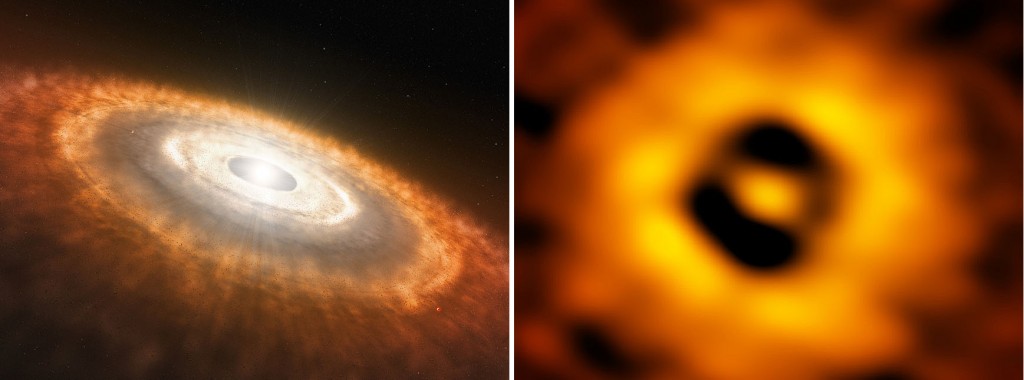
The model (at left) of a protoplanetary disk shows a newly forming star at the center of a saucer-shaped dust cloud.
At right, a close up of TW Hydrae taken by ALMA shows a gap about 93 million miles from the central star,
suggesting that a planet with a similar orbit to Earth is forming there. Credit: (Left: L. Calcada).
Right: S. Andrews (Harvard-Smithsonian CfA); B. Saxton (NRAO/AUI/NSF); ALMA (ESO/NAOJ/NRAO)
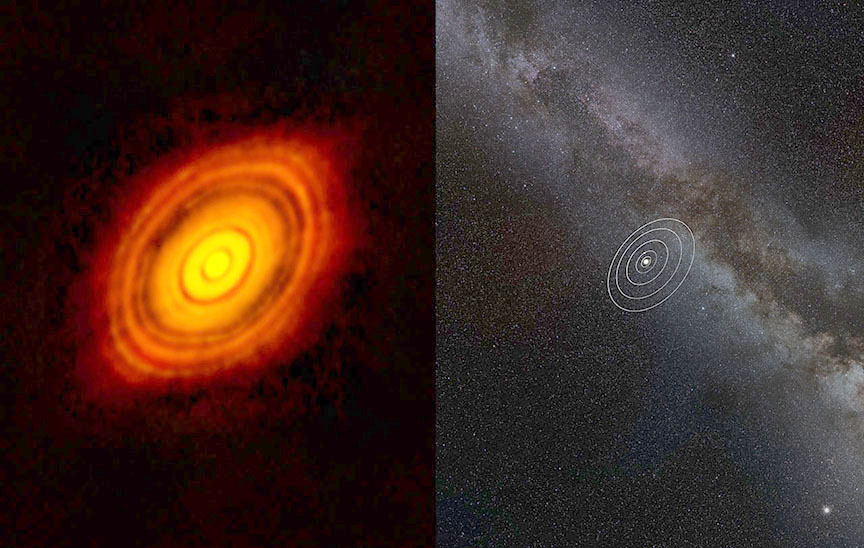
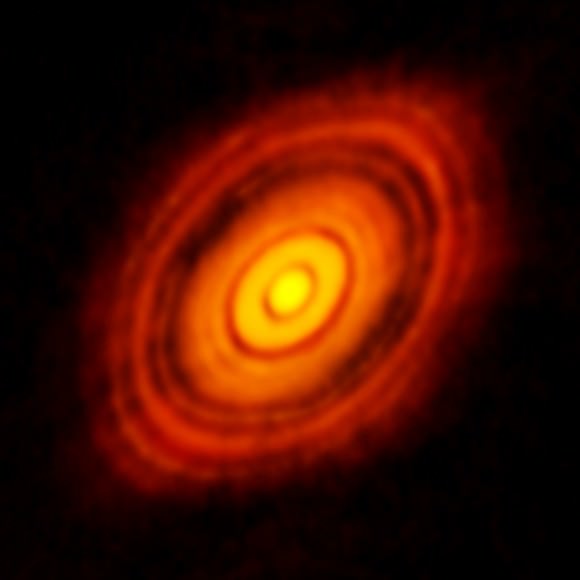
ALMA image of the protoplanetary disc around HL Tauri, another young star similar to CI Tau, but not part of this study. Astronomers think that the dark circular shapes are the orbital paths of the planets that are forming around the star. Credit: ALMA Observatory.
This image compares the size of the solar system with HL Tauri and its surrounding protoplanetary disc.
Although the star is much smaller than the Sun, the disc around HL Tauri stretches out to almost three times
as far from the star as Neptune is from the Sun. Credit:ALMA (ESO/NAOJ/NRAO)
ASTRONOMERS SEE A PILEUP OF 14 SEPARATE GALAXIES IN THE EARLY UNIVERSE
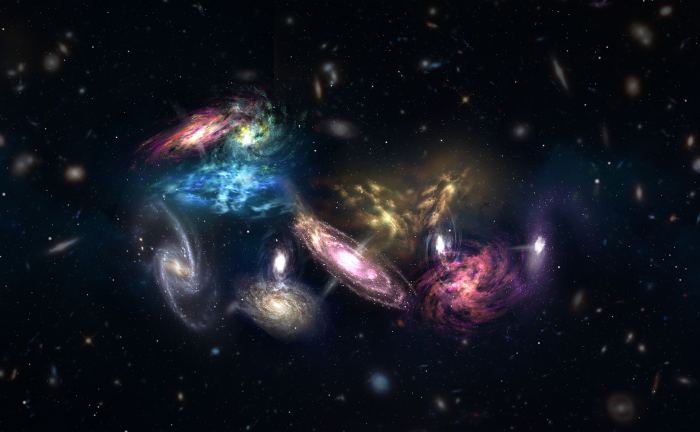
Artist impression of the 14 galaxies detected by ALMA as they appear in the very early, very distant universe. These galaxies are in the process of merging and will eventually form the core of a massive galaxy cluster. Credit: NRAO/AUI/NSF; S. Dagnello
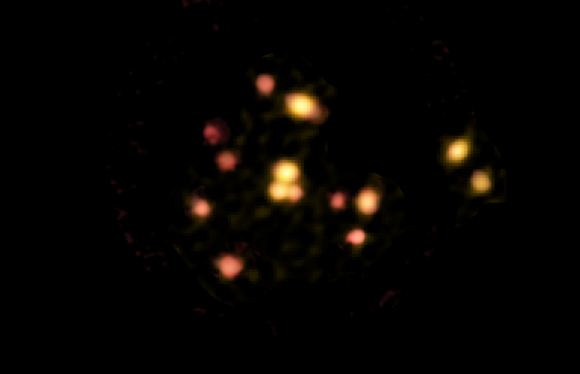
ALMA image of 14 galaxies forming a protocluster known as SPT2349-56. These galaxies are in the process of merging and will eventually form the core of a truly massive galaxy cluster. Credit: ALMA (ESO/NAOJ/NRAO); B. Saxton (NRAO/AUI/NSF)
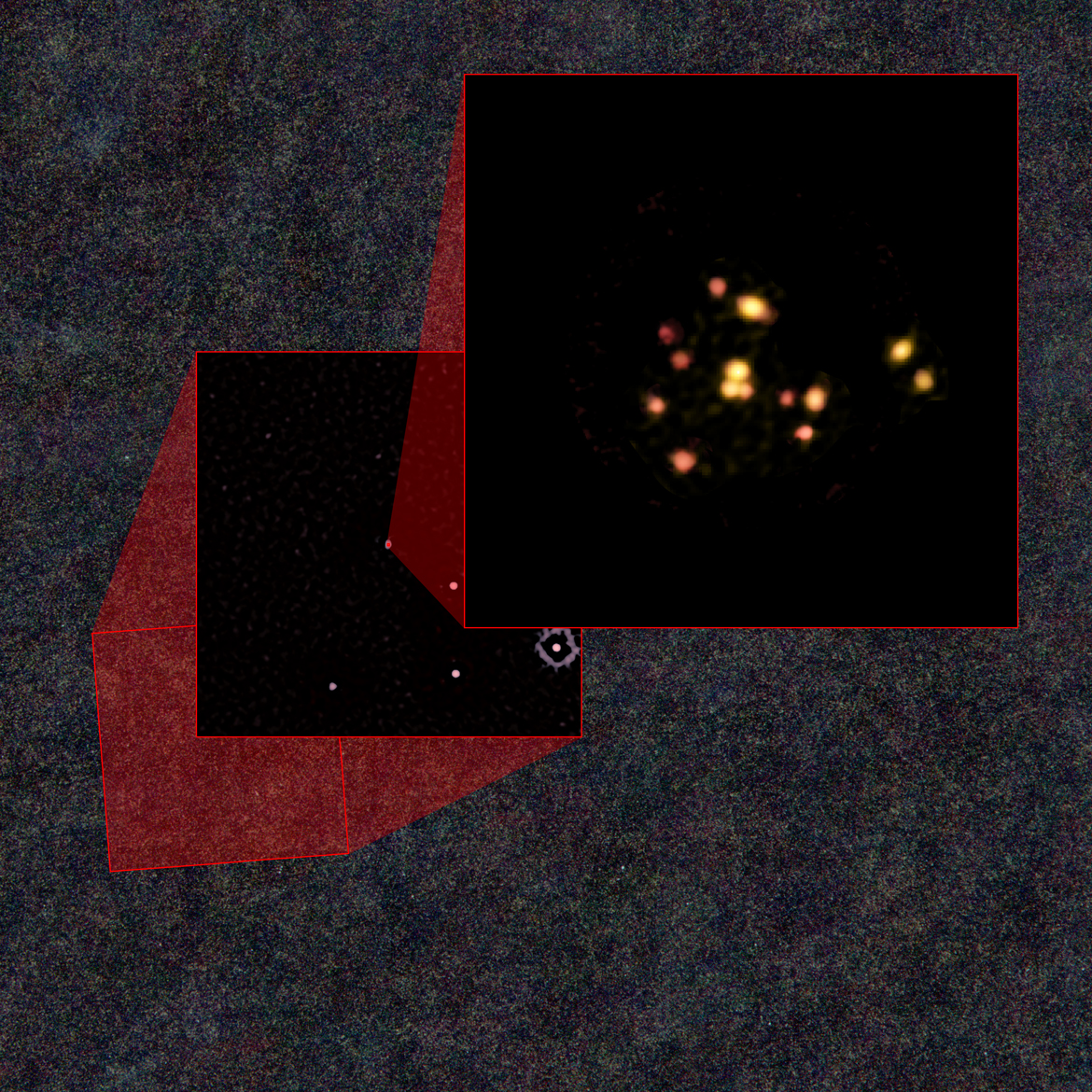
Zooming in to the galaxies discovered by ALMA that are evolving into a galaxy cluster. Credit: ALMA (ESO/NAOJ/NRAO), T. Miller & S. Chapman et al.; Herschel; South Pole Telescope; (NRAO/AUI/NSF) B. Saxton
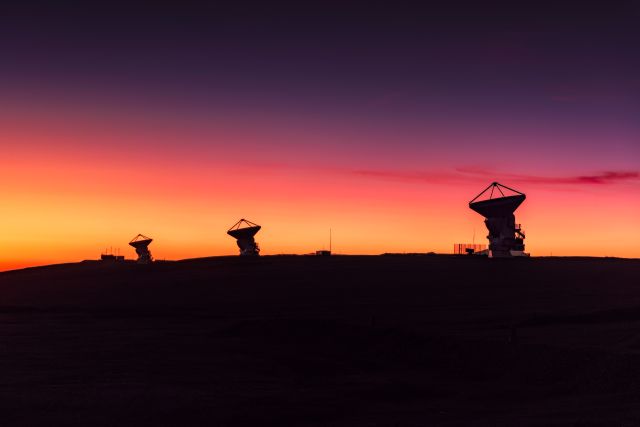
Three of the dishes that make up the Atacama Large Millimeter/submillimter Array (ALMA). Image Credit: H. Calderón – ALMA (ESO/NRAO/NAOJ)
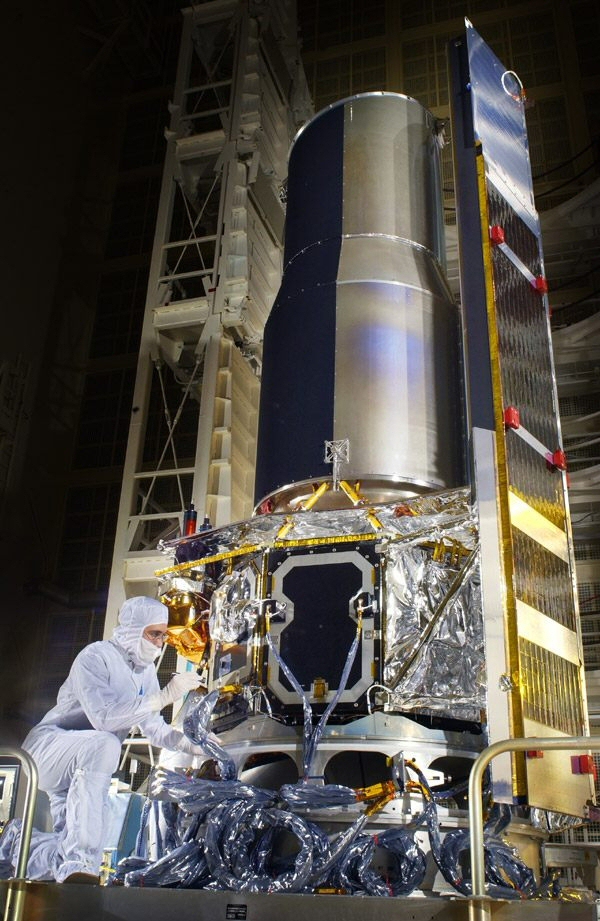
The Spitzer Telescope on the Launch Pad
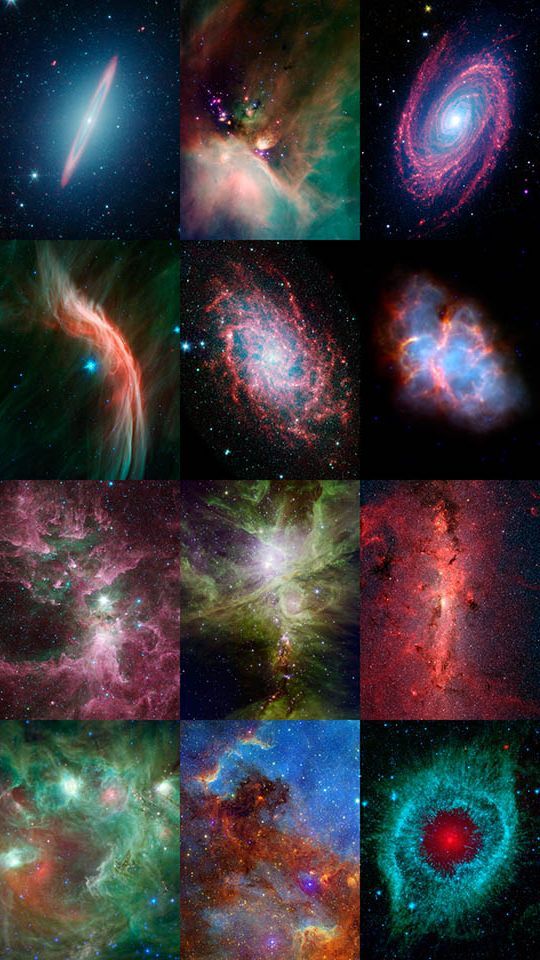
Twelve Years of Spitzer Images This montage displays an image released from each year of operation of NASA's Spitzer Space Telescope.
Now celebrating it's 12th anniversary, Spitzer was first launched into space on August 25, 2003, from Cape Canaveral, Florida
and is still going strong. Credit NASA/JPL-Caltech
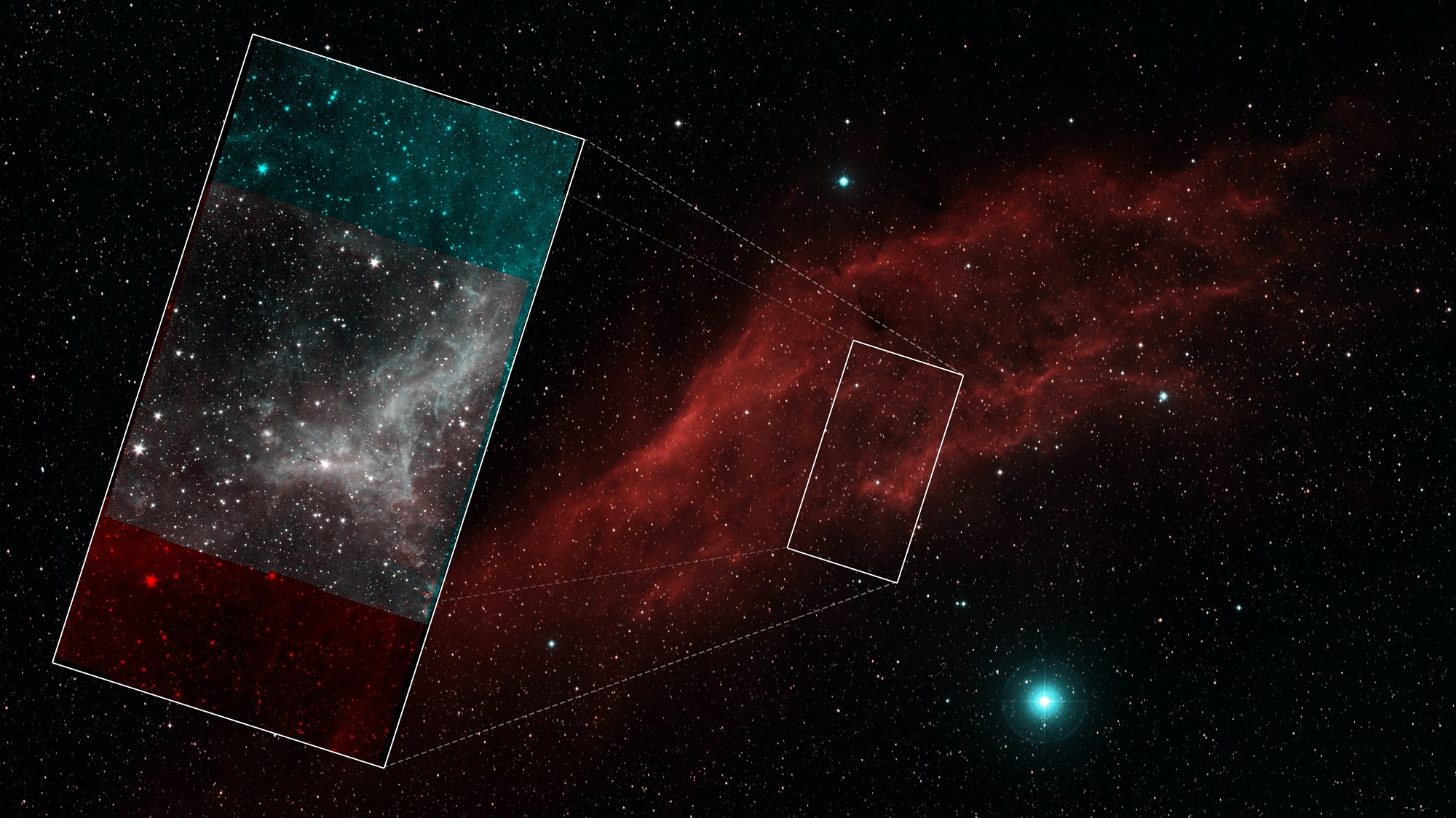
On Jan. 30th, 2020, NASA’s Spitzer Space Telescope was retired after sixteen years of faithful service. As one of the four NASA Great Observatories – alongside Hubble, Chandra, and Compton space telescopes – Spitzer was dedicated to studying the Universe in infrared light. In so doing, it provided new insights into our Universe and enabled the study of objects and phenomena that would otherwise be impossible. For instance, Spitzer was the first telescope to see light from an exoplanet and made important discoveries about comets, stars, and distant galaxies. It is therefore fitting that mission scientists decided to spend the last five days before the telescope was to be decommissioned capturing breathtaking images of the California Nebula, which were stitched into a mosaic and recently released to the public.
P>
After 16 years of amazing infrared discoveries throughout the cosmos, NASA’s Spitzer Space Telescope mission is coming to an end. Join us on Jan. 22 at 1 p.m. EST for a live broadcast celebrating the life and legacy of one of our four great observatories. Mission members will discuss the observatory's far-reaching scientific impact and the incredible team that kept the mission going far longer than anticipated.
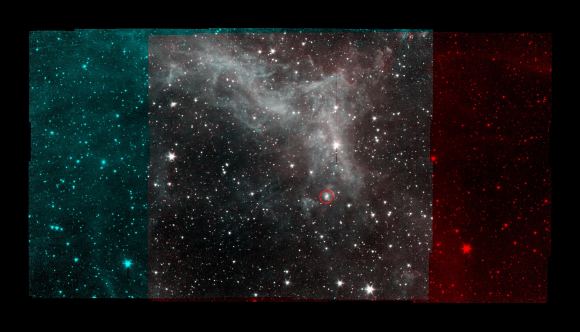
This image of the California Nebula imaged by NASA’s Spitzer Space Telescope features a background galaxy, with clearly defined spiral arms, circled in red. Credit: NASA/JPL-Caltech
We record the Weekly Space Hangout every Wednesday at 5:00 pm Pacific / 8:00 pm Eastern. You can watch us live on Universe Today or the Weekly Space Hangout YouTube page. Tonight we welcome Dr. Michael Werner and Dr. Peter Eisenhardt, authors of the new book More Things in the Heavens which looks at how infrared astronomy is aiding the search for exoplanets and extraterrestrial life, and is transforming our understanding of the history and evolution of our universe. Included in their book are many spectacular images that have been captured by the Spitzer space telescope over its lifetime. Michael graduated from Haverford College and received his PhD in Astronomy from Cornell University in 1968. He has been the Project Scientist for the Spitzer Space Telescope since 1983, and its predecessor mission, SIRTF since 1977. Michael was the Chief Scientist for Physics and Astronomy at JPL [2004 to 2014] and was awarded the George Darwin lectureship of the Royal Astronomical Society for his work on Spitzer. Peter is a senior research scientist at the Jet Propulsion Laboratory. He earned his Bachelor's degree in Physics and Astronomy from University of Pennsylvania, and his PhD in Astronomy from the University of Arizona. Peter received NASA’s Exceptional Scientific Achievement Medal for his work on Spitzer. More Things in the Heavens is available for order from the Princeton University Press and other online retailers. You can learn more about Michael by visiting his NASA biography and profile here: You can learn more about Peter by visiting his NASA biography and profile here: Want to support CosmoQuest? Here are specific ways you can help: Subscribe FREE to our YouTube channel at Watch our streams over on Twitch at – follow and subscribe! Become a Patreon of Astronomy Cast Become a Patreon of CosmoQuest Sponsor 365 Days of Astronomy
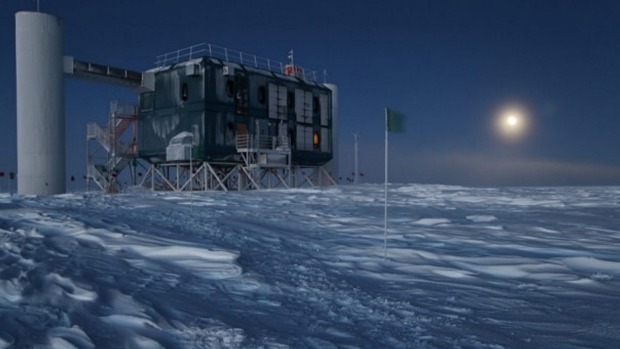
The IceCube detector is a cubic kilometre of Antarctic ice threaded with sensitive light detectors. Billions of cosmic neutrinos stream through us at the speed of light every second. Fortunately they have virtually no mass or charge, and generally don't interact with normal matter or we'd all look like Swiss cheese. And while we've known about them for 100 years, where these high energy particles come from and what's causing them to bolt across the universe has remained a mystery - until now.
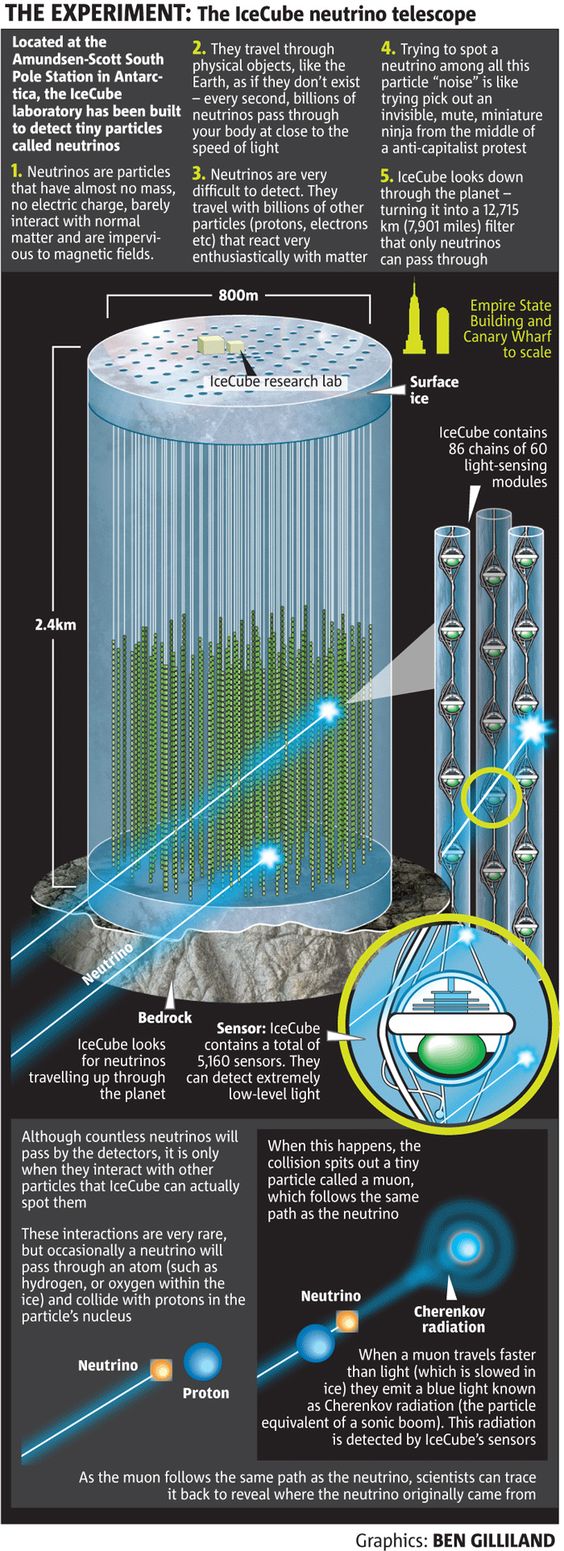
The IceCube neutrino telescope – searching for neutrinos overal diagram

The IceCube neutrino telescope – searching for neutrinos detail plan
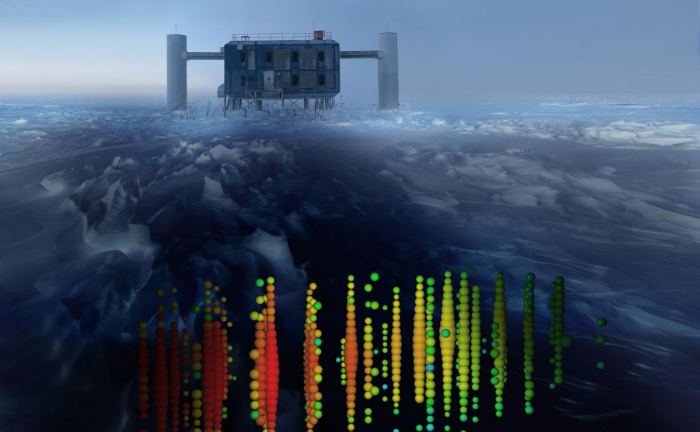
This image shows a visual representation of one of the highest-energy neutrino detections superimposed on a view of the IceCube Lab at the South Pole. Credit: IceCube Collaboration
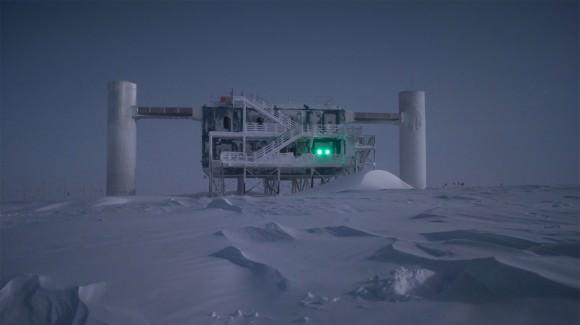
The Icetop Tank, the neutrino detectors at the heart of the IceCube Neutrino Observatory. Credit: Dan Hubert
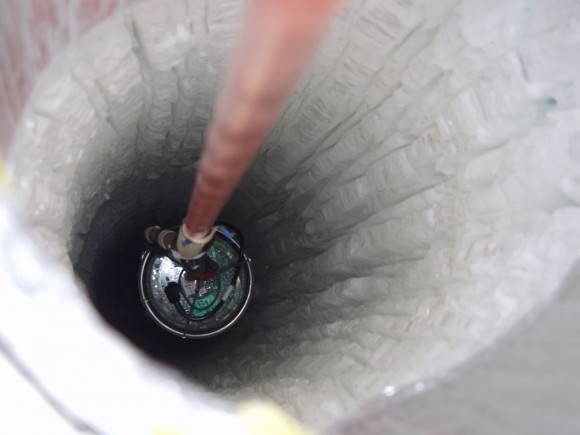
Looking down one of IceCube’s detector bore holes. Credit: IceCube Collaboration/NSF

This event display shows “Bert,” one of two neutrino events discovered at IceCube whose energies exceeded one petaelectronvolt (PeV). Credit: Berkeley Labs.
Green Bank Observatory Inaugurated
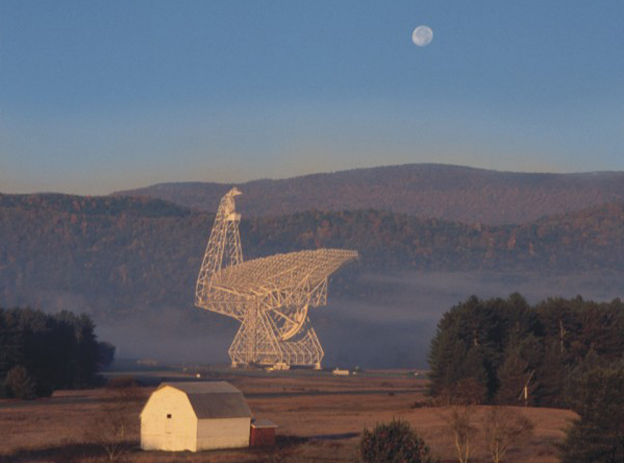
Green Bank Observatory Today(October 8, 2016) astronomers celebrate the inauguration of the Green Bank Observatory in West Virginia,
home to the 100-meter Green Bank Telescope, one of the world's most powerful astronomical instruments.
Formerly a cornerstone of the National Radio Astronomy Observatory (NRAO), the Green Bank Observatory
is now a fully-fledged, independent astronomical and educational facility of the National Science Foundation (NSF),
operated under a cooperative agreement with Associated Universities, Inc. (AUI).
THE Web site of the Murchison Widefield array
THE CLOSEST SUPERNOVA SINCE 1604 IS HISSING AT US
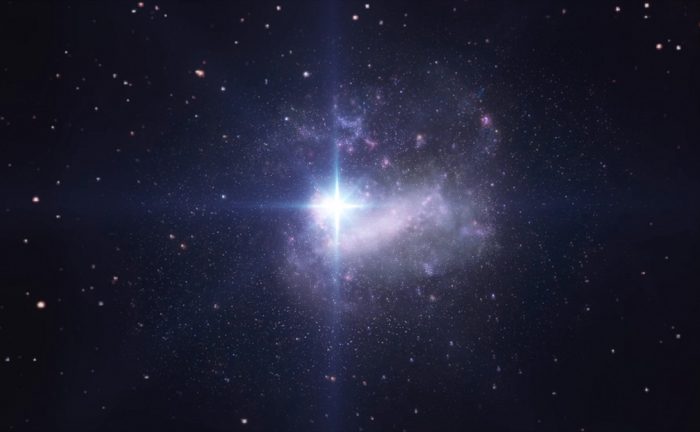
Artist’s impression of the supernova flare seen in the Large Magellanic Cloud on February 23rd, 1987.
Credit: CAASTRO / Mats Björklund (Magipics).
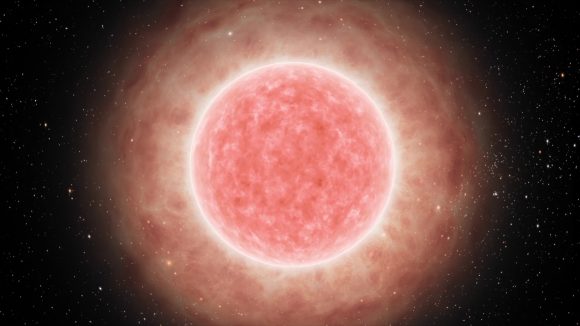
Artist’s impression of the star in its multi-million year long and previously unobservable phase as a large, red supergiant.
Credit: CAASTRO / Mats Björklund (Magipics)

Aerial photograph of the core region of the MWA telescope. Credit: mwatelescope.org
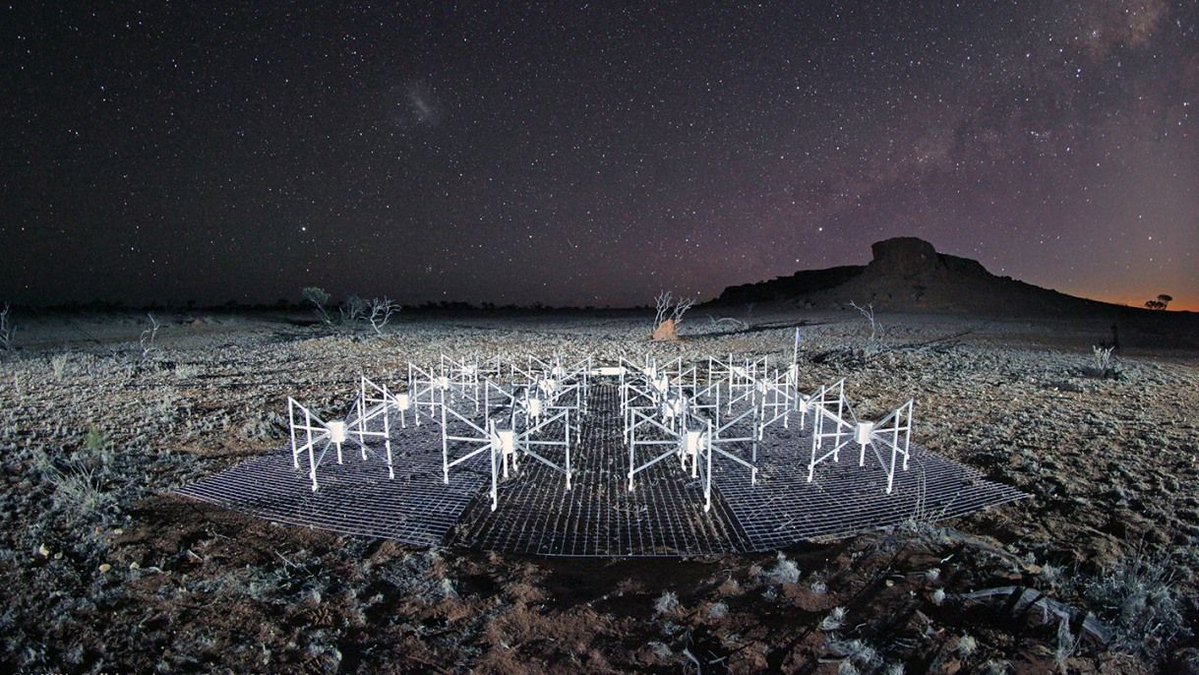
A team of scientists working with the Murchison Widefield Array (WMA) radio telescope are trying to find the signal from the Universe’s first stars. Those first stars formed after the Universe’s Dark Ages. To find their first light, the researchers are looking for the signal from neutral hydrogen, the gas that dominated the Universe after the Dark Ages.
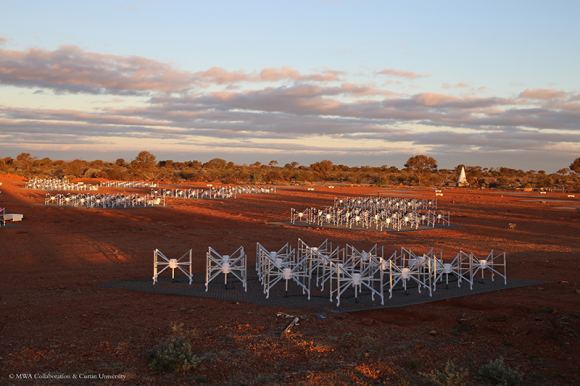
The Murchison Widefield Array consists of 256 tiles of receivers. Image Credit: MWA Collaboration/Curtin University.
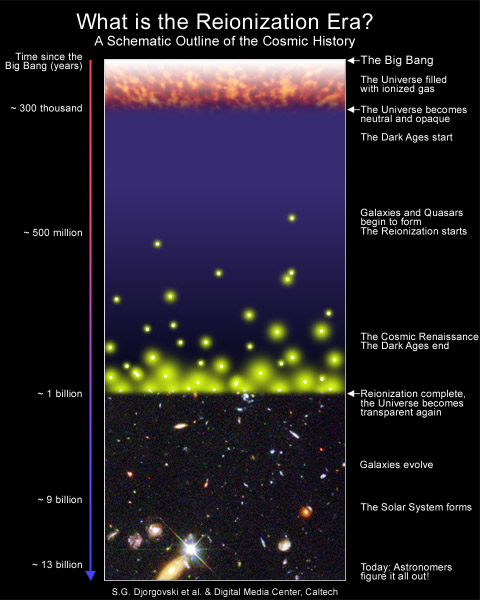
Graphical representation of the history of the universe, by Djorgovski et al, (Caltech).
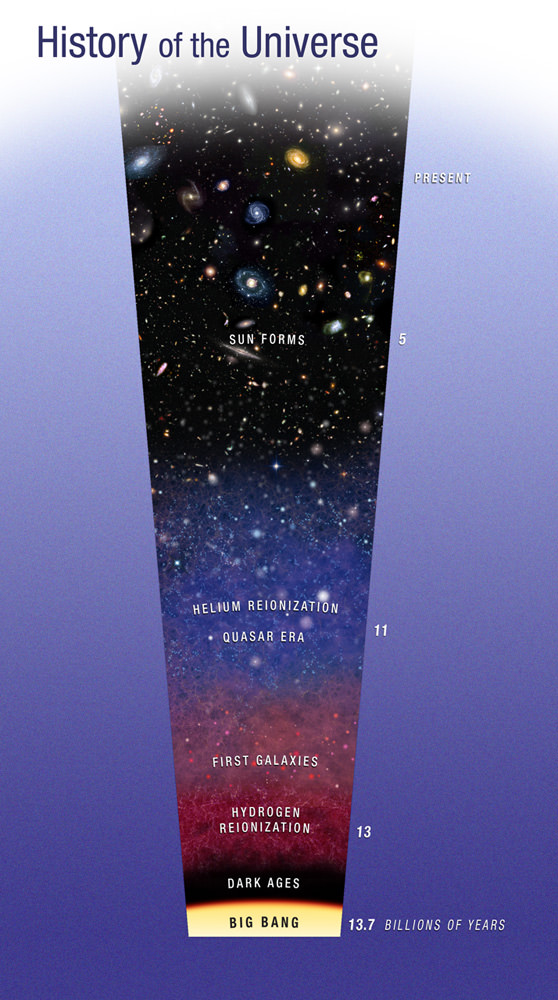
A diagram of the evolution of the universe from the big bang to the present, with two epochs of reionization. Credit: NASA, ESA, and A. Feild (STScI)

Part of the Murchison Widefield Array at night. Credit: John Goldfield/Celestial Visions
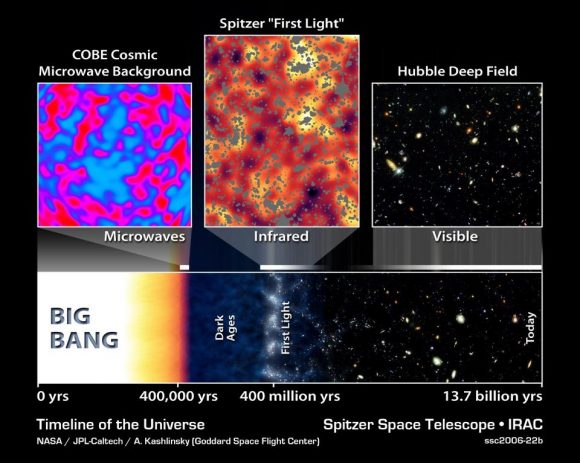
The Big Bang timeline of the Universe, showing when and in what wavelengths things became visible. Credit: NASA / JPL-Caltech / A. Kashlinsky (GSFC).
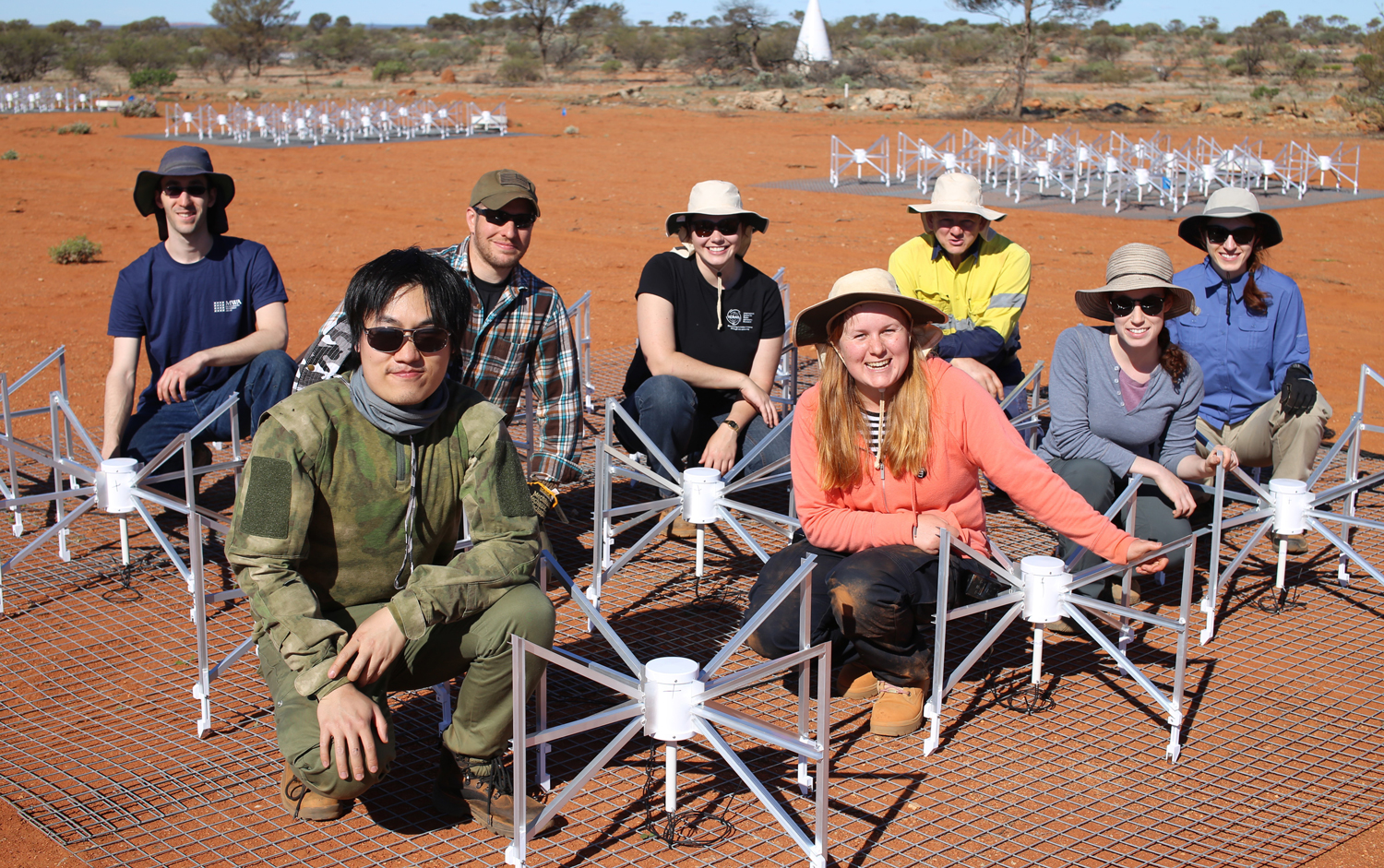
Students and researchers from Brown University, Curtin University and the UW building new antennas for the Murchison Widefield Array. Credit: MWA Collaboration/Curtin University
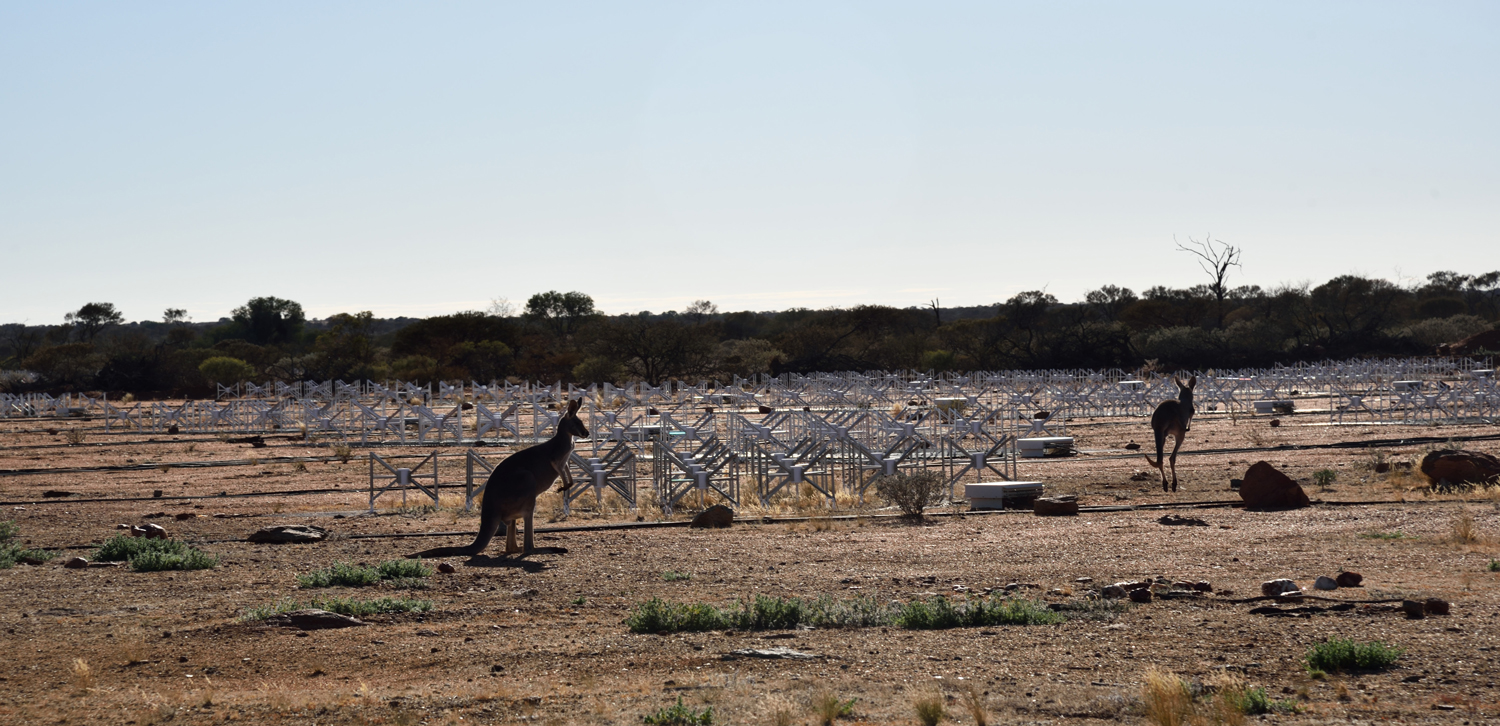
Kangaroos at the Murchison Widefield Array. Credit: MWA Collaboration/Curtin University

The Cherenkov Telescope Array prototype, located at the Serra La Nave observing stationon Mount Etna, Sicily.
Credit: CTA Observatory
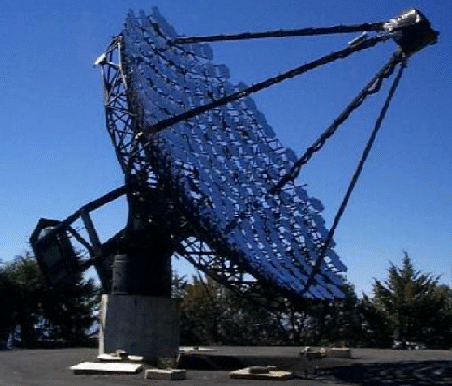
A IACT telescope at the Whipple Observatory, Mount Hopkins, Arizona.
Credit:
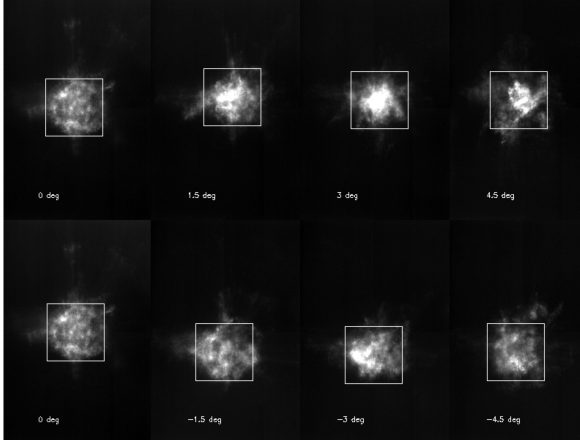
Polaris, the North Star, as observed by ASTRI with different offsets from the optical axis of the telescope.
Credits: Enrico Giro/Rodolfo Canestrari/Salvo Scuderi/Giorgia Sironi/INAF
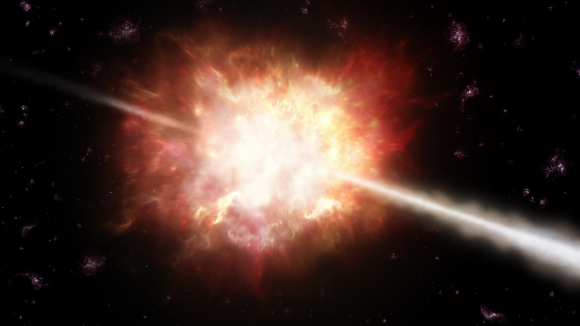
Artist’s impression of a gamma-ray burst. Credit: ESO/A. Roquette
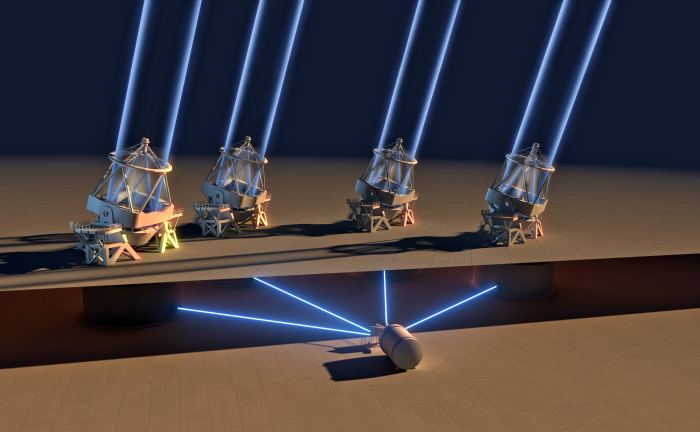
The ESPRESSO (Echelle SPectrograph for Rocky Exoplanet and Stable Spectroscopic Observations) instrument collects the light from all four of the 8.2-metre telescopes of the ESO's Very Large Telescope in Chile. The combined light-collecting area makes it the largest optical telescope in existence. Image: ESO/L. Calcada
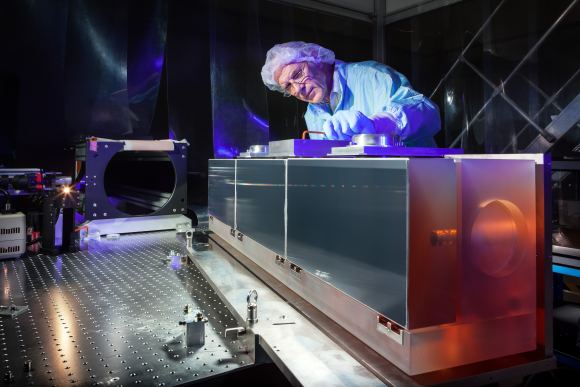
The huge diffraction grating is at the heart of the ultra-precise ESPRESSO spectrograph. In this image, the diffraction grating is undergoing testing in the cleanroom at ESO Headquarters in Garching bei München, Germany. Image: ESO/M. Zamani
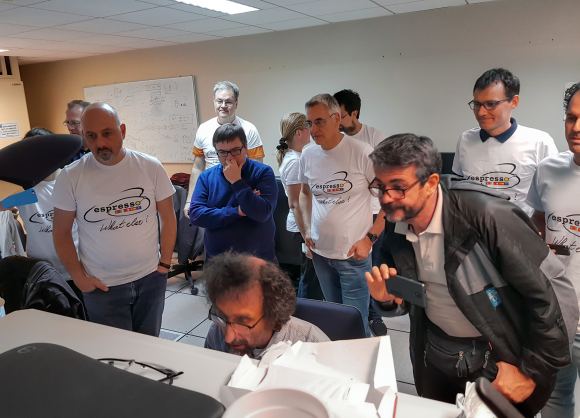
ESPRESSO team members gather in the control room during ESPRESSO’s first light. Image: ESO/D. Megevand

The four Unit Telescopes that make up the ESO’s Very Large Telescope, at the Paranal Observatory> Image: By ESO/H.H.Heyer CC BY 4.0 via Wikimedia Commons
Thanks to the European Southern Observatory
THANKS TO A MASSIVE RELEASE FROM GAIA, WE NOW KNOW WHERE 1.7 BILLION STARS ARE IN THE MILKY WAY

Gaia's all-sky view of our Milky Way Galaxy and neighbouring galaxies, based on measurements of nearly 1.7 billion stars. Copyright: ESA/Gaia/DPAC
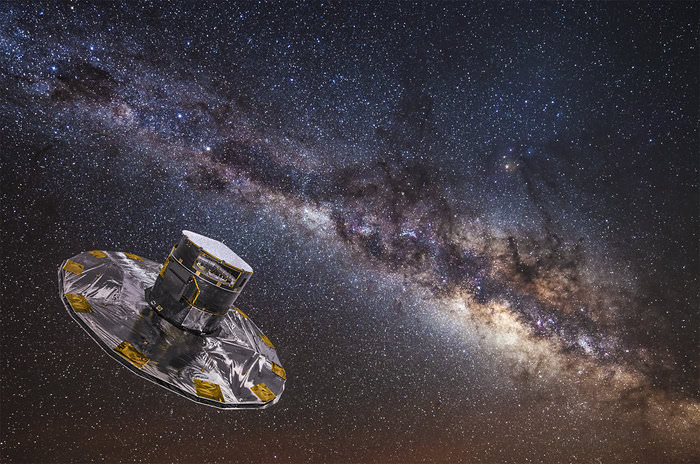
ESA’s Gaia is currently on a five-year mission to map the stars of the Milky Way. Image credit: ESA/ATG medialab; background: ESO/S. Brunier.
A virtual journey, from our Solar System through our Milky Way Galaxy, based on data from the first (left) and second (right) release of ESA’s Gaia satellite. The journey starts by looking back at the Sun, moving away and travelling between the stars. A comparison between the two views shows the huge increase in number of stars and distances from the Sun between the two data releases. The view on the left is based on the 3D position of 1.4 million stars for which parallaxes had been estimated using the Tycho-Gaia astrometric solution (TGAS) as part of the first Gaia data release, published in 2016. The view on the right is based on the 3D position of nearly 97 million stars from the second data release, published in 2018. The majority of these stars have the most accurate parallax measurements in the dataset, which can be used to directly estimate distances to individual stars. Credit: ESA/Gaia/DPAC Acknowledgement: Gaia Data Processing and Analysis Consortium (DPAC); Gaia Sky ; S. Jordan / T. Sagristà, Astronomisches Rechen-Institut, Zentrum für Astronomie der Universität Heidelberg, Germany
Gaia's first asteroid survey
Animated view of the 14 099 asteroids in our Solar System, as viewed by ESA’s Gaia satellite using information from the mission’s second data release. The orbits of the 200 brightest asteroids are also shown, as determined using Gaia data. In future data releases, Gaia will also provide asteroid spectra and enable a complete characterisation of the asteroid belt. The combination of dynamical and physical information that is being collected by Gaia provides an unprecedented opportunity to improve our understanding of the origin and the evolution of the Solar System. Credit: ESA/Gaia/DPAC Acknowledgement: Gaia Data Processing and Analysis Consortium (DPAC); Orbits: Gaia Coordinating Unit 4; P. Tanga, Observatoire de la Côte d'Azur, France; F. Spoto, IMCCE, Observatoire de Paris, France; Animation: Gaia Sky S. Jordan / T. Sagristà, Astronomisches Rechen-Institut, Zentrum für Astronomie der Universität Heidelberg, Germany
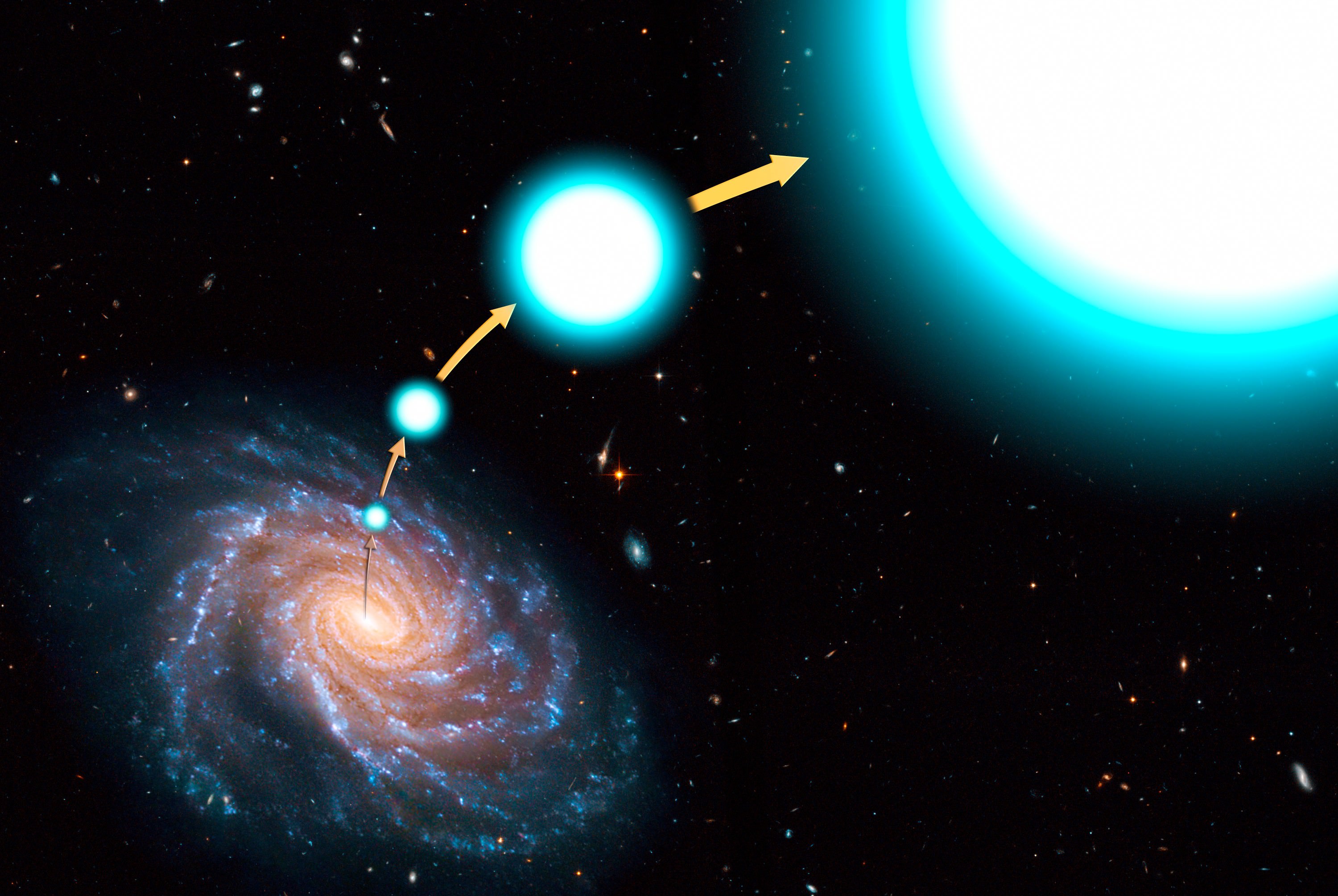
In December of 2013, the European Space Agency (ESA) launched the Gaia mission. Since that time, this space observatory has been busy observing over 1 billion astronomical objects in our galaxy and beyond – including stars, planets, comets, asteroids, quasars, etc. – all for the sake of creating the largest and most precise 3D space catalog ever made.
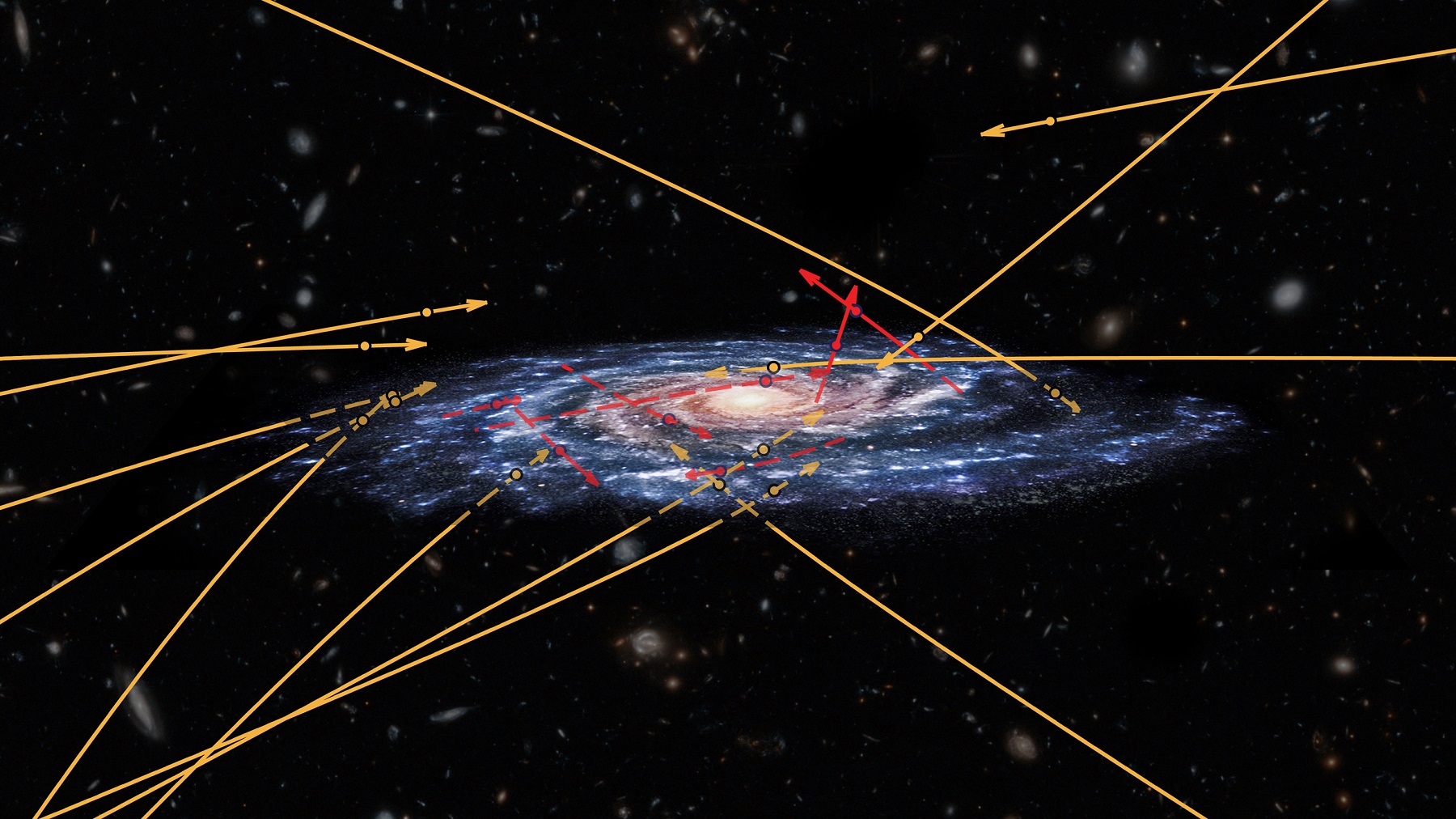
The positions and reconstructed orbits of 20 high-velocity stars, represented on top of an artistic view of our Galaxy, the Milky Way. Credit: ESA/Marchetti et al. 2018/NASA/Hubble
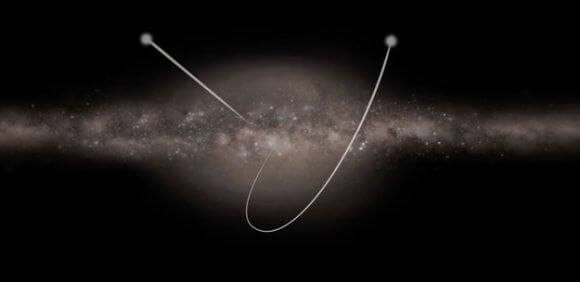
Artist’s impression of hyper-velocity stars speeding through the Milky Way Galaxy. Credit: ESA
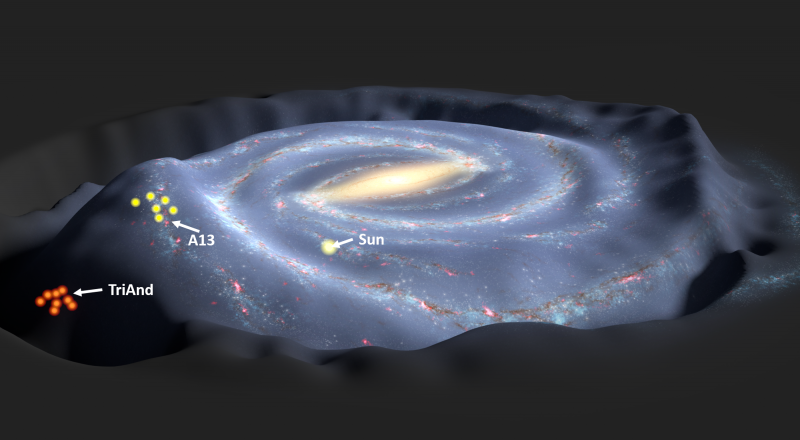
The Milky Way galaxy, perturbed by the tidal interaction with a dwarf galaxy, as predicted by N-body simulations. Credit: T. Mueller/C. Laporte/NASA/JPL-Caletch
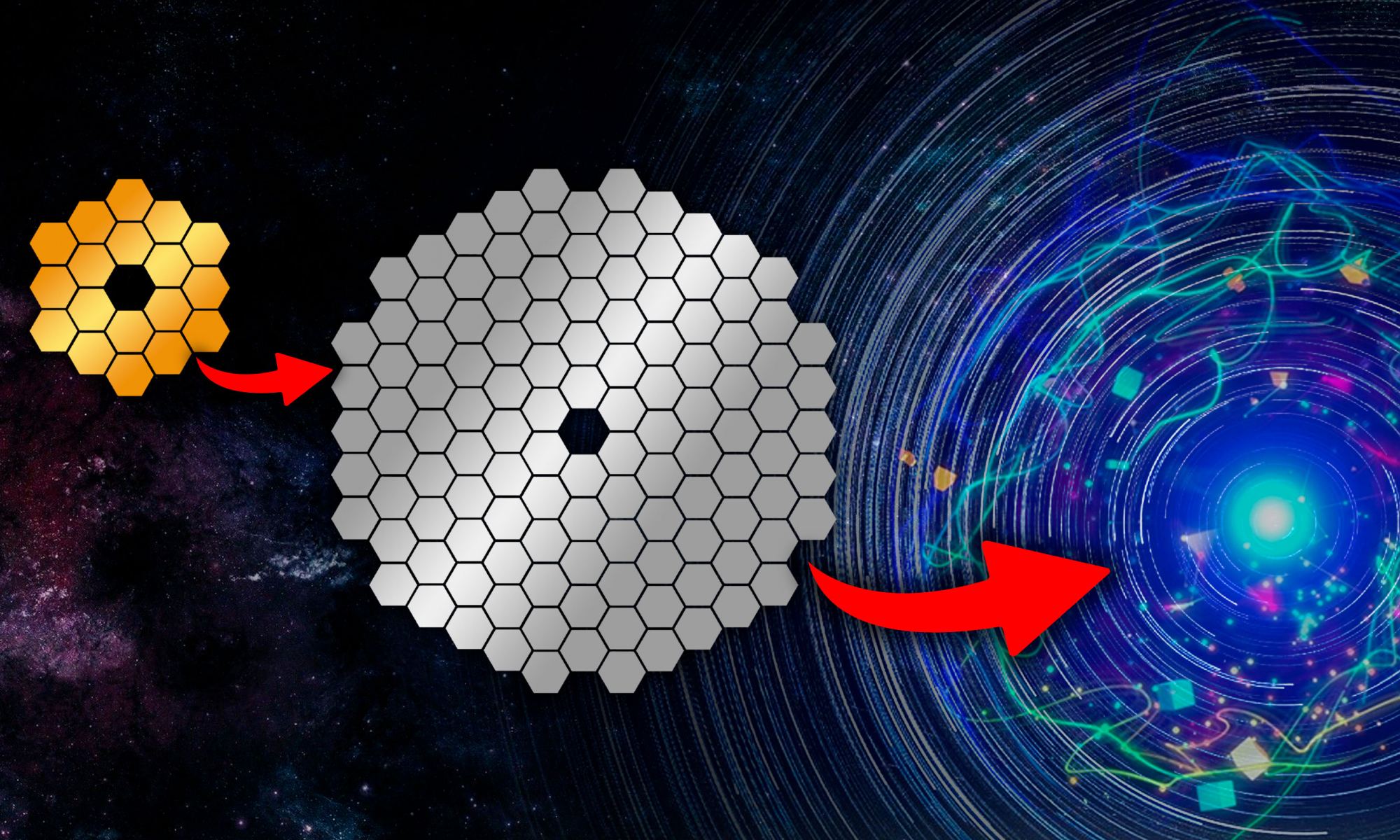
Beyond James Webb and LUVOIR, the future of astronomy could come down to telescopes that rely on quantum mechanics. Credit: Anton Pozdnyakov
The Event Horizon Telescope (EHT) is an international collaboration aiming to capture the first image of a black hole by creating a virtual Earth-sized telescope. This short animated movie explains some of the nuts and bolts behind this ambitious endeavour. To learn more, visit the official EHT website, You can also find the EHT on Twitter -- and on Facebook -- Credits: Animation: Chris Jones Screenplay: Smithsonian Astrophysical Observatory Narration: Alex Hanson Funded by: National Science Foundation Category Science & Technology

Researchers using the Event Horizon Telescope hope to generate images like this of Sag. A’s event horizon. The bright regions are hot gas surrounding the black hole. The circular dark region is a shadow cast by the strong gravity of the black hole. Image Credit: EHT.
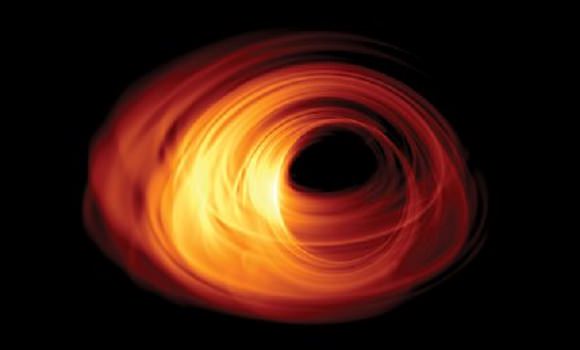
Simulated view of a black hole. Credit: Bronzwaer/Davelaar/Moscibrodzka/Falcke, Radboud University
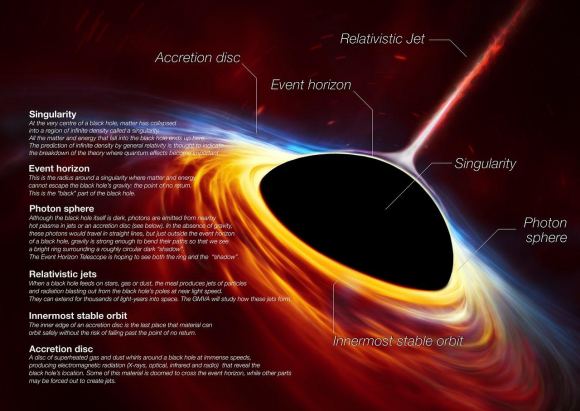
Click to enlarge. This artist’s impression depicts a rapidly spinning supermassive black hole surrounded by an accretion disc. This thin disc of rotating material consists of the leftovers of a Sun-like star which was ripped apart by the tidal forces of the black hole. Shocks in the colliding debris as well as heat generated in accretion led to a burst of light, resembling a supernova explosion. Image Credit: SO, ESA/Hubble, M. Kornmesser/N. Bartmann
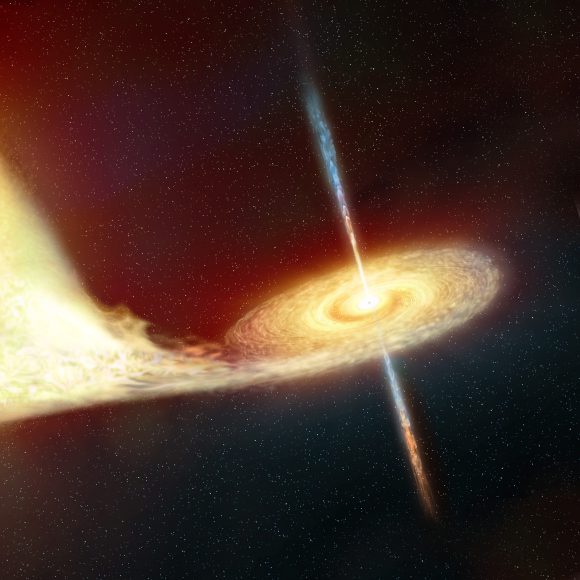
Artist’s impression of a feeding stellar-mass black hole. Some black holes shoot out jets of material, some don’t. Credit: NASA, ESA, Martin Kornmesser (ESA/Hubble) Another question is why do some black holes emit jets of material, while other don’t? Our own black hole, Sag. A*, doesn’t emit jets of material, while the other one in the EHT’s sights, in the M87 galaxy, does. Maybe the EHT will help answer that puzzling question.
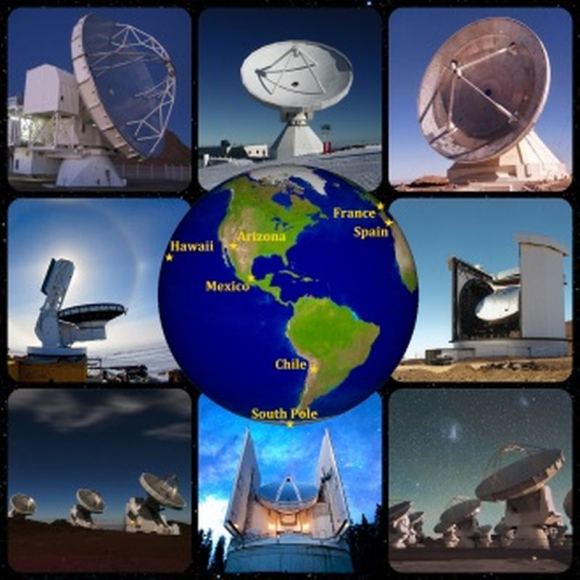
The EHT is seven separate facilities around the world linked through interferometry. The EHT should give us the first image of a black hole’s event horizon. Image Credit: EHT.
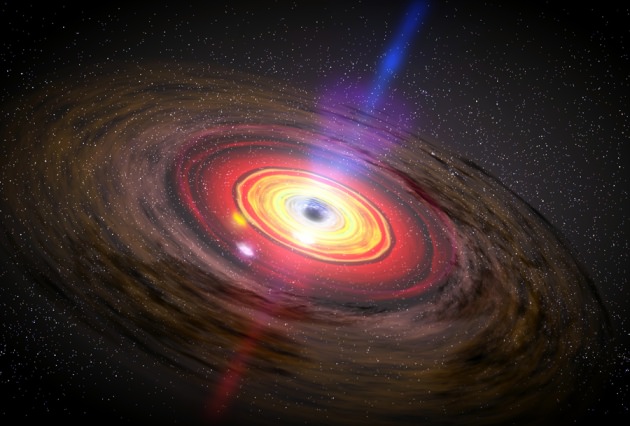
An artist’s conception of a supermassive black hole’s jets. Credit: NASA / Dana Berry / SkyWorks Digital
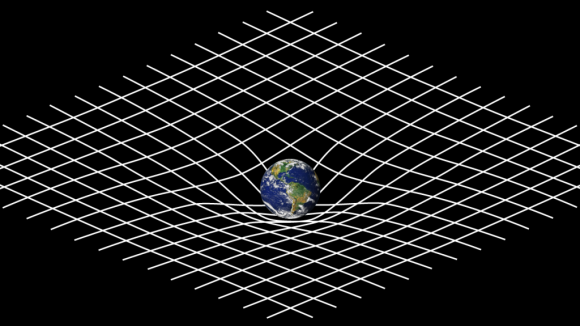
This illustration shows how, according to General Relativity, even Earth warps space time and draws objects towards it. A super massive black hole like Sagittarius A would space time much more, and would draw even light towards it. Image Credit: NASA
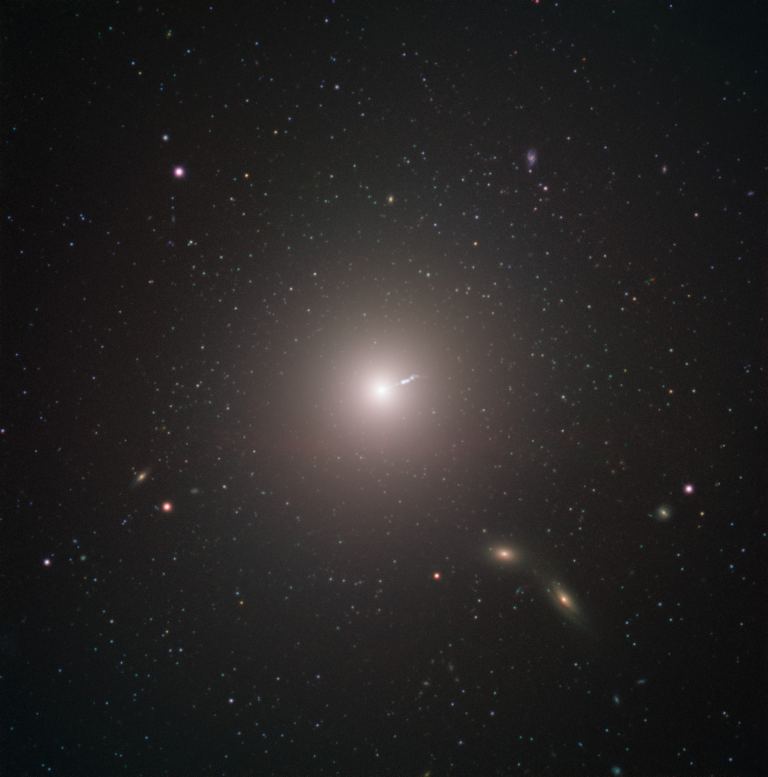
An optical image of the M87 galaxy captured by the European Southern Observatory’s Very Large Telescope. M87* lies at the very center of that bright mass. Image Credit: ESO
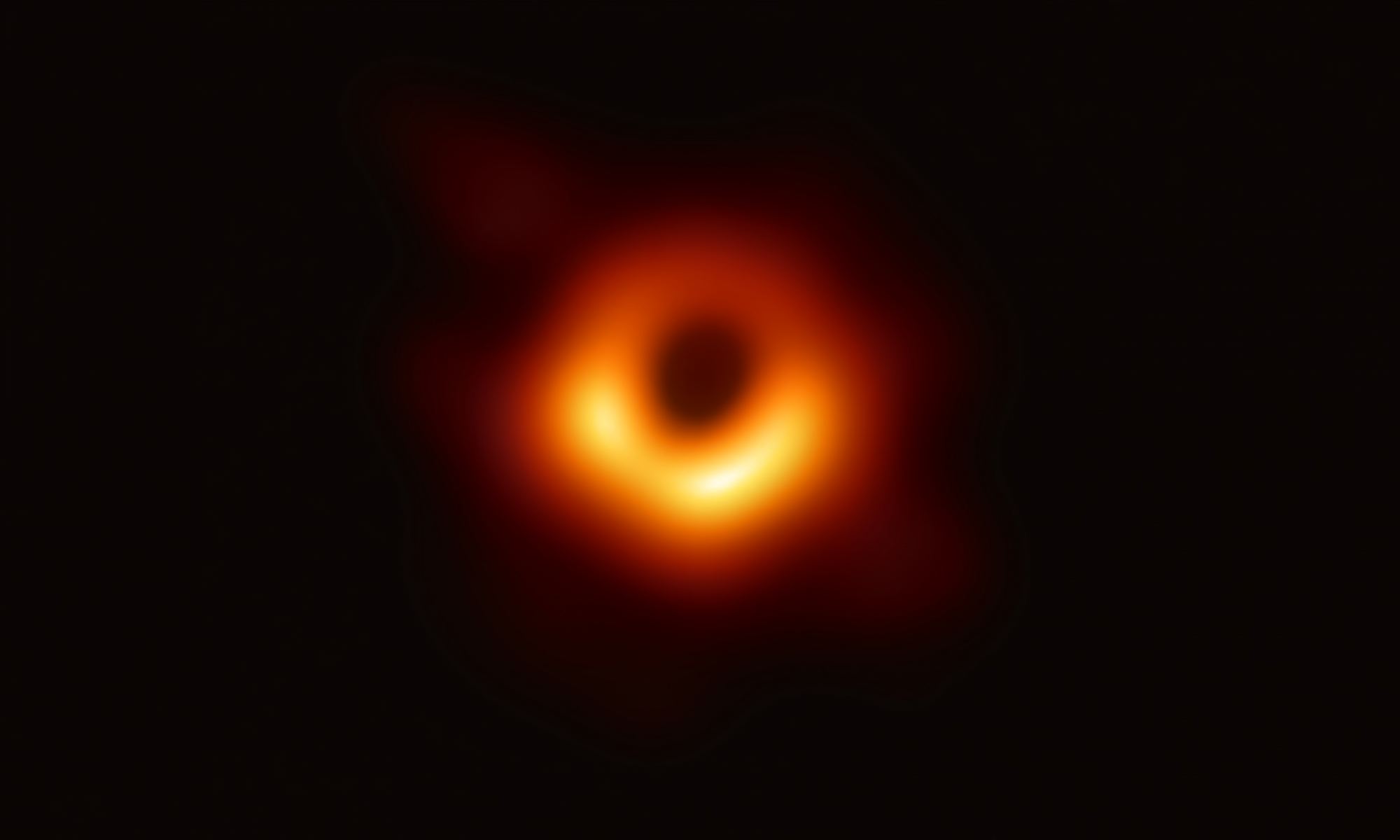
The Event Horizon Telescope (EHT) — a planet-scale array of eight ground-based radio telescopes forged through international collaboration — was designed to capture images of a black hole. The first image is of M87* at the center of the M87 galaxy. Image Credit: EHT Collaboration.
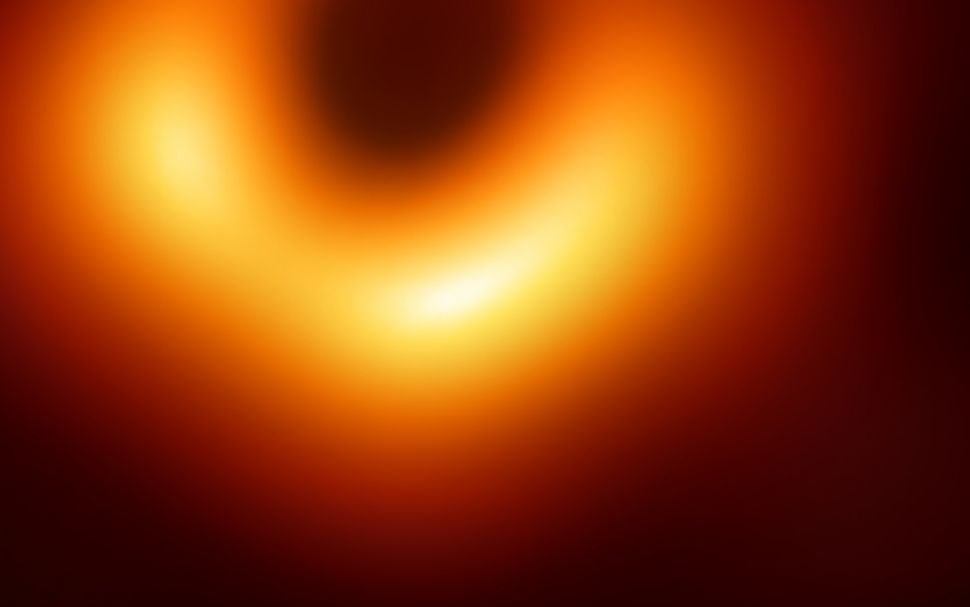
It took eight telescopes and more than 200 astronomers to produce an astonishing, never-before-seen image of a distant black hole.(Close up) (Image: © Event Horizon Telescope collaboration, et al.)
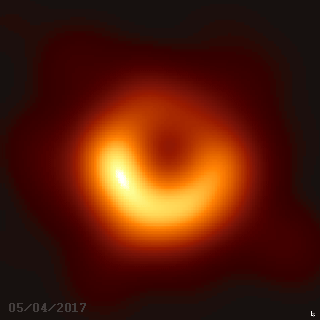
AN Animation of the M67 Black Hole
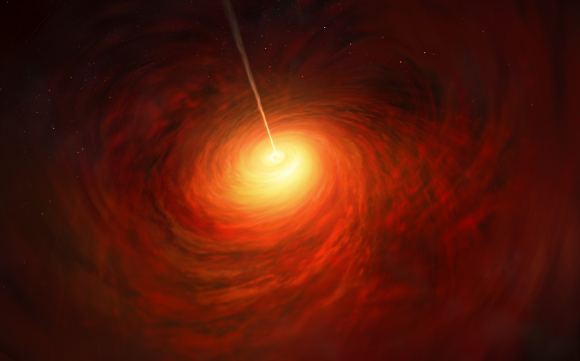
This artist’s impression depicts the black hole at the heart of the enormous elliptical galaxy Messier 87 (M87). This black hole was chosen as the object of paradigm-shifting observations by the Event Horizon Telescope. The superheated material surrounding the black hole is shown, as is the relativistic jet launched by M87’s black hole. ESO/M. Kornmesser

In anticipation of the first image of a black hole, Jordy Davelaar and colleagues built a virtual reality simulation of one of these fascinating astrophysical objects. Their simulation shows a black hole surrounded by luminous matter. This matter disappears into the black hole in a vortex-like way, and the extreme conditions cause it to become a glowing plasma. The light emitted is then deflected and deformed by the powerful gravity of the black hole. Image Credit: Jordy Davelaar et al./Radboud University/BlackHoleCam
On 10 April 2019 at 15:00 CEST (Brussels time) the European Commission presented a ground-breaking discovery by Event Horizon Telescope - an international scientific collaboration aiming to capture the first image of a black hole by creating a virtual Earth-sized telescope. EU-funded researchers play a key role in the project. Black holes are extremely compressed cosmic objects, containing incredible amounts of mass within a tiny region. Their presence affects their surroundings in extreme ways, by warping spacetime and super-heating any material falling into it. The captured image reveals the black hole at the centre of Messier 87, a massive galaxy in the constellation of Virgo. This black hole is located 55 million light-years from Earth and has a mass 6.5-billion times larger than our sun. Six press conferences around the world took place simultaneously. In Europe, Commissioner Moedas and lead scientists funded by the European Research Council held a press conference in Brussels to unveil the discovery. Panelists: - Carlos Moedas, European Commissioner for Research, Science and Innovation - Prof. Anton Zensus, Director at Max-Planck-Institut für Radioastronomie, Bonn, Germany (Chair of the EHT Collaboration Board) - Prof. Heino Falcke, Radboud University, Nijmegen, The Netherlands (Chair of the EHT Science Council) - Dr Monika Mościbrodzka, Radboud University, Nijmegen, The Netherlands (EHT Working Group Coordinator) - Prof. Luciano Rezzolla, Goethe Universität, Frankfurt, Germany (EHT Board Member) - Prof. Eduardo Ros, Max-Planck-Institut für Radioastronomie, Bonn, Germany, (EHT Board Secretary) EC press release: Scientific press release by EHT: : More insights by Jonathan O’Callaghan's article Behind the scene with the black hole scientists: #EHTBlackHole #BlackHoleDay #RealBlackHole #BlackHoles
Anton Petrov Streamed live on Apr 10, 2019 Hello and welcome! My name is Anton and in this video, we get to the the real photo of a black hole that's about released by the Event Horizon Telescope on April 10. More about this later!
Perimeter Institute for Theoretical Physics Published on Apr 10, 2019 Scientists from the Event Horizon Telescope (EHT) collaboration explain how they created an "Earth-sized" telescope to capture humanity's historic first image of a black hole. Learn more: about thePerimeter Institute Download free posters celebrating the EHT and the landmark image it attained: The EHT Collaboration consists of 13 stakeholder institutes; the Academia Sinica Institute of Astronomy and Astrophysics, the University of Arizona, the University of Chicago, the East Asian Observatory, Goethe-Universitaet Frankfurt, Institut de Radioastronomie Millimétrique, Large Millimeter Telescope, Max Planck Institute for Radio Astronomy, MIT Haystack Observatory, National Astronomical Observatory of Japan, Perimeter Institute for Theoretical Physics, Radboud University and the Smithsonian Astrophysical Observatory.
Sign up to my weekly email newsletter: Support us at:Support us at: Follow us on Tumblr: : More stories at Follow us on Twitter: @universetoday Like us on Facebook: Instagram -
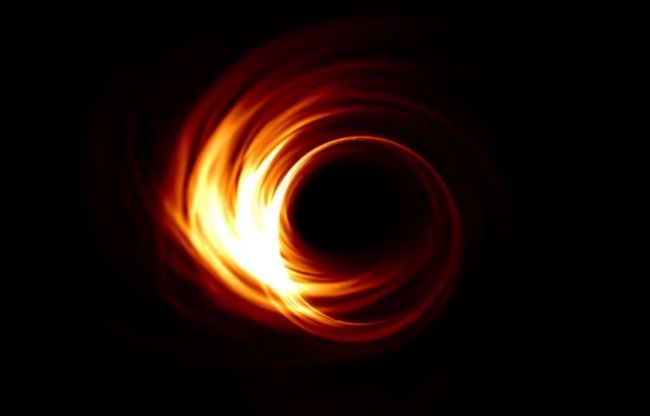
A still of a video simulation that shows what a black hole shadow might look like. The animation was featured in a short movie about the Event Horizon Telescope (EHT) project, produced by Peter Galison and Chyld King. Watch a livestreamed announcement of the Event Horizon Telescope's first results on April 10, 2019 at 9 a.m. EDT here.
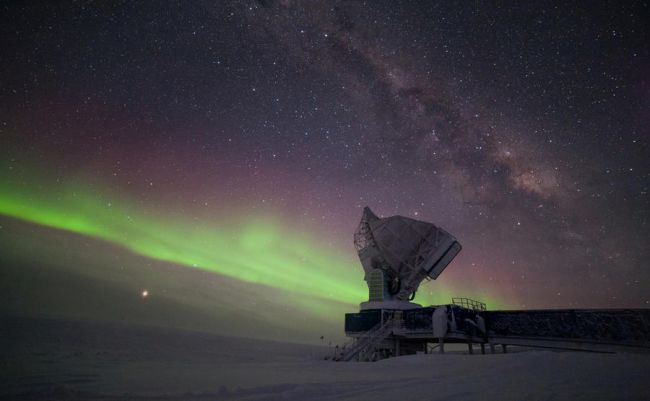
The South Pole Telescope illuminated by the Milky Way and the Aurora Australis (Southern Lights). Watch a livestreamed announcement of the Event Horizon Telescope's first results on April 10, 2019 at 9 a.m. EDT here.

The Event Horizon Telescope network, mapped on GoogleMaps with data from NASA and TerraMetrics. Watch a livestreamed announcement of the Event Horizon Telescope's first results on April 10, 2019 at 9 a.m. EDT here.
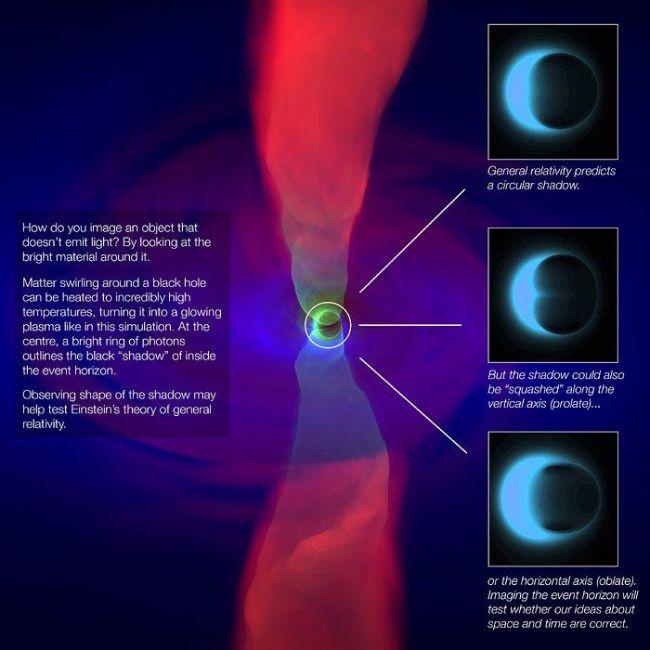
This infographic shows a simulation of the outflow (bright red) from a black hole and the accretion disk around it, with simulated images of the three potential shapes of the event horizon's shadow. CREDIT (Image: © ESO/N. Bartmann/A. Broderick/C.K. Chan/D. Psaltis/F. Ozel)
You can buy Universe Sandbox 2 game here: Hello and welcome! My name is Anton and in this video, we will talk about a new discovery coming from the M87 black hole also know as Powehi - this study discovers its spin. Study:(PDF) Luminet's paper:(PDF) Support this channel on Patreon to help me make this a full time job: Space Engine is available for free here: Twitter: Facebook: Twitch:
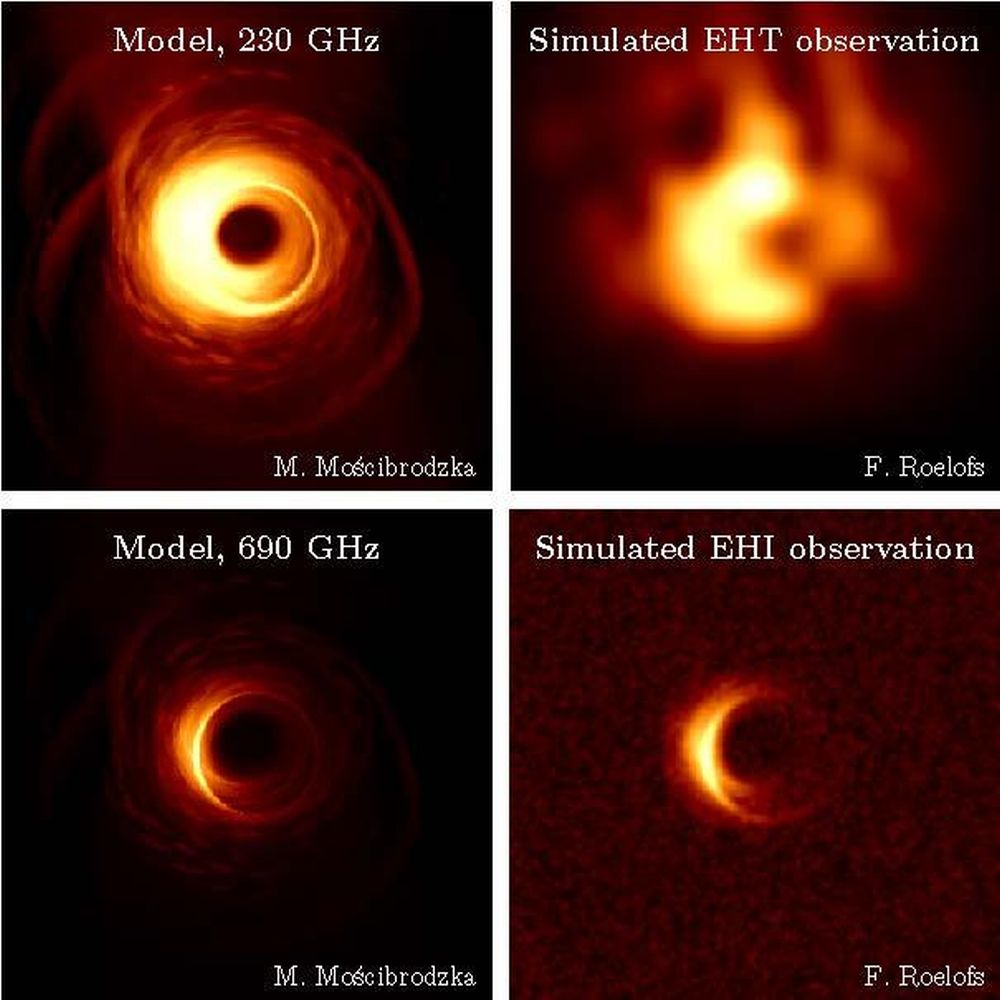
The EHI could capture images with a resolution five times higher than the EHT. Image Credit: F. Roelofs and M. Moscibrodzka, Radboud University Now a group of astronomers from the Radboud University in the city of Nijmegen, Netherlands, along with the European Space Agency and other partners, are developing a plan to get much sharper pictures of black holes.
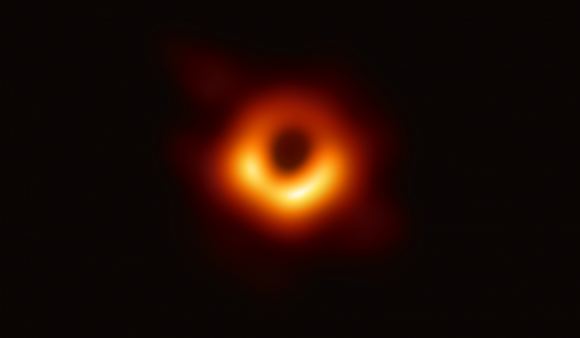
The Event Horizon Telescope (EHT) — a planet-scale array of eight ground-based radio telescopes forged through international collaboration — was designed to capture images of a black hole. The shadow of a black hole seen here is the closest we can come to an image of the black hole itself, a completely dark object from which light cannot escape. Image Credit: EHT.

The ALMA array in Chile, part of the EHT. Image: ALMA (ESO/NAOJ/NRAO), O. Dessibourg
This artist’s impression depicts the black hole at the heart of the enormous elliptical galaxy M87. This black hole was chosen as the object of paradigm-shifting observations by the Event Horizon Telescope. The superheated material surrounding the black hole is shown, as is the relativistic jet launched by M87’s black hole. : More information and download options Credit: ESO/M. Kornmesser

In 2019 astronomers captured the first direct image of a black hole. It was an image of the supermassive black hole at the heart of M87. And when many folks saw it, their reaction was “that’s it?” Which is understandable, given that the image is just a blurry, donut-shaped smudge. It isn’t much to look at. But an astronomical image is a small fraction of the data gathered by astronomers. Recently more of that data has been analyzed, including both the polarization of the light and the magnetic field surrounding the black hole.

M51 (Hubble) overlaid by 6cm radio intensity contours and polarization vectors (Effelsberg and VLA) Credit: MPIfR Bonn

An image of the M87 black hole with polarization indicated. Credit: EHT Collaboration

The high-altitude Tokyo Atacama Observatory in Chile just opened its eye on the mid-infrared Universe. ©2024 TAO project CC-BY-ND

At 5,640 meters,(18,504 feet) the summit of Cerro Chajnantor, where Tokyo Atacama Observatory is located, allows the telescope to be above most of the moisture that would otherwise limit its infrared sensitivity. ©2024 TAO project CC-BY-ND

A schematic of the Tokyo Atacama Observatory telescope. Courtesy TAO project.
information on The event Horizon Telescope is trying to Photgraph a black hole

Image: Light from a distant star is deflected by the atmosphere of the Earth by half a degree. After skimming the surface, it is bent again as it exits the atmosphere by one-half a degree. Light entering the opposite hemisphere does the same, creating a focal point. Rays entering the atmosphere higher up bend less because the atmosphere is thinner with altitude, so the result is a focal line. The trick is knowing which light can be effectively sampled. Image credit: David Kipping.
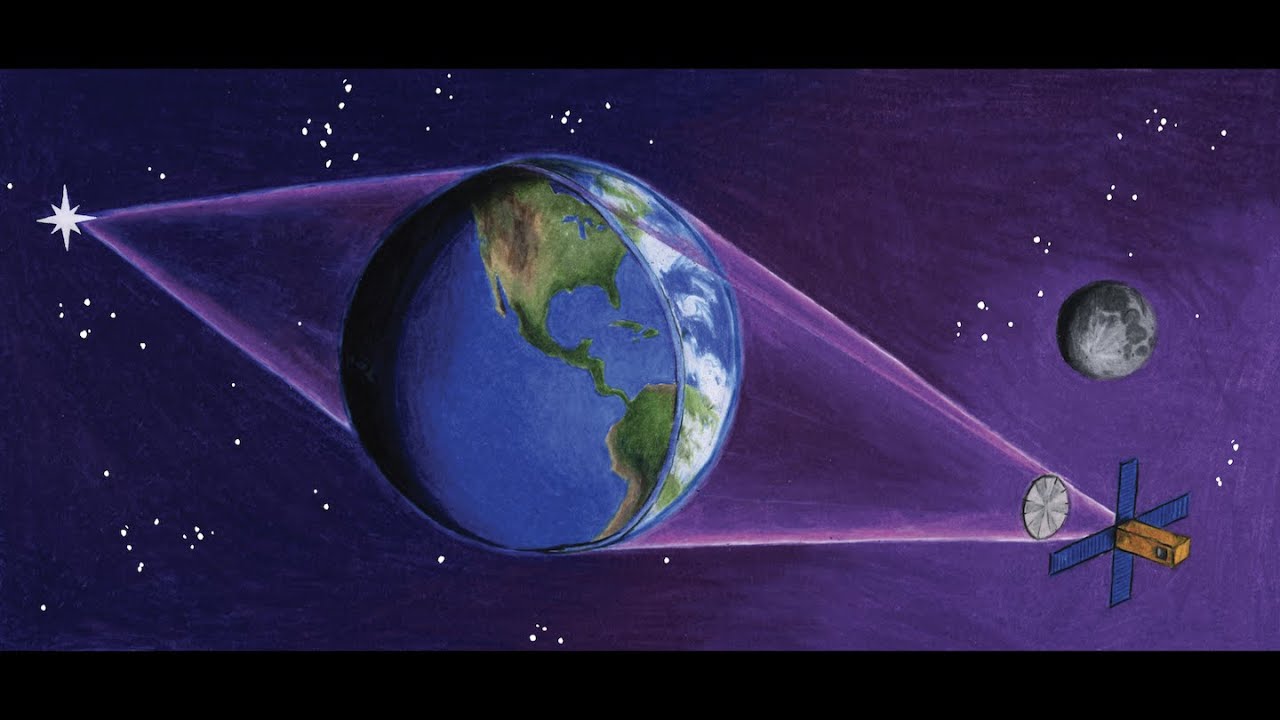
I just love extreme ideas for ground and space-based telescopes, and Professor David Kipping from Columbia University's Cool Worlds Lab has presented an incredible idea for turning the entire planet into the lens of a telescope, thanks to the refractive power of the atmosphere. It could be the equivalent of a 150-meter telescope, detecting very faint objects as they change in brightness.
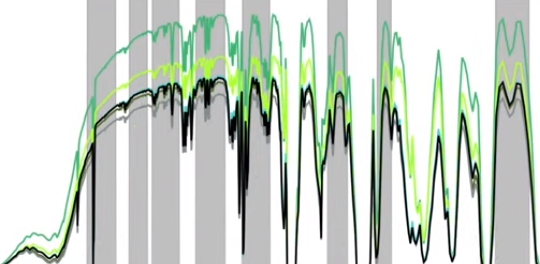
Image: Extinction effects for a terrascope at the Hill Sphere distance, roughly 4 Earth radii. Here, most of the infrared spectrum becomes usable for lensing. Image credit: David Kipping.
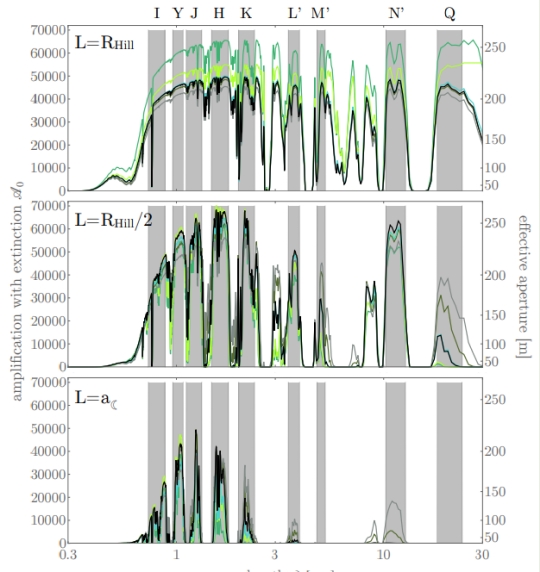
Image: This is Figure 11 from the paper. Caption: Amplification after extinction expected for a 1 metre diameter telescope at the Earth’s Hill radius (top), half the Hill radius (middle) and the Moon’s separation (bottom). Six atmosphere models are shown… [the color coding is provided in the paper, q.v.], which control temperature-pressure profiles (and thus refractivity profile) as well as the extinction computed using lowtran7 [a propagation model and computer code for predicting atmospheric transmittance and sky thermal and scattered radiance]. All models assume no clouds. Standard photometric filters highlighted in gray, except for L, M and N which are slightly offset to encompass the optimal regions. Credit: David Kipping.
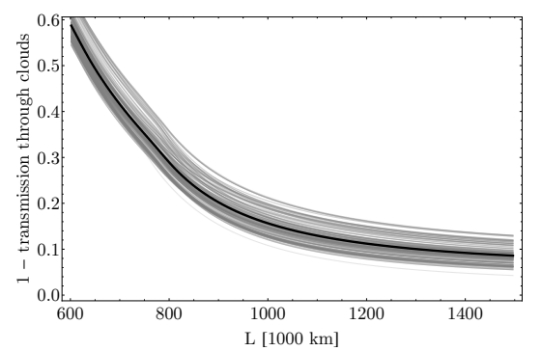
Image: This is Figure 13 from the paper. Estimated transmission through the Earth’s atmosphere due to clouds for a Terrascope detector at a distance L. At one Hill radius (1,500,000 km), lensed rays travel no deeper than 13.7 km and thus largely avoid clouds, thereby losing less than 10% of the lensed light. Credit: David Kipping.
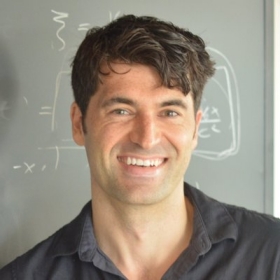
Image: Columbia University physicist David Kipping. Of course, in our current stage of technological development, FOCAL itself is quite a reach, given our problems in getting to the outer Solar System — our farthest-flung craft even now are but a third of the way to where the lensing phenomenon could begin to be exploited. Well aware of this, David Kipping wondered if there wasn’t a way to explore the ‘bending’ of light in a different way, one that could help us learn how to untangle complex lensed images and develop near-term technologies at distances much closer to home. And it turns out there is, although it’s not a proposal that relies on gravitational lensing but rather the refraction of light.
When it comes to telescopes, bigger is better. That's why we're investing billions of dollars into a new generation of "extremely large telescopes", such as the Thirty Meter Telescope (TMT). But is 30 meters truly extreme? Could it be possible to ever build a telescope on the scale of a planet? In a new research paper by our very own Professor David Kipping, a solution for turning the Earth into a "Terrascope" is presented. Join us on a journey though the history of telescope inventions as well David's own personal journey to devising this new radical approach to the telescope. Written and Presented by Professor David Kipping The Terrascope paper can be found at: ► Kipping, David (2019), "The Terrascope: On the Possibility of Using the Earth as an Atmospheric Lens", PASP, accepted for publication:(PDF) Chapters 0:00 - Prologue 0:43 - Telescopes through Time 7:48 - Natural Lensing 14:02 - The Green Flash 18:55 - The Terrascope 26:42 - Dreams of Our Youth Video materials and graphics used: ► JWST timelapse from NASA's Goddard Space Flight Center: ► GTC footage by Gianluca Lombardi: ► ELT animation by ESO & Herbert Zodet: ► GMT mirror casting by University of Arizona Steward Observatory Mirror Lab: ► Water lensing clips by Spa Nederland: ► NASA/International Space Station footage of the Earth ► Green Flash footage by Mila Zinkova: ► Earth timelapse taken by EPIC onboard NOAA's DSCOVR satellite, video by NASA's Goddard Space Flight Center/Kayvon Sharghi: ► WFIRST animation by NASA's Goddard Space Flight Center/Conceptual Image Lab: ► JWST deployment animation by NASA/Goddard Space Flight Center: Movies/TV scenes used: ► Interstellar (2014) ► Sunshine (2007) ► Einstein and Eddington (2008) Music used, in chronological order: ► "Waking Up" by Atlas, licensed through SoundStripe.com: ► Music from Neptune Flux, "The Oceans Continue to Rise" by Chris Zabriskie (licensed under a Creative Commons Attribution license ► Music from Honor, "The Sun Is Scheduled to Come Out Tomorrow" by Chris Zabriskie );( licensed under a Creative Commons Attribution license ► Music from Neptune Flux, "Stories About the World That Once Was" by Chris Zabriskie ); (licensed under a Creative Commons Attribution license ► "It's Always Darkest Before the Dawn" by Hill, licensed through SoundStripe.com: ► "Waking Up" by Atlas, licensed through SoundStripe.com: ► "Reverence" by Triad, licensed through SoundStripe.com: ► Cylinder Two ) (by Chris Zabriskie ); ( licensed under a Creative Commons Attribution license ) ► Music from Honor, "The Sun Is Scheduled to Come Out Tomorrow" by Chris Zabriskie (licensed under a Creative Commons Attribution license ) And also... ► Columbia University Department of Astronomy: ► Cool Worlds Lab website: ::Playlists For Channel:: Latest Cool Worlds Videos ► Cool Worlds Research ► Cool Worlds Long Form Videos ► Guest Videos ► Q&A Videos ► Tabby's Star ► Science of TV/Film ► ::Follow us:: SUBSCRIBE to the channel THANKS FOR WATCHING!! #Terrascope #EarthSizedTelescope #CoolWorlds
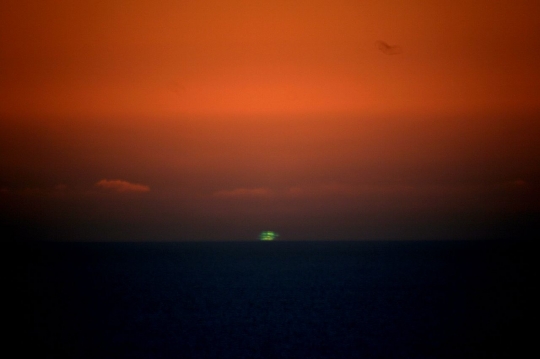
Image: The green flash as seen in Santa Cruz, VA. Credit: Brocken Inaglory CC BY-SA 3.0.
P>
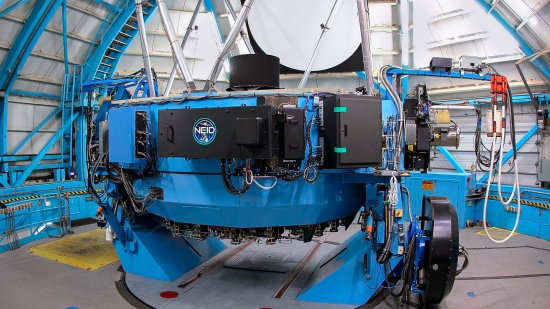
Image: The NEID instrument, mounted on the 3.5-meter WIYN telescope at the Kitt Peak National Observatory. The NASA-NSF Exoplanet Observational Research (NN-EXPLORE) partnership funds NEID (short for NN-EXPLORE Exoplanet Investigations with Doppler spectroscopy). Credit: NSF’s National Optical-Infrared Astronomy Research Laboratory/KPNO/NSF/AURA.
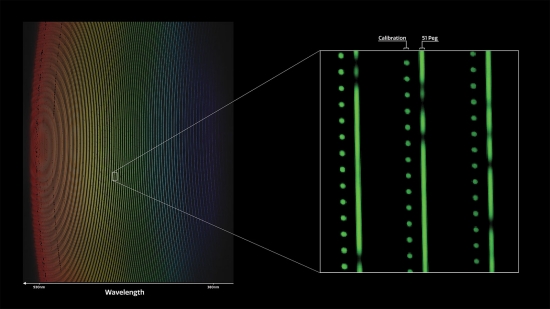
Image: The left side of this image shows light from the star 51 Pegasi spread out into a spectrum that reveals distinct wavelengths. The right-hand section shows a zoomed-in view of three wavelength lines from the star. Gaps in the lines indicate the presence of specific chemical elements in the star. Credit: Guðmundur Kári Stefánsson/Princeton University/NSF’s National Optical-Infrared Astronomy Research Laboratory/KPNO/NSF/AURA.
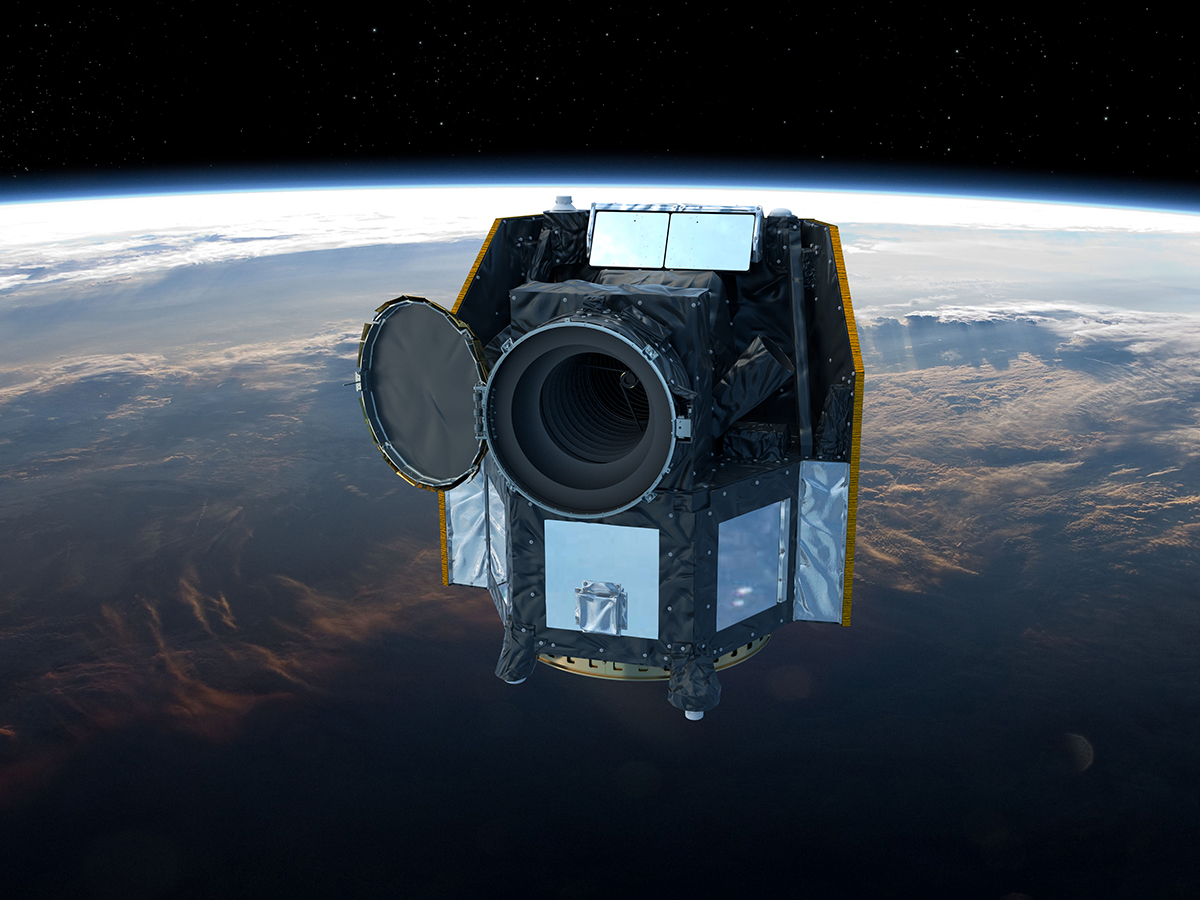
The CHEOPS (CHaracterising ExOPlanets Satellite) spacecraft just opened the cover on its telescope. The spacecraft was launched on December 18th 2019 and has so far performed flawlessly. In one or two weeks we could get our first images from the instrument. CHEOPS is an ESA mission in partnership with Switzerland’s University of Bern. Its mission is not to find exoplanets, but to look more closely at stars with known exoplanets, and to watch as those planets transit in front of their star. It will watch those transits with a keen eye, and will determine the size of those planets with greater accuracy and precision. That will lead to better measurements of their mass, density, and composition.
Arianespace VS23 mission: a Soyuz ST-A launch vehicle launched the COSMO-SkyMed Second Generation satellite (CSG-1), the Characterising Exoplanet Satellite (CHEOPS), as well as OPS-SAT, EyeSat and ANGELS cubesats, from the Soyuz Launch Complex (ELS) in Sinnamary, French Guiana, on 18 December 2019, at 08:54:20 UTC (05:54:20 local time). The COSMO-SkyMed Second Generation satellite is an Earth observation spacecraft launched for the Italian Space Agency (ASI). The Characterising Exoplanet Satellite (CHEOPS) is an ESA mission dedicated to studying bright, nearby stars that already are known to host exoplanets in order to make high-precision observations. OPS-SAT and EyeSat are 3U CubeSats, while ANGELS is a 12U CubeSat. Credit: Arianespace Arianespace VS23 mission Soyuz ST-A launches CSG-1, CHEOPS, OPS-SAT, EyeSat & ANGELS
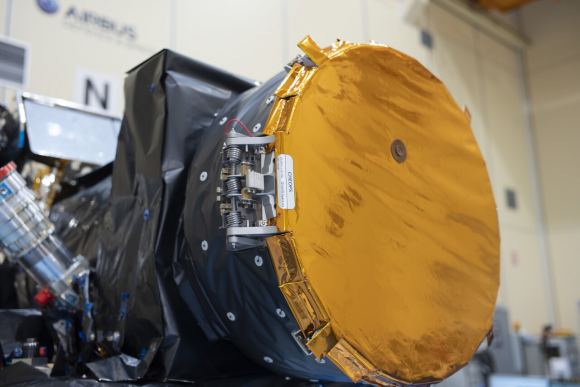
The telescope baffle cover of the Cheops satellite, pictured here during spacecraft testings in the clean room at Airbus Defence and Space Spain, Madrid, protected the mission’s science instrument from dust and bright light during testing, launch and the early phases of in-orbit commissioning. The cover was opened successfully on January 29th. Image Credit: ESA–S. Corvaja
As I’m recording this video near the end of 2019, the total number of confirmed exoplanets stands at 4,104. We’ve come a long way since the discovery of the first exoplanet orbiting a sunlike star back in 1995 with 51 Pegasi b. And the reality is that the race to find new exoplanets is only accelerating. New ground and space-based telescopes are turning up planetary candidates at an increasing rate. New techniques will find planets in entirely new ways. The bottom line is that over the next few decades, this mere 4000ish will multiply by orders of magnitude. So let’s run the clock forward and try to calculate what the future holds for exoplanets. How many worlds will we know about 3 decades from now, in the year 2050? Our Book is out! Audio Podcast version: ITunes: RSS: Sign up to my weekly email newsletter: Support us at:Support us at: Follow us on Tumblr: : More stories at Follow us on Twitter: @universetoday Like us on Facebook: Instagram - Team: Fraser Cain - @fcain / frasercain@gmail.com /Karla Thompson - @karlaii Chad Weber - Chloe Cain - Instagram: @chloegwen2001 Music: Left Spine Down - “X-Ray” References: Exoplanet Vision 2050 (PDF) Financial Technology & Automated Investing Planet 51 Peg b PLATO PLAnetary Transits and Oscillations of stars THE EUROPEAN EXTREMELY LARGE TELESCOPE ("ELT") PROJECT Habitable Exoplanet Observatory (HabEx) Astrometric orbit of a low-mass companion to an ultracool dwarf (Abstract) DETECTING EXOPLANETS WITH ASTROMETRY Theia: Faint objects in motion or the new astrometry frontier
What is ESA’s Characterising Exoplanet Satellite, Cheops, and how will it improve our knowledge of exoplanets? Find out more in this interview with Kate Isaak, ESA Cheops project scientist. More about Cheops: ★ Subscribe:and click twice on the bell button to receive our notifications. Check out our full video catalog: Follow us on Twitter: On Facebook: : On Instagram On Flickr: We are Europe's gateway to space. Our mission is to shape the development of Europe's space capability and ensure that investment in space continues to deliver benefits to the citizens of Europe and the world. Check out to get up to speed on everything space related. Copyright information about our videos is available here:
Animation visualising ESA's CHaracterising ExOPlanet Satellite, Cheops, in orbit above Earth. Cheops will orbit Earth at an altitude of 700 km in a Sun-synchronous orbit riding on the day-night terminator – such a configuration is also called dawn/dusk orbit. This orbit allows Cheops to point its instrument always towards the night side of Earth, in order to limit the impact on the measurements of sunlight and reflected stray light from Earth. To maximize the fraction of the sky where Cheops can perform observations, the instrument can be pointed at any time anywhere in the sky up to 60 degrees from the anti-Sun direction. The satellite will communicate several times per day with the main Cheops ground station located at Torrejón de Ardoz, near Madrid, Spain, in order to downlink the science data and receive telecommands for further operations. Cheops will make observations of exoplanet-hosting stars to measure small changes in their brightness due to the transit of a planet across the star's disc. The information will enable accurate and precise measurements of the sizes of the orbiting planets to be made. Cheops will target stars hosting planets in the super-Earth to Neptune size range. By combining sizes with existing measurements of the planet masses, Cheops will provide an estimate of bulk density – a first step towards characterising planets outside our Solar System. Note: Some aspects have been simplified for the purpose of this animation. Credit: ESA/ATG medialab
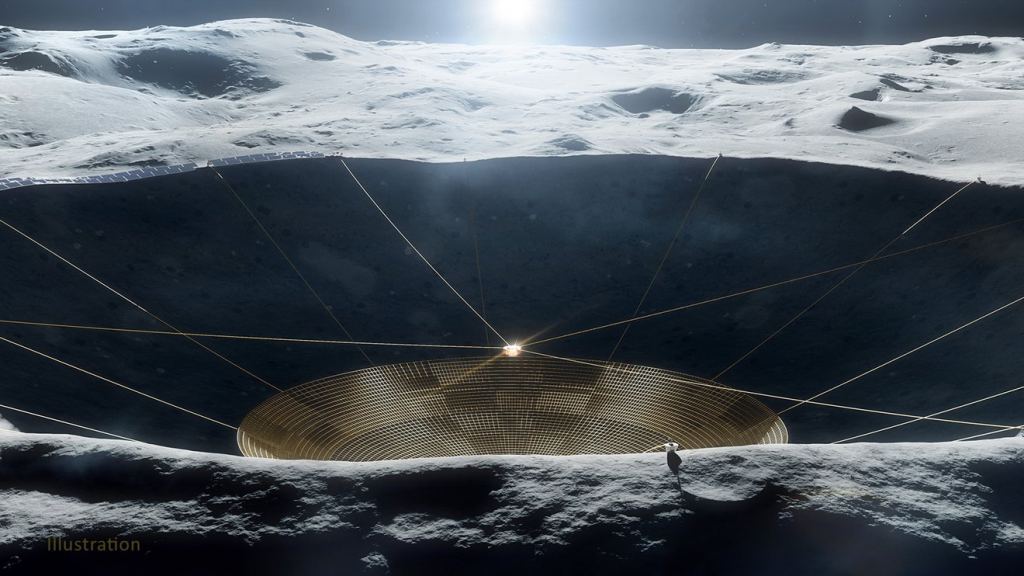
NASA is currently studying how we might build a radio telescope on the Moon. If it is built in the coming decades, we might finally see the aurora glow of a distant Earth. It’s difficult to do radio astronomy on Earth, and it’s getting harder every day. Our everyday reliance on radio technology means that radio interference is a constant challenge, even in remote areas. And for some wavelengths even the Earth’s atmosphere is a problem, absorbing or scattering radio light so that Earth-based telescopes can’t observe these wavelengths well. To overcome these challenges, astronomers have proposed putting a radio telescope on the far side of the Moon.
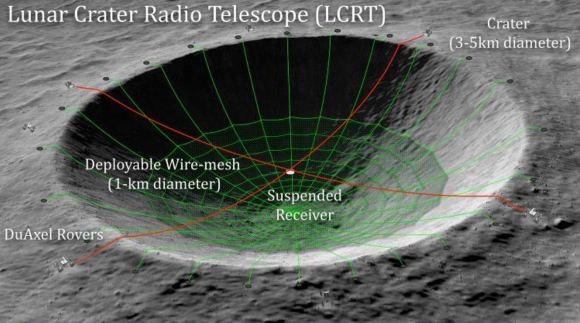
Proposed design of a radio telescope in a lunar crater. Credit: Saptarshi Bandyopadhyay
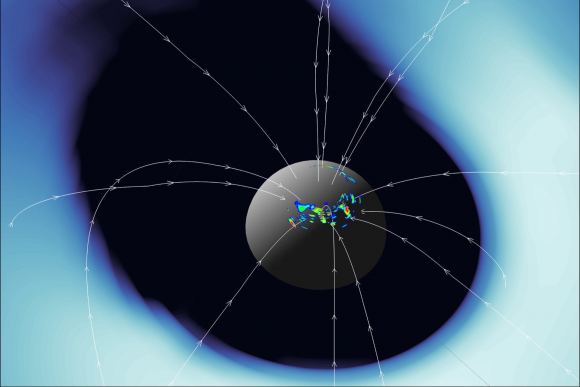
Simulation of aurora on an exoplanet. Credit: Anthony Sciola
<
Whether these different organisations want to land astronauts, install a human outpost or mine minerals and make rocket fuel on the moon, it still lacks an exceptional and important asset-- A lunar radio Telescope. Why? Because this development will be uniquely poised to answer one of humanity’s greatest questions: What is our cosmic origin? - - Subscribe for more videos ► Business Enquiries ► - - All the lunar missions that are being planned along with all other missions that different organizations want to accomplish, will be of no use if we don’t seek answers to fundamental questions like “what is the universe made up of? What are we made up of?” And a telescope on the far side of the moon will help us answer these important questions!! So let’s take a look at why this is important and what NASA is planning to do about it. As mentioned earlier the universe constantly beams its history to us. For instance, the information of what happened long ago in the universe is contained in the long length radio waves that are present everywhere throughout the universe and most likely hold the details about how the first black holes and stars were formed. But there’s a problem. Our noisy radio signals and our atmosphere block these signals from coming to the earth and we can’t read them. The far side of the moon is the best place in the inner solar system to monitor these low-frequency radio waves and help us in detecting certain faint ‘fingerprints’ that the big bang left on the cosmos. The problem with our earth bound telescopes is that they encounter too much interference for electromagnetic pollution caused by human activity, whether it is short-wave broadcasting or maritime communication. On the top of that our ionosphere blocks the longest wavelengths from reaching our earth-based telescopes in the first place. We need these signals to understand and learn whether our universe inflated rapidly in the first trillionth of a trillionth of second after the big bang. This is the reason why NASA is in the early stages of planning what it would take to build an automated research telescope on the dark side of the moon. One of the most ambitious proposals is to build the Lunar Crater radio telescope or the LCRT - - "If You happen to see any content that is yours, and we didn't give credit in the right manner please let us know at Lorenzovareseaziendale@gmail.com and we will correct it immediately" "Some of our visual content is under an Attribution-ShareAlike license. in its different versions such as 1.0, 2.0, 3,0, and 4.0 – permitting commercial sharing with attribution given in each picture accordingly in the video." Credits: Ron Miller Credits: Mark A. Garlick / MarkGarlick.com Credits: Nasa/Shutterstock/Storyblocks/Elon Musk/SpaceX/ESA/ESO Credits: Flickr #InsaneCuriosity #Telescopes #Moon
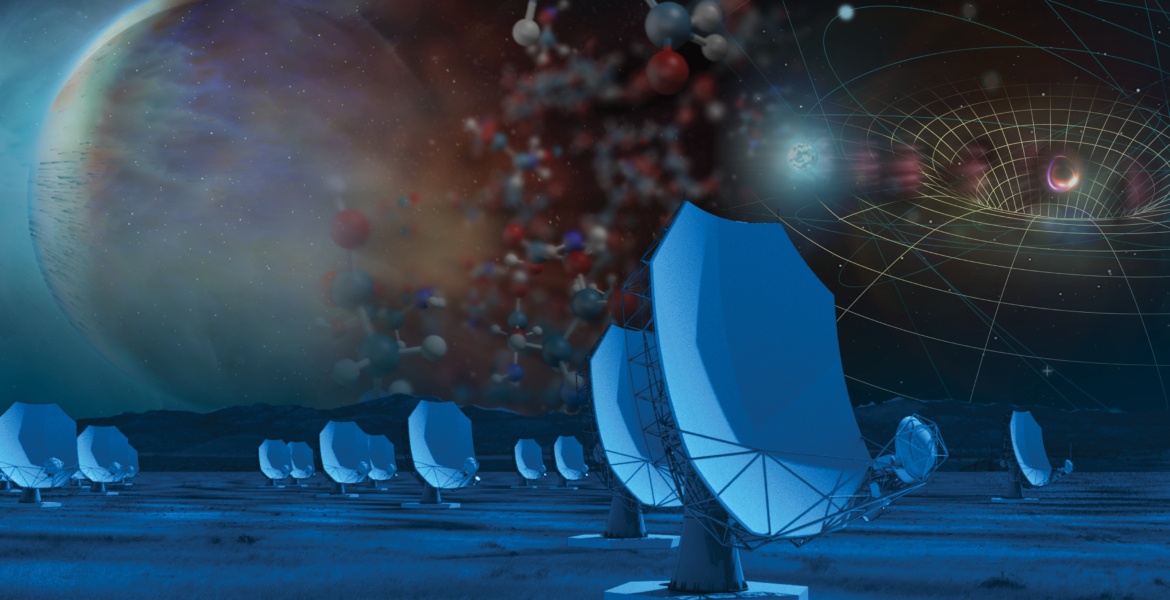
Artists’s conception of the central portion of the Next Generation Very Large Array. Credit: Sophia Dagnello, NRAO/AUI/NSF
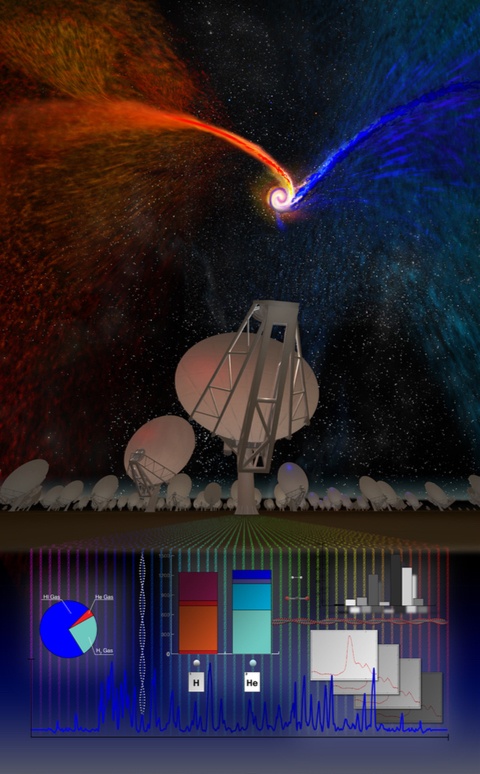
Science has driven the design of the ngVLA. This “Galaxy Assembly Through Cosmic Time” is a sketch by NRAO Artist/Illustrator Bill Saxton. Credit: Bill Saxton, NRAO/AUI/NSF
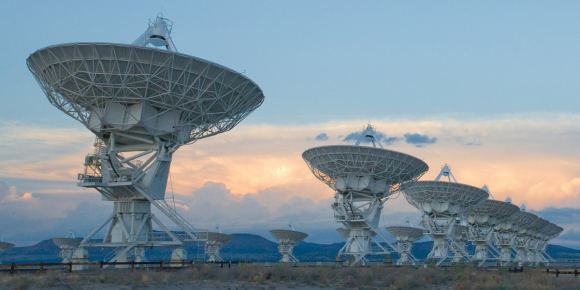
The Karl G. Jansky Very Large Array, located in central New Mexico. Credit: NRAO
The Astro 2020 describes the new array as a facility that “would be absolutely unique worldwide in both sensitivity and frequency coverage,” and concludes that “It is of essential importance to astronomy that the VLA and Very Long Baseline Array be replaced by an observatory that can achieve roughly an order of magnitude improvement in sensitivity compared to these facilities, with the ability to image radio sources on scales of arcminutes to fractions of a milliarcsecond.”
The Next Generation Very Large Array – ngVLA